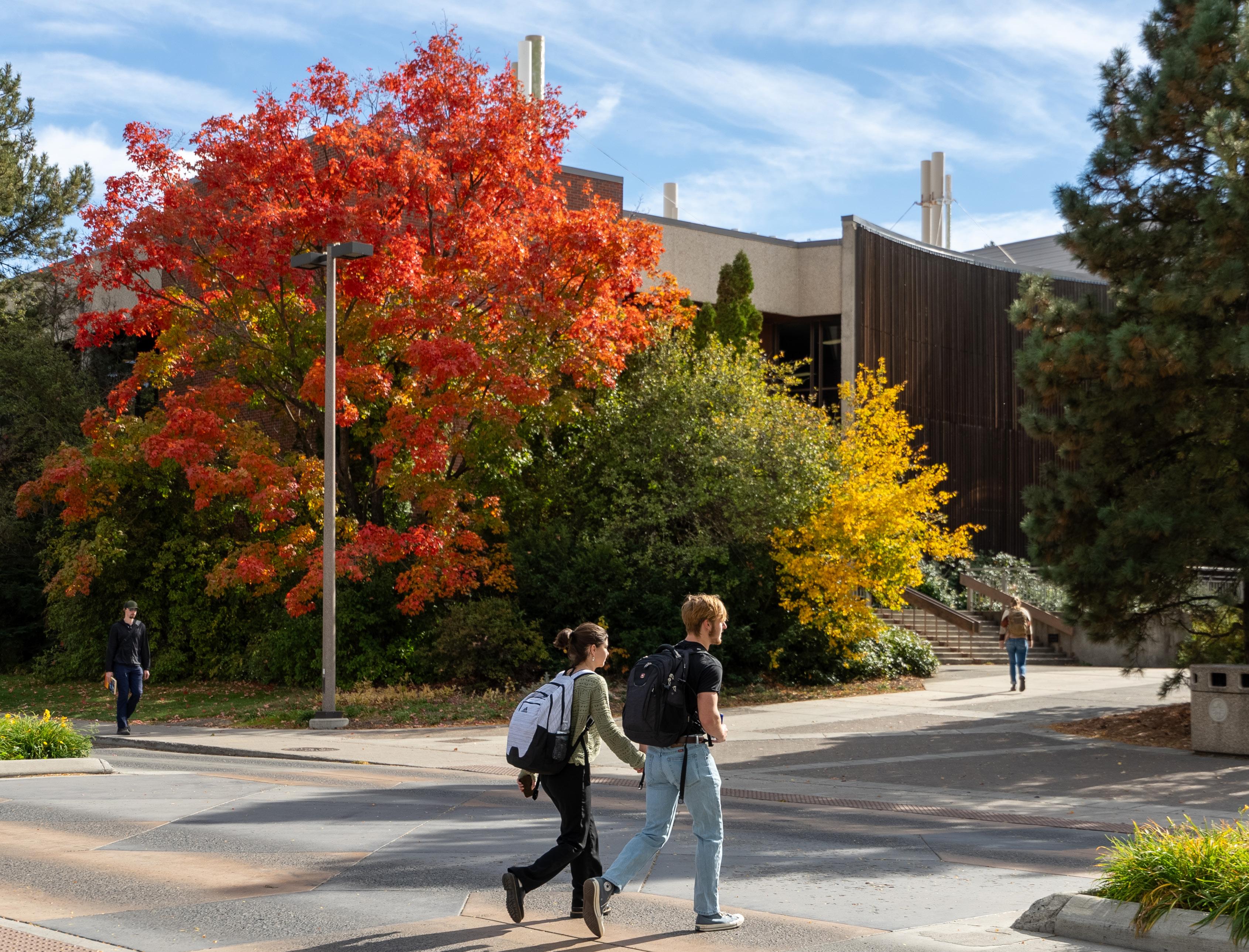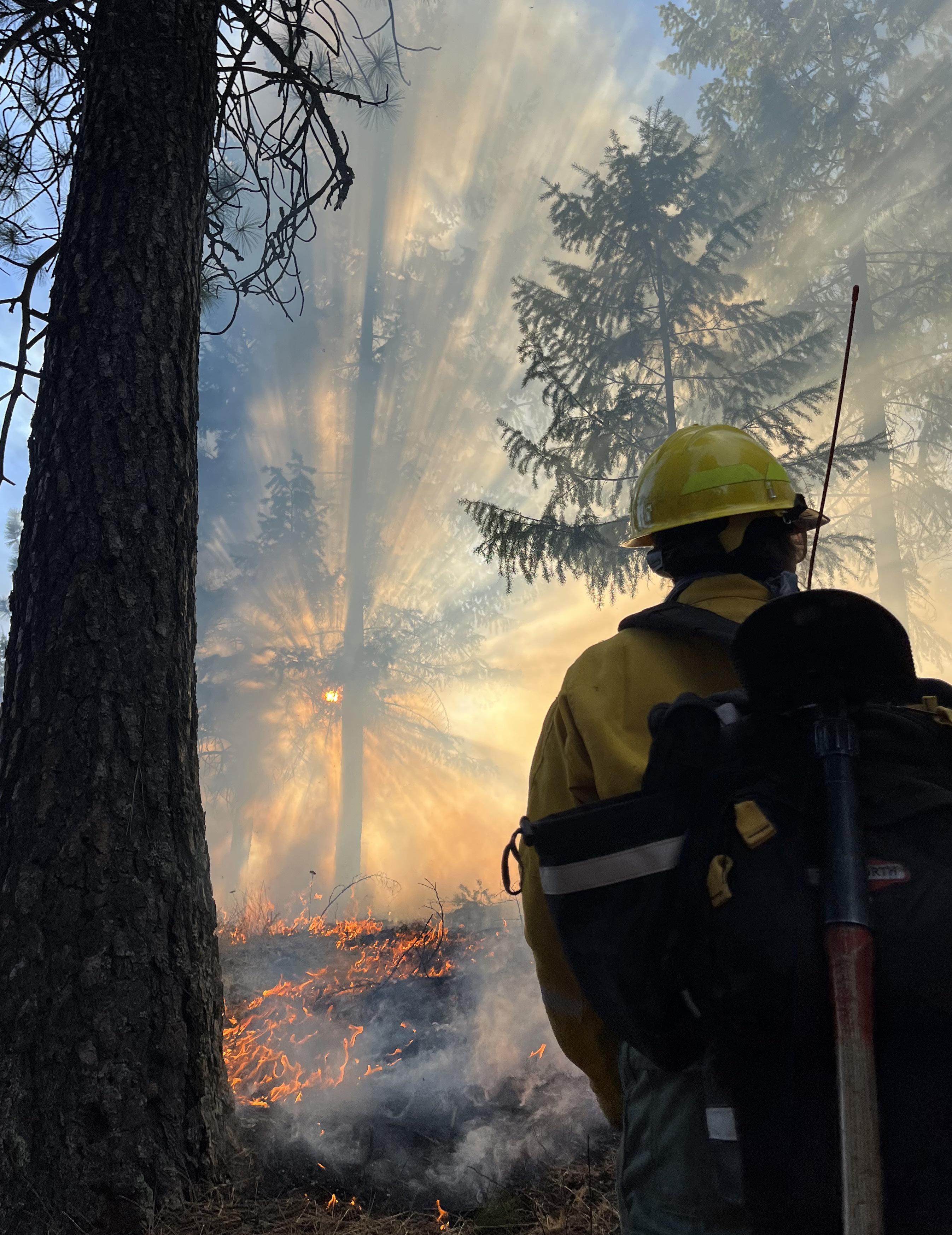

Immersed in flames
U of I program empowers artists to explore the elemental power of the West
CONTENTS
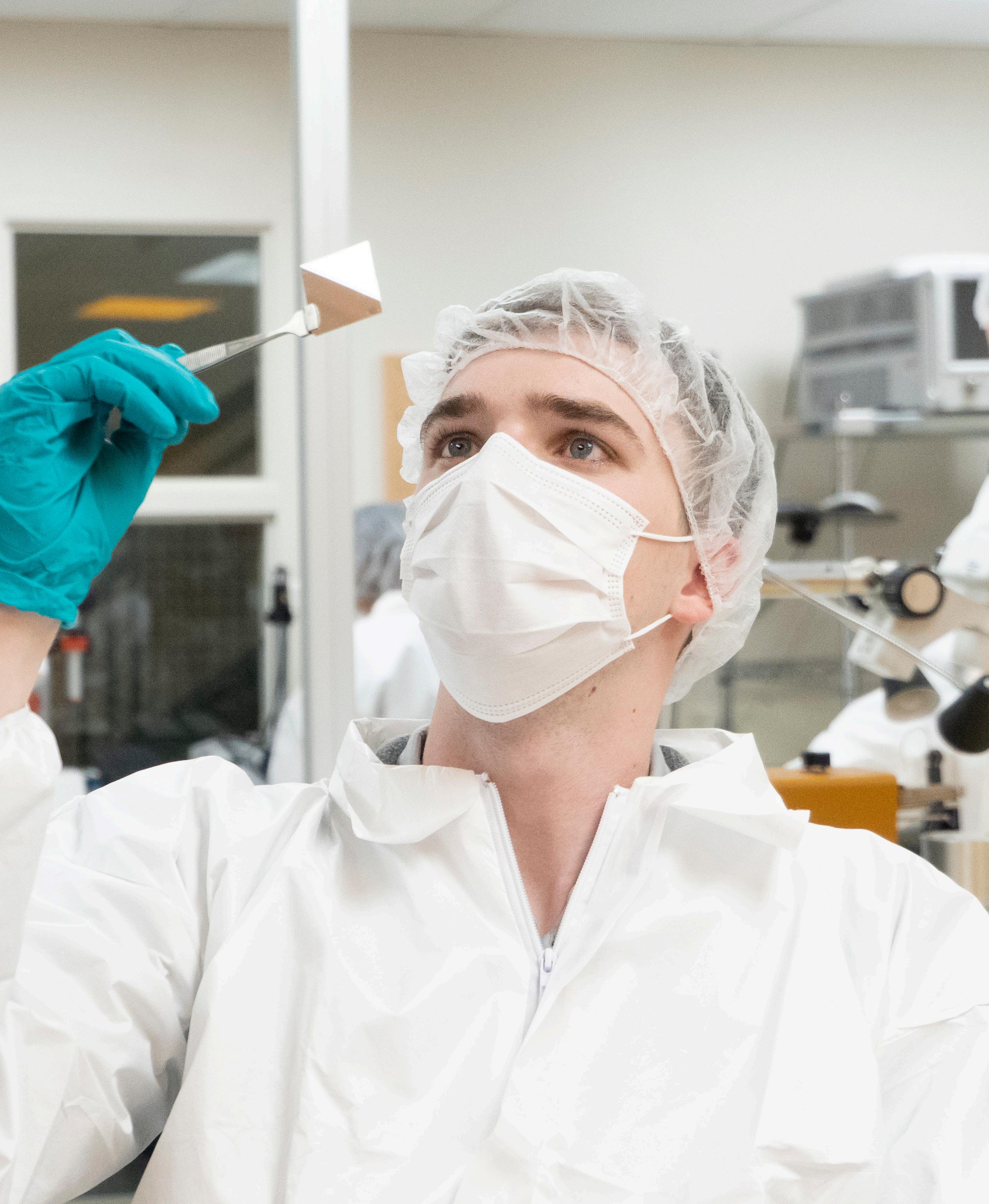
A student examines a microelectronic device — part of U of I field-based training to prepare future leaders in the semiconductor industry.
HWHI F 25
Photo by Melissa Hartley
12
INSIDE
THE LAB LAUNCHING
IDAHO’S NEXT TECH TALENT
Through real-world practice, U of I is partnering with industry leader Micron to build a skilled semiconductor workforce and power Idaho’s growing tech economy.
6
DATA-DRIVEN DEFENSE
Invasive mussels threaten Idaho’s lakes and rivers—but U of I researchers are fighting back. Using predictive models, they’re helping stop infestations before they start.
9
ENGINEERING A BETTER HARVEST
A U of I project explores using locally sourced biochar to help farmers reduce runoff, retain nutrients and increase yields.
16
FROM FIRE TO RAPIDS
Turning a passion for the outdoors into leadership, a student guides rafting trips, earns emergency certifications and becomes an EMT — all while pursuing her degree.
20
RAISING THE BAR WITH CAVIAR
U of I scientists are boosting Idaho’s caviar industry with research in nutrition, genetics and egg quality, enhancing the state’s world-class reputation for white sturgeon caviar.
PREDICTING PATHOGEN PATTERNS
A student leverages AI and meteorological data to pioneer a novel method for predicting disease outbreaks.
A participant in U of I’s Confluence Lab project, where art and science meet, observes a prescribed burn to explore the role of fire in Western landscapes.
24
BUILDING BELONGING
A passionate educator finds purpose and inspiration through mentorship during her journey from student to teacher.
The Vandal Family is the secret to U of I’s record-breaking fundraising success in the largest philanthropic campaign in state history.
A DOSE OF INNOVATION
An AI-driven pill dispenser born in a U of I classroom could help save lives.
SHAPING IDAHO’S LANDSCAPE
For more than 100 years, the College of Natural Resources has trained professionals, advanced research and strengthened Idaho’s natural resource industries. 36
CULTIVATING JUSTICE
A student-led clinic provides veterans with legal aid while shaping the professional and personal growth of future attorneys. 38
BURNING FOR THE STORY
Through a U of I program, an MFA student experiences wildfire training to enhance the authenticity of her fiction writing.
the fall colors.
Photo by Jennifer Yu
Students stroll through campus enjoying
Photo by University of Idaho Visual Productions
For 135 years, the University of Idaho has stood as a beacon of innovation, resilience and service — fulfilling its land-grant mission with unwavering dedication. As Idaho continues to evolve, so too does our role in shaping its future. Through groundbreaking research, dynamic workforce development and wide-ranging outreach, we remain a vital force in driving the state’s growth and prosperity — opening doors to discovery, opportunity and a brighter tomorrow for all Idahoans.
In this issue of Here We Have Idaho, explore how Vandals are teaming up with businesses and organizations to take on the state’s vexing challenges and design bold, forward-thinking solutions that improve lives. Whether in hospitals, courtrooms, farms or forests, Vandals are building a stronger tomorrow for all of us.
Ismael Valadez and Austen Reagan, inspired by their families’ struggles with medication management, created Medi-Mate — a smart device that uses AI and facial recognition to dispense up to a month’s supply of eight medications on schedule. The fraternity brother inventors pitched Medi-Mate to regional health care professionals and are working to secure financing to manufacture the devices.
Invasive quagga and zebra mussels threaten Idaho’s waterways. Katie Theissen, a National Merit Scholar, uses transportation data to pinpoint at-risk lakes, rivers and reservoirs. Her predictive models could play a key role in safeguarding one of Idaho’s most treasured natural assets.
U of I law students provide free legal support to regional veterans through university-affiliated clinics. The program delivers critical services to those who served and prepares students for the possibility of public service in their legal careers.
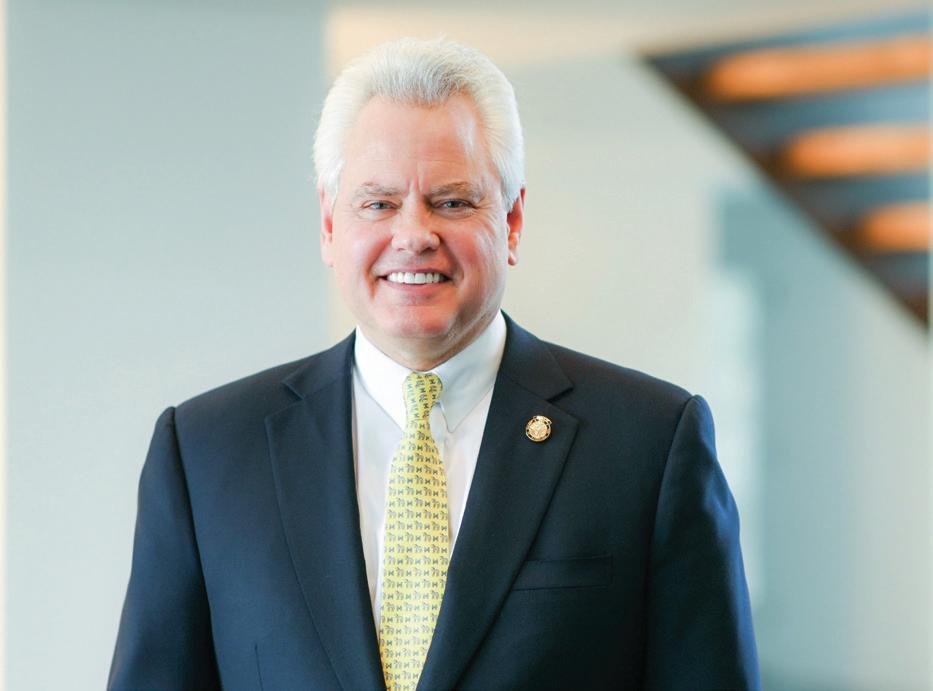
The rolling Palouse hills serve as testing grounds for a cross-college experiment with biochar. The material, derived from wood waste, could help prevent erosion, improve soil conditions and ultimately boost farm productivity across the region.
Micron and the U of I continue to collaborate in preparing the next generation of microchip and semiconductor experts. Through immersive projects — like designing solar panel chips — students gain industry-ready skills that prepare them to lead in this fast-growing field.
Also in this issue, you’ll discover inspiring stories of community collaboration and student achievement that showcase how a U of I education equips learners to lead, innovate and thrive in tomorrow’s Idaho.
We’re also proud to share the resounding success of our Brave. Bold. Unstoppable. campaign. The Vandal Family came together to exceed our campaign goal of $500 million — and we still have two months to go. We will celebrate the largest fundraising effort in state history into 2026.
We appreciate all our partners across Idaho and the nation who support our students and invest in our shared future. U of I students and faculty members take on tough challenges, find solutions and continually strive to make Idaho even better for everyone.
Go Vandals!
Sincerely,
C. Scott Green ’84 President

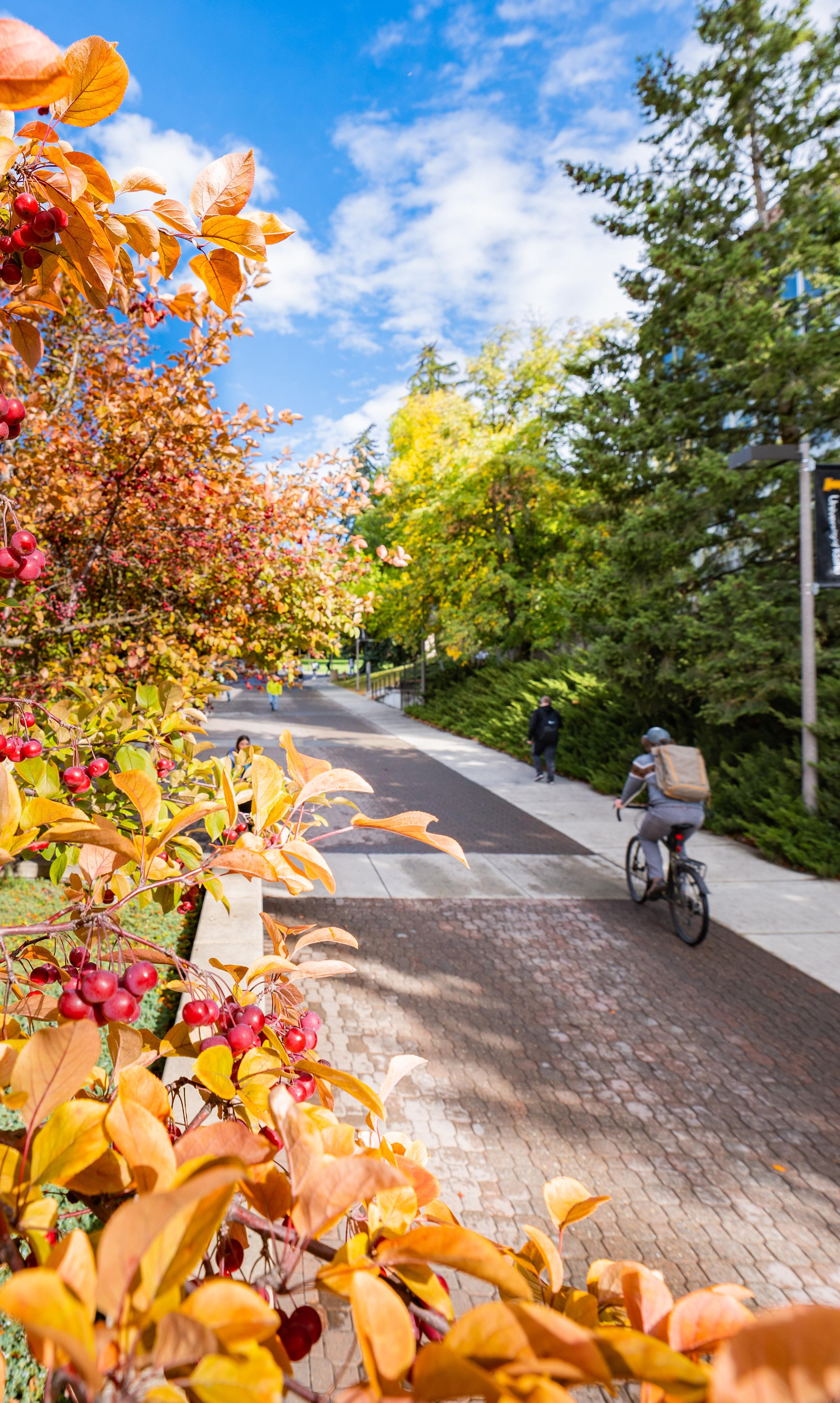
Campus walkway in the fall.
Here We Have Idaho
The University of Idaho magazine Fall ʼ25
President C. Scott Green ’84
Co-chief marketing officers
John Barnhart
Jodi Walker
Alumni association president
Jackie Jameson ’08
Foundation chair
Clint Marshall ’97
Foundation CEO
Ben McLuen
Managing editor
Jodi Walker
Layout/design
Karla Scharbach ’87
Editor Joy Bauer ’98
Writers and contributors
Ralph Bartholdt
David Jackson ’93
Danae Lenz
John O’Connell
Chris Paige
Michelle Reagan
Megan Snodgrass
Alexiss Turner ’09
Photography
Idaho Visual Productions
Garrett Britton
Melissa Hartley
Arielle Bennett
Joe Pallen ’96
Richard Pathomsiri
Bill Schaefer
Jennifer Yu
For detailed information about federal funding for programs mentioned in this magazine, see the online version of the relevant story at uidaho.edu/ui/currenthwhi-magazine.
University of Idaho is an equal opportunity, affirmative action employer and educational institution.
© 2025, University of Idaho
Here We Have Idaho magazine is published twice per year. The magazine is free to alumni and friends of the university. University of Idaho has a policy of sending one magazine per address. To update your address, visit uidaho.edu/alumni/get-involved or email alumni@uidaho.edu. Contact the editor at UIdahoMagazine@uidaho.edu.
Photo by Joe Pallen ’96
Here are some shining examples of U of I’s impact and excellence.
Read more articles at uidaho.edu/newsroom or follow University of Idaho on FACEBOOK, INSTAGRAM and X
8 O YEARS

since the first broadcast of KUOI, U of I’s student-run free-form radio station, on Oct. 29, 1945.
Top 4%
Only 187 of the 5,916 higher education institutions nationwide have earned the prestigious Carnegie R1 status, placing U of I among the top 4% of U.S. research universities.
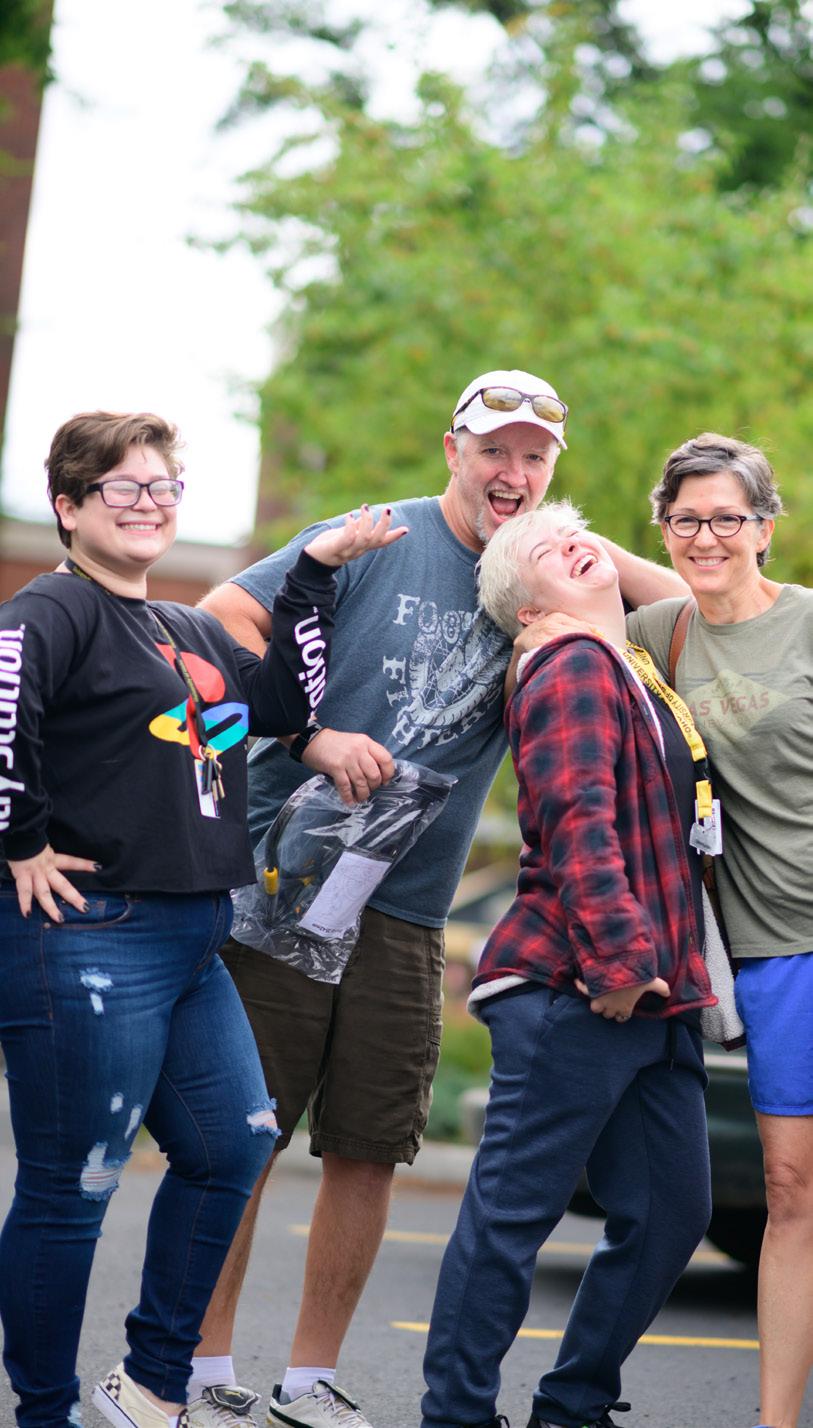
No.
1
U of I’s Residence Hall Association was named 2025 School of the Year by the National Association of College and University Residence Halls, ranking it first among 400+ North American institutions.
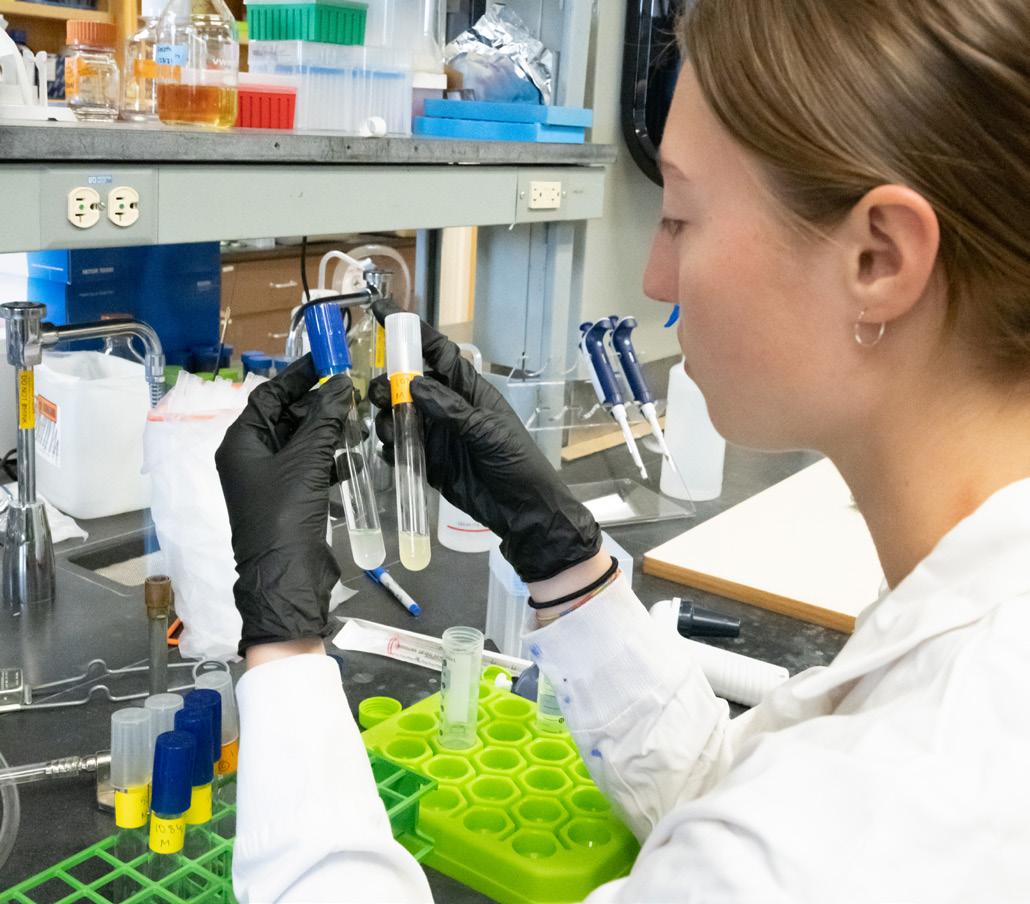
U of I scientists are recognized in the prestigious Stanford-Elsevier Top 2% Scientists List, more than all other Idaho research institutions and Idaho National Laboratory combined.
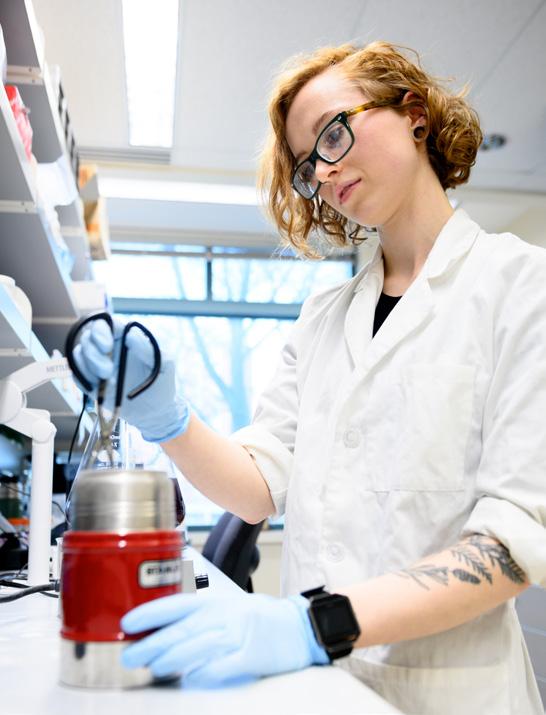
>1/2
More than half of undergraduate students participate in research at U of I.
$1.28M
Amount donors gave during April’s Vandal Giving Day, beating the previous year’s record by almost $153,000. Thank you, Vandal Family!
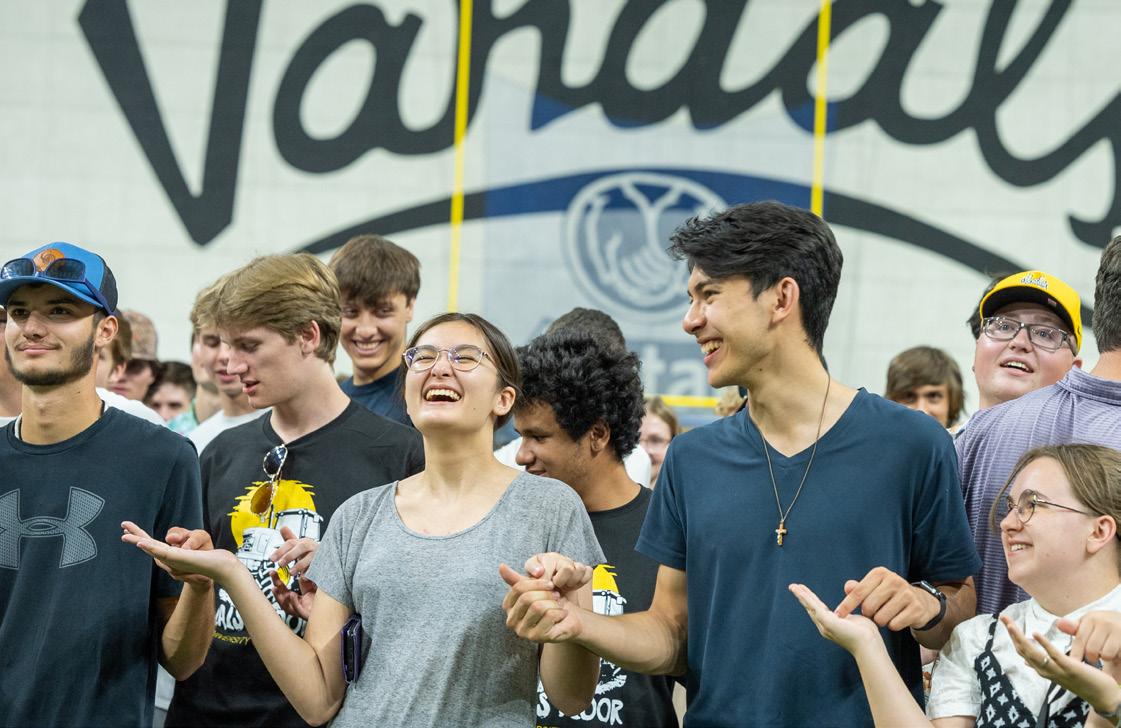
9
consecutive semesters of enrollment growth as of Fall 2025.
No.1
U of I was named Idaho’s top midsize employer and in the top 30 of 500 organizations nationwide in Forbes’ 2025 Best Employers list.
3,326
Vandals earned a spot on the Fall 2024 Dean’s List. This requires a 3.5 GPA on a minimum of 12 graded credits.
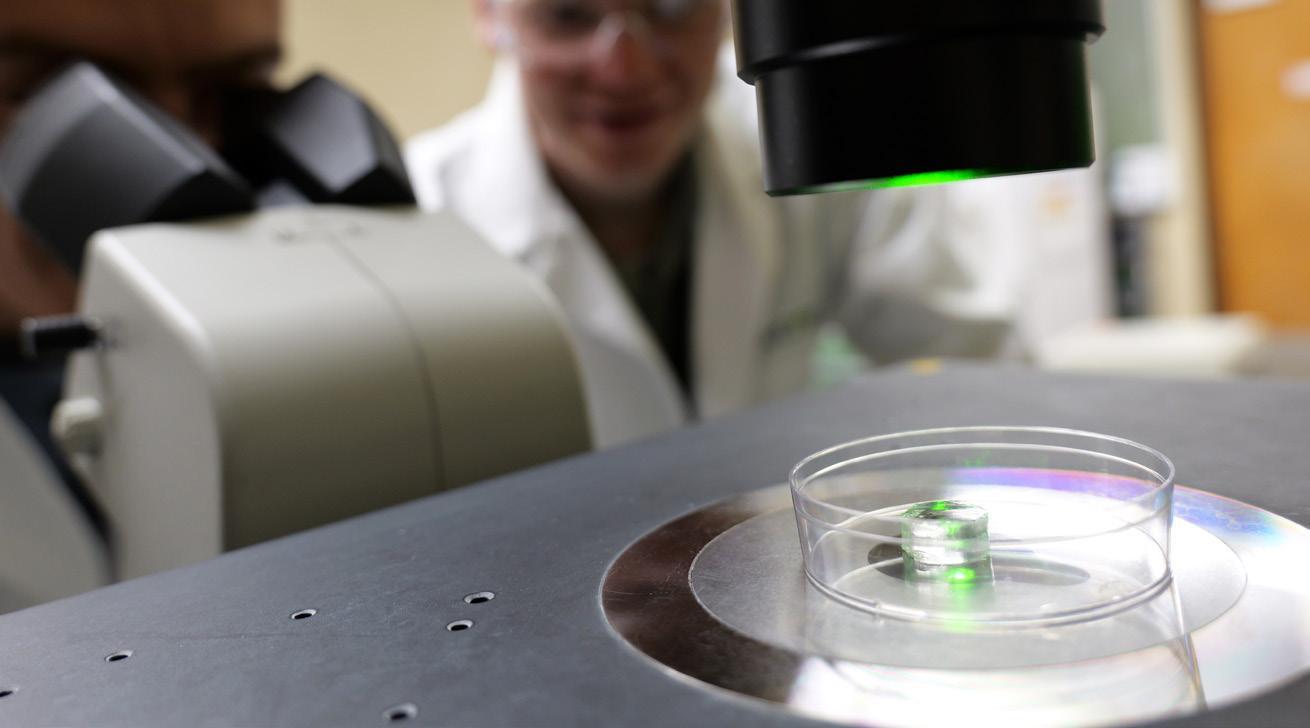
$598K
Grant to understand tendon tissue formation to ultimately engineer tendon tissue replacements. (See page 18)
$2.7 billion
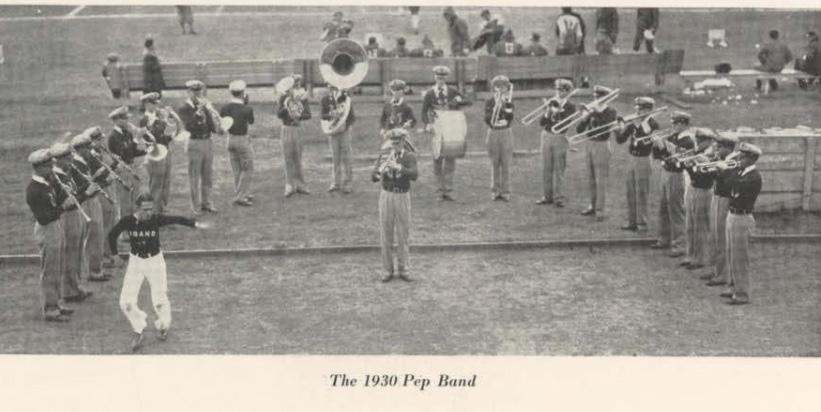
in annual economic output generated by U of I, according to a recent economic impact report.
95 years
since the “Go, Vandals, Go” fight song was composed by freshman J.M. “Morey” O’Donnell in 1930.
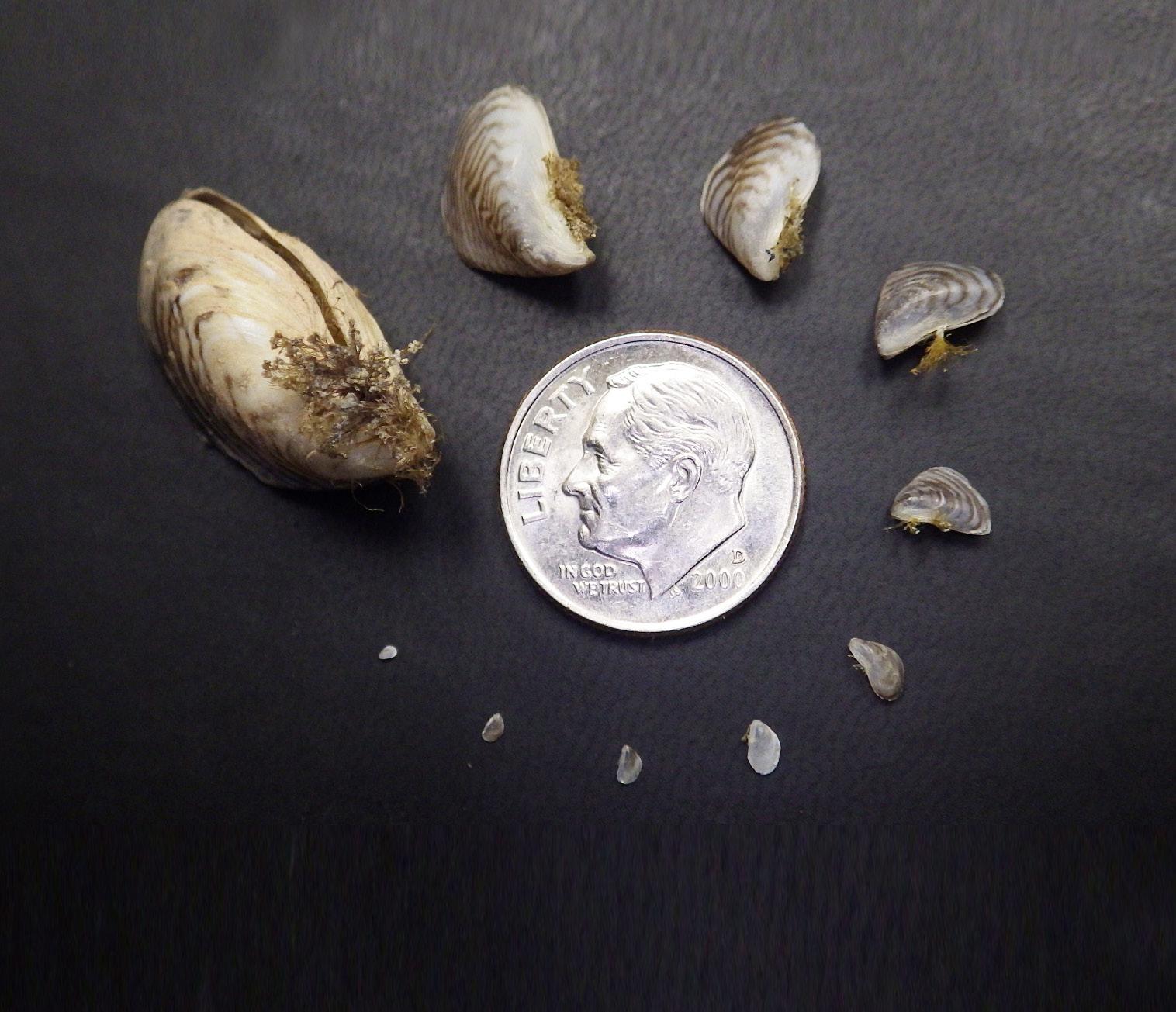
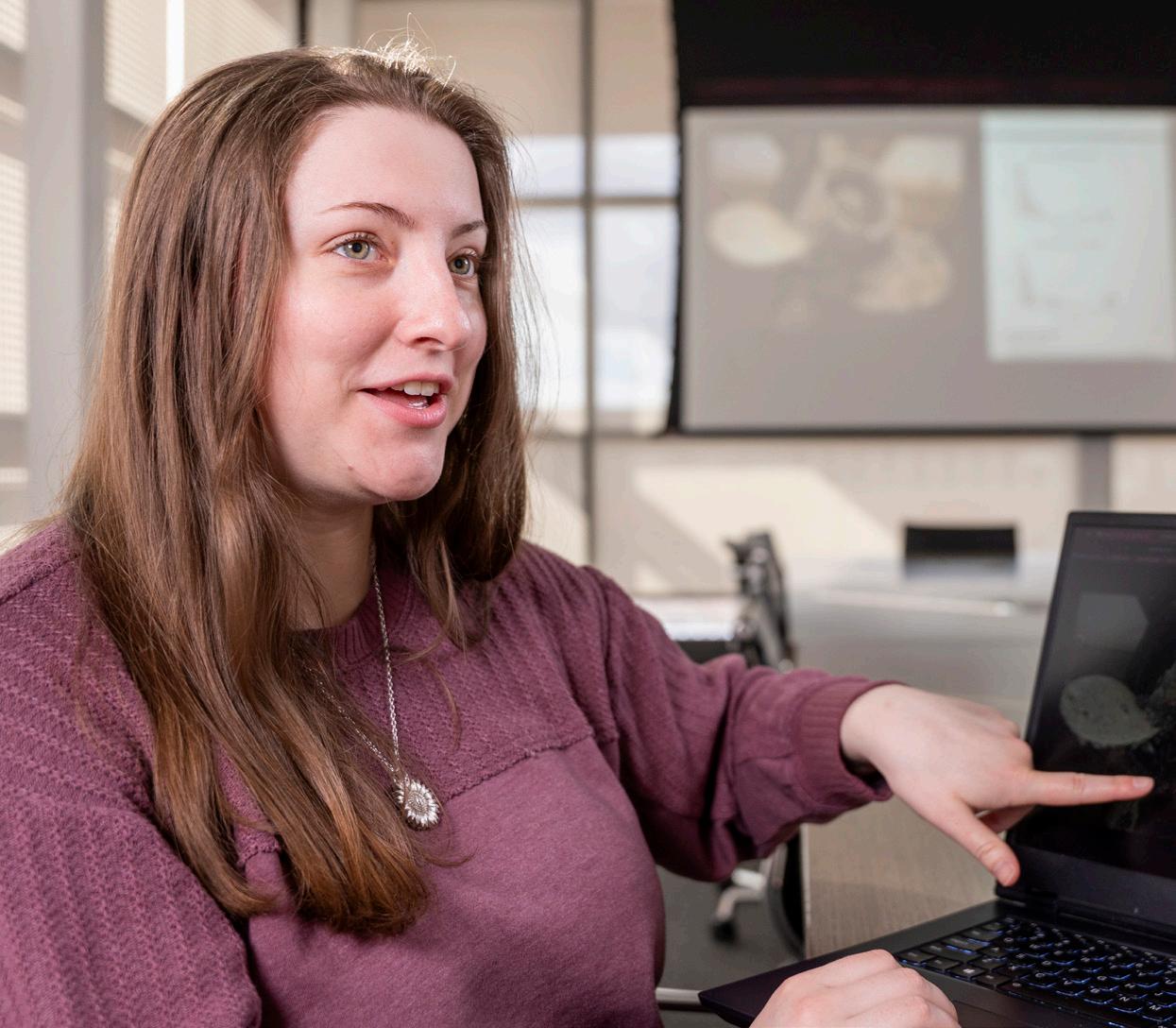
DATADRIVEN DEFENSE
Merit scholar models how watercraft traffic could spread aquatic invaders to Idaho lakes and rivers
Story by Ralph Bartholdt
Photos by Melissa Hartley and the Idaho State Department of Agriculture
Katie Theissen, a math student at U of I, enrolled to pursue undergraduate research. For the past two years, she’s analyzed data for a biology project studying how invasive mussels might enter Idaho waterways via boats and trailers.
Invasive species are non-native plants or animals that harm the environment, take a toll on the economy and can hurt humans.
As Katie Theissen has learned, invasives are nothing to clam up about.
Theissen ’25 arrived at University of Idaho from Missouri on a National Merit Scholarship and spent the last two years tracking how quagga and zebra mussels — invasive freshwater shellfish also known as dreissenid mussels — travel across the U.S. to Idaho waterways.
“Wherever these mussels are found in the U.S., they are always a huge problem,” Theissen said. “I never really knew about these mussels until I got here and learned how important it is to prevent the spread of dreissenids into Idaho’s lakes and streams.”
Quagga and zebra mussels, originally from Eurasia, disrupt native fish populations by filtering out the plankton necessary to feed young fish. They overwhelm aquatic ecosystems, outcompete native species and produce waste that lowers oxygen and pH levels, making water acidic. They also clog industrial and commercial water filtering systems and damage boat motors.
Theissen’s research became more urgent after a small number of quagga mussels were detected in the Snake River near Twin Falls in 2024.
After arriving at U of I, Theissen, who graduated in Spring ’25 with a bachelor’s in mathematics, earned a Hill Undergraduate Research Fellowship and the opportunity to work on the dreissenid mussel project. She used data collected at highway
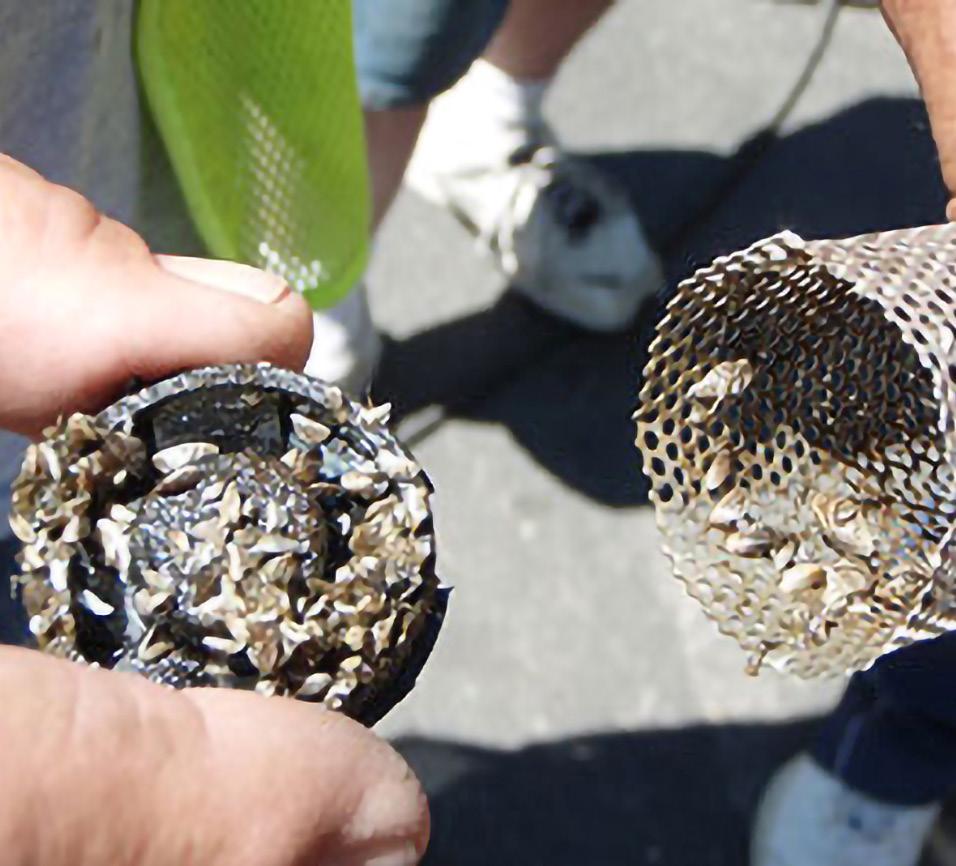
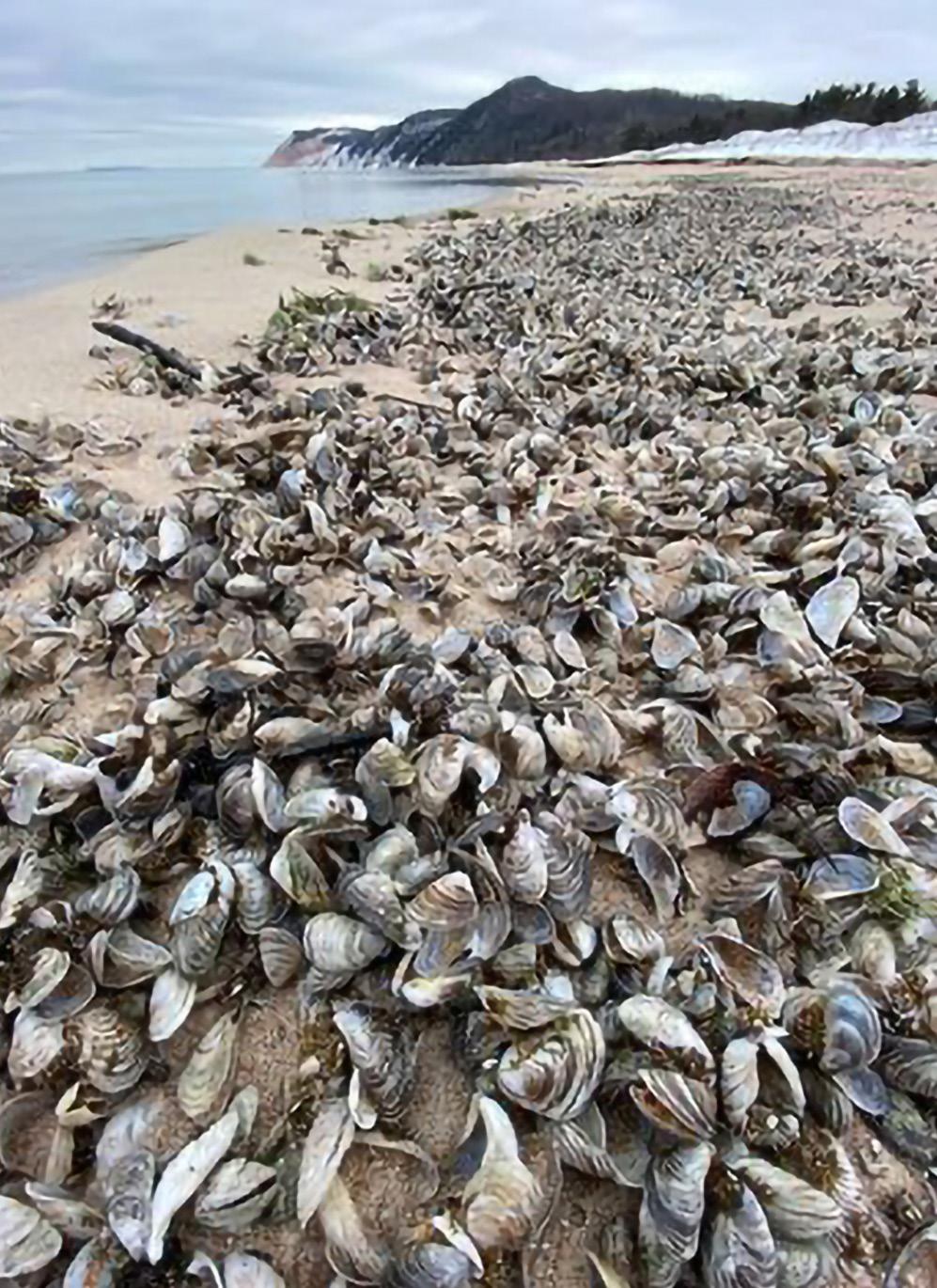
checkpoints to project which Idaho water bodies face the highest risk from infested watercraft.
Working with Professor Jennifer Johnson-Leung in the math department and James Nagler, professor of zoology, Theissen analyzed data collected by the Idaho State Department of Agriculture (ISDA). The data tracks vehicles towing or carrying a watercraft — everything from paddleboards to motorboats — as they travel in, and through, Idaho, and includes lakes motorists have previously visited.
Watercraft are required to stop at the inspection stations and, if mussels are suspected, the boats are given a hot wash to kill mussels and their offspring.
“The goal of this research is to use as many data points as we can to create a ranking of at-risk waterways in Idaho and a list of which waterways, such as lakes, rivers and reservoirs, could cause subsequent infestations,” Theissen said.
When she joined the research team, Theissen was unaware of the impact her data analysis could have.
“I would argue that dreissenid mussels are at the top of the invasive animal species list for environmental damage and economic cost in the U.S. and Canada,”
Quagga and zebra mussels, called dreissenid mussles by scientists, clog industrial and commercial water filtering systems.
Quagga and zebra mussels, originally from Eurasia, overwhelm aquatic ecosystems by outcompeting native species.
Nagler said. “Katie’s research is the first to model how invasive mussels could spread in an uninfected region by watercraft traffic, which is the principal vector for their slow movement across the continent.”
ISDA Invasive Species Bureau Chief Nic Zurfluh ’11 said knowing where boats come from and where they are going helps the agency better understand which of Idaho’s waterways could be in jeopardy.
“I
would argue that dreissenid mussels are at the top of the invasive animal species list for environmental damage and economic cost in the U.S. and Canada.”
—JAMES NAGLER, PROFESSOR OF ZOOLOGY
“Watercraft inspection stations are Idaho’s first line of defense against invasive species that threaten our waterways, economy and way of life,” Zurfluh said. “Stopping at these stations is not just required, it’s a vital step boaters must take to help prevent the costly spread of invasive species like quagga mussels.”
Encouraged by a high school counselor, Thiessen discovered U of I and was drawn to its close-knit community and the small-town feel of Moscow. She wasn’t just seeking research opportunities, but also a place that felt familiar.
“It reminded me of a town outside of St. Louis where I spent childhood summers at my grandparents’ house,” she said. “It felt like a comfortable and safe community, and it offered a lot of opportunity as the state’s premier research university.”
Theissen presented her mussel-related research at two conferences: the Office of Undergraduate Research Symposium and the MAA MathFest in Indianapolis. She looks forward to publishing her findings in a journal.
“We are working on writing a paper, so hopefully we’ll get that published,” she said. “And we are working on refining our model to include more Western states.”
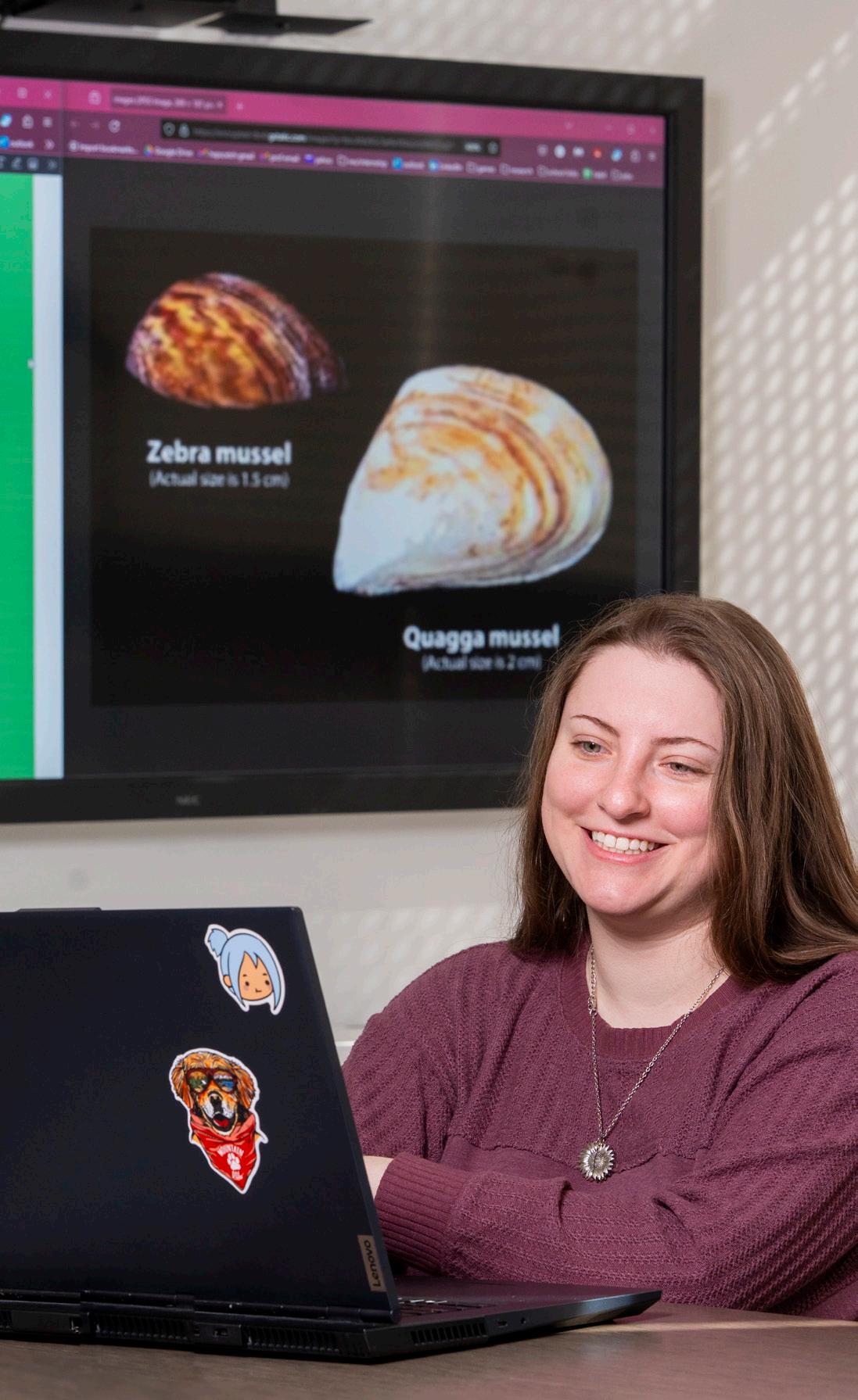
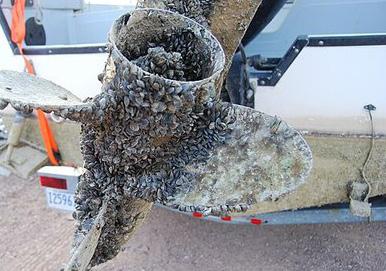
Theissen combined math and biology in her research to address a realworld issue affecting Idaho’s water.
Research modeled how invasive mussels could spread into unaffected regions through watercraft traffic.
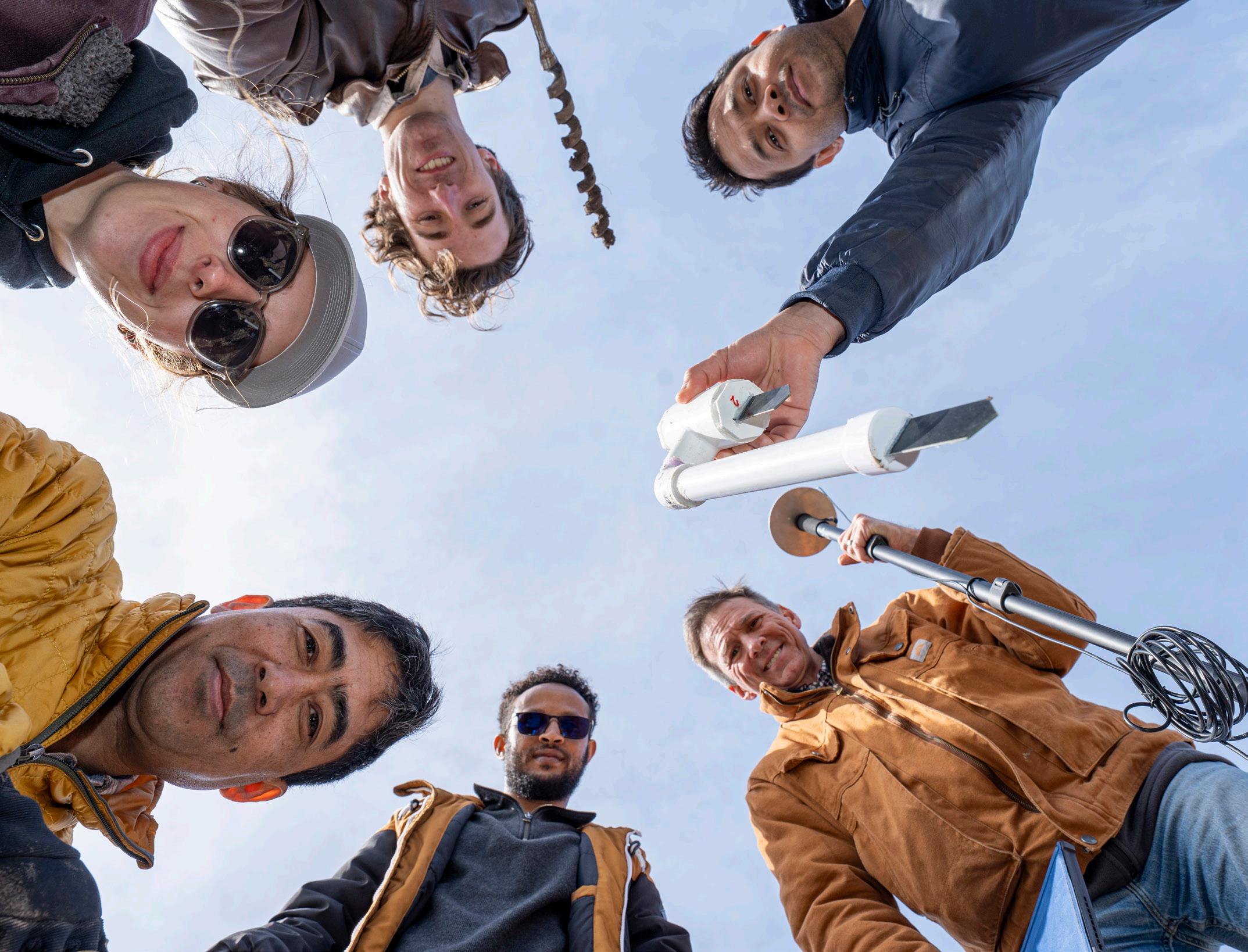
ENGINEERING A BETTER HARVEST
U of I researcher combines farm roots and science to fight erosion
Story by Ralph Bartholdt
Photos by Melissa Hartley
On Driscoll Ridge south of Troy, Jaycee Johnson learned about farming while sitting in the buddy seat of her father’s combine.
As they bumped along a rolling Palouse farm field kicking up dust, Johnson heard about erosion, soil moisture, yield and plant nutrients.
“I’d be sitting next to him in the cab of the combine, and you can just see as you’re going over a hillside where the yield is lower, and when you get into the draw, you have a much higher yield,” Johnson recalls. “My dad was always very talkative and would tell me why this was happening, educating me about it.”
Hillside plants struggled because runoff eroded the soil, carrying nutrients to the valleys where crops thrived.
“My grandpa talked about the erosion; my dad talks about it — he’s been farming here for 40 years,” she said. “We definitely chatted about that quite a bit.”
U of I researchers are studying how biochar could improve crop yield on the Palouse. Clockwise from top left: doctoral student Jaycee Johnson, tech staff Milo Flint, lab coordinator Anup Tuladhar, Associate Professor Russ Qualls, doctoral student Robel Alemayehu and Professor Dev Shrestha.
Johnson, a U of I doctoral student in biological engineering, is applying her farm experience to help boost yields on the Palouse.
Under Professor Dev Shrestha, Johnson is helping study how adding biochar to fields can reduce runoff and boost soil moisture on Palouse hillsides prone to erosion by wind, rain and snowmelt.
Basics of biochar
Biochar, a byproduct of farming and logging, is made by superheating leftover wheat stalks, chaff and wood slash until they disintegrate but haven’t yet turned to ash, Shrestha said. Biochar has been used in gardening to increase soil moisture, but it’s expensive.
Because the ingredients to make biochar are readily available in the Northwest, Shrestha sees potential for a regional, low-cost biochar industry.
“Right now, it’s very expensive to apply at farm scale,” he said. “But in the surrounding area and
regionally, there are millions of tons of wood waste with very low to no market value. That wood waste can be turned into biochar to make a low-cost soil enhancement. Eventually, I’m hoping we can establish an industry here where the lumber mills can turn their wood waste into biochar.”
Lab studies show biochar improves soil moisture by increasing porosity and providing surfaces that retain water. Biochar’s large surface area and porous structure help soil retain more water per volume.
If farmers had an affordable product that could be applied to the least productive, highly eroded portions of their fields, they could boost yields, reduce fertilizer costs and farm more sustainably, Shrestha said.
His team of students and faculty members from the College of Agricultural and Life Sciences installed nearly 300 underground soil sensors to various slopes in an agricultural field south of Moscow to monitor moisture. After a season of data collection, biochar will be applied to the same fields to measure its impact on soil moisture.
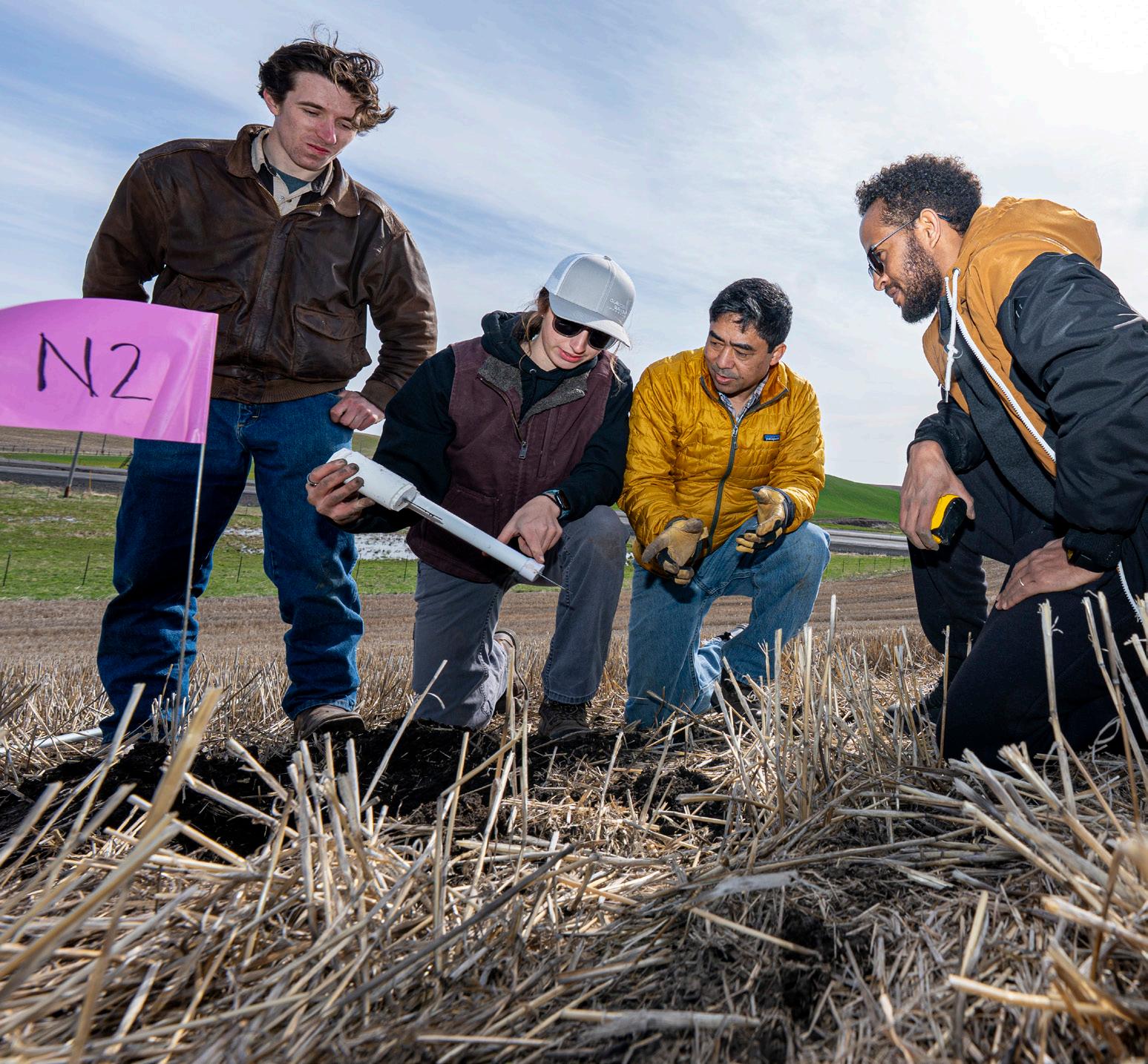
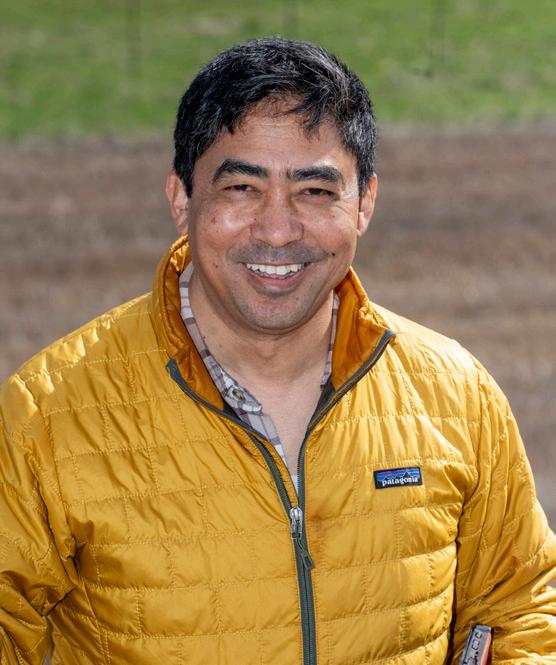
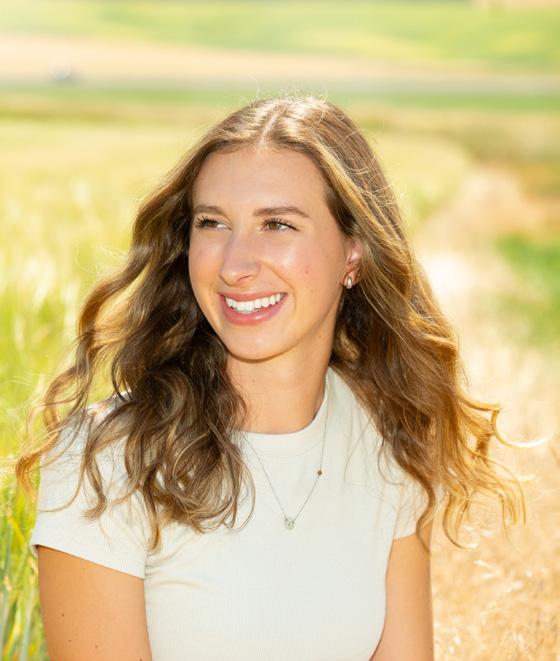
Jaycee Johnson helped develop a soil monitor used for research. Pictured left to right: Milo Flint, Jaycee Johnson, Professor Dev Shrestha and doctoral student Robel Alemayehu.
Doctoral student Jaycee Johnson
Professor Dev Shrestha
“We know biochar helps retain soil moisture, but we don’t yet know how much or its economic value to farmers,” Shrestha said. “Once we have the data, we’ll develop software for farmers that gives them feedback on where and how much biochar to apply to get the most bang for their buck.”
Promoting a more efficient system
Johnson said her father, like many Palouse farmers, is open to better farming methods and is always exploring new practices. If biochar proves effective and affordable, it will likely catch on with local farmers, she said.
Many farmers are looking for ways to conserve the amount of nutrients that they often apply at a constant rate across their fields, Johnson said. But overapplying nutrients to offset runoff caused by rain or snowmelt is costly. Much of it
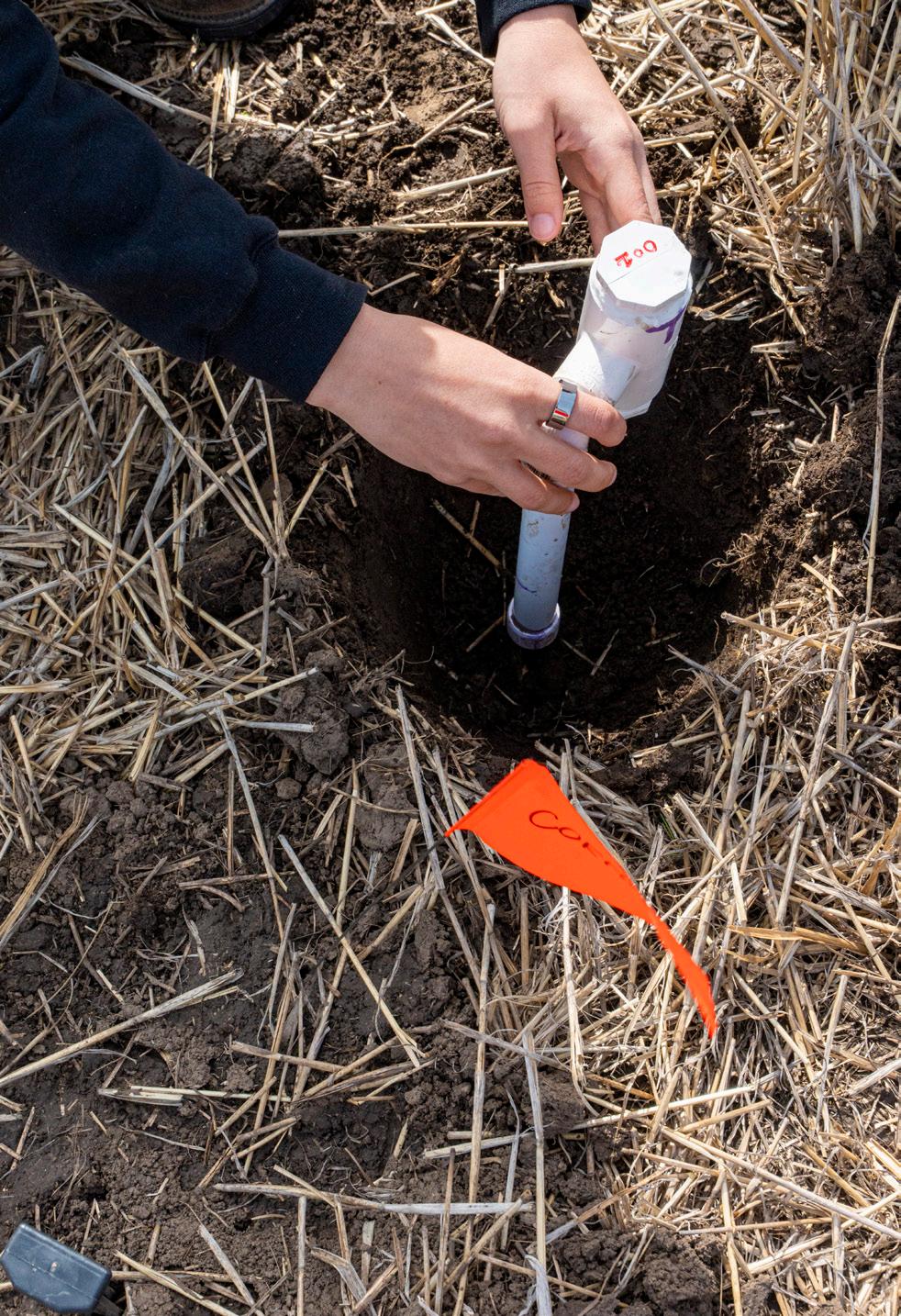
leaches away before reaching the plants where it is needed most. Being able to keep fertilizer where it’s placed allows farmers to decrease input costs.
“This project aims to help farmers lower their input costs and increase yields, and that’s really what you want in an efficient system,” Johnson said. “One of the challenges of farming is producing enough for a growing population with the same amount of land we’ve always had — biochar could help maximize the yield.”
The research also considers environmental factors.
“We want to produce a large yield for years to come, so we want to retain topsoil and prevent leaching of chemicals and fertilizer into waterways, which can harm the environment,” said Johnson, who earned her undergraduate degree in 2024 in biological engineering at U of I after her dad encouraged her to choose a practical degree.
“I knew I wanted to do something agricultural related,” she said. “This research has the potential to really help farmers in the region.”
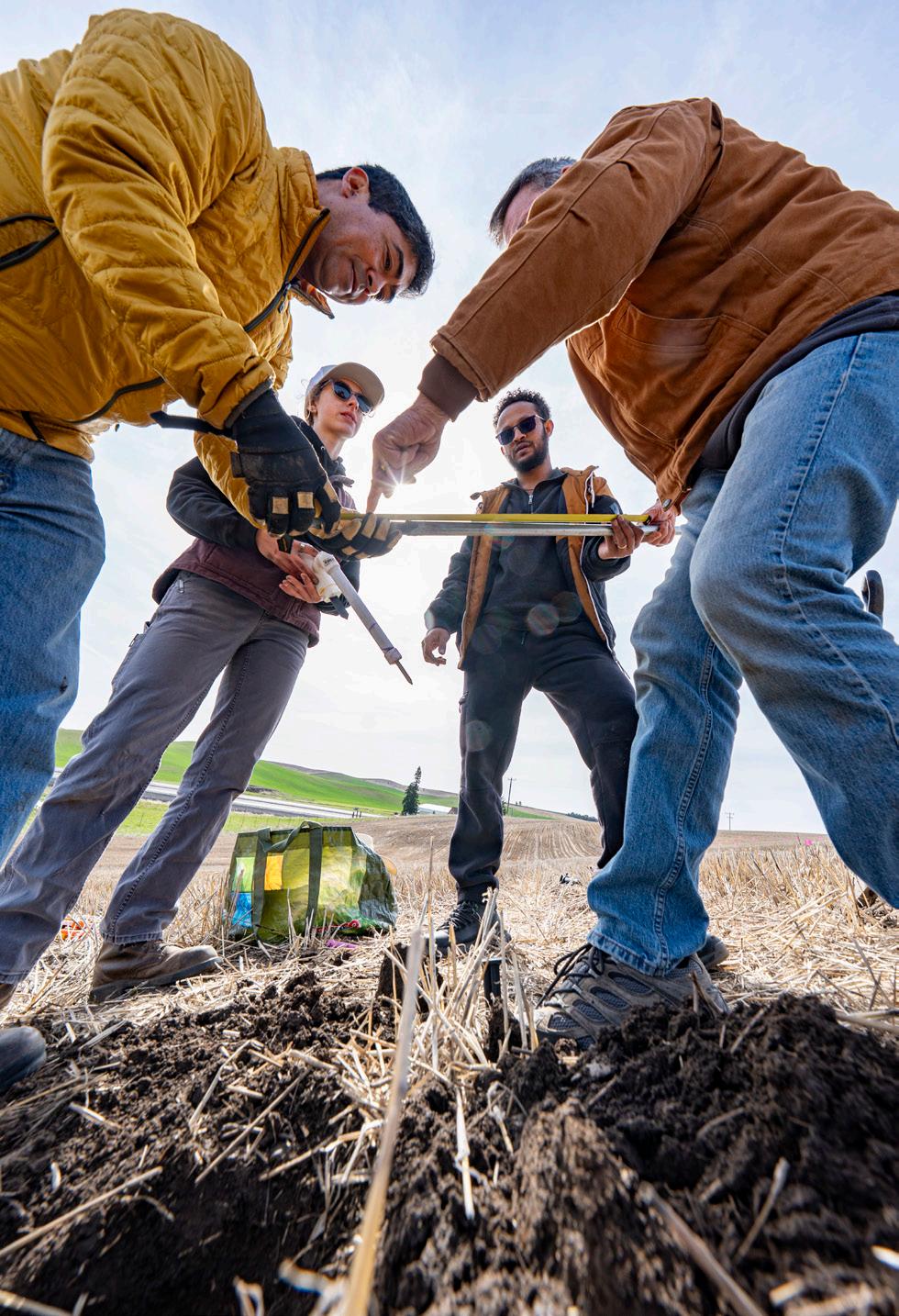
Nearly 300 soil sensors were installed south of Moscow to monitor moisture across varying slopes.
The research team prepares to install a soil moisture sensor deep in a wheat field at U of I’s Kambitsch Farm near Genesee.
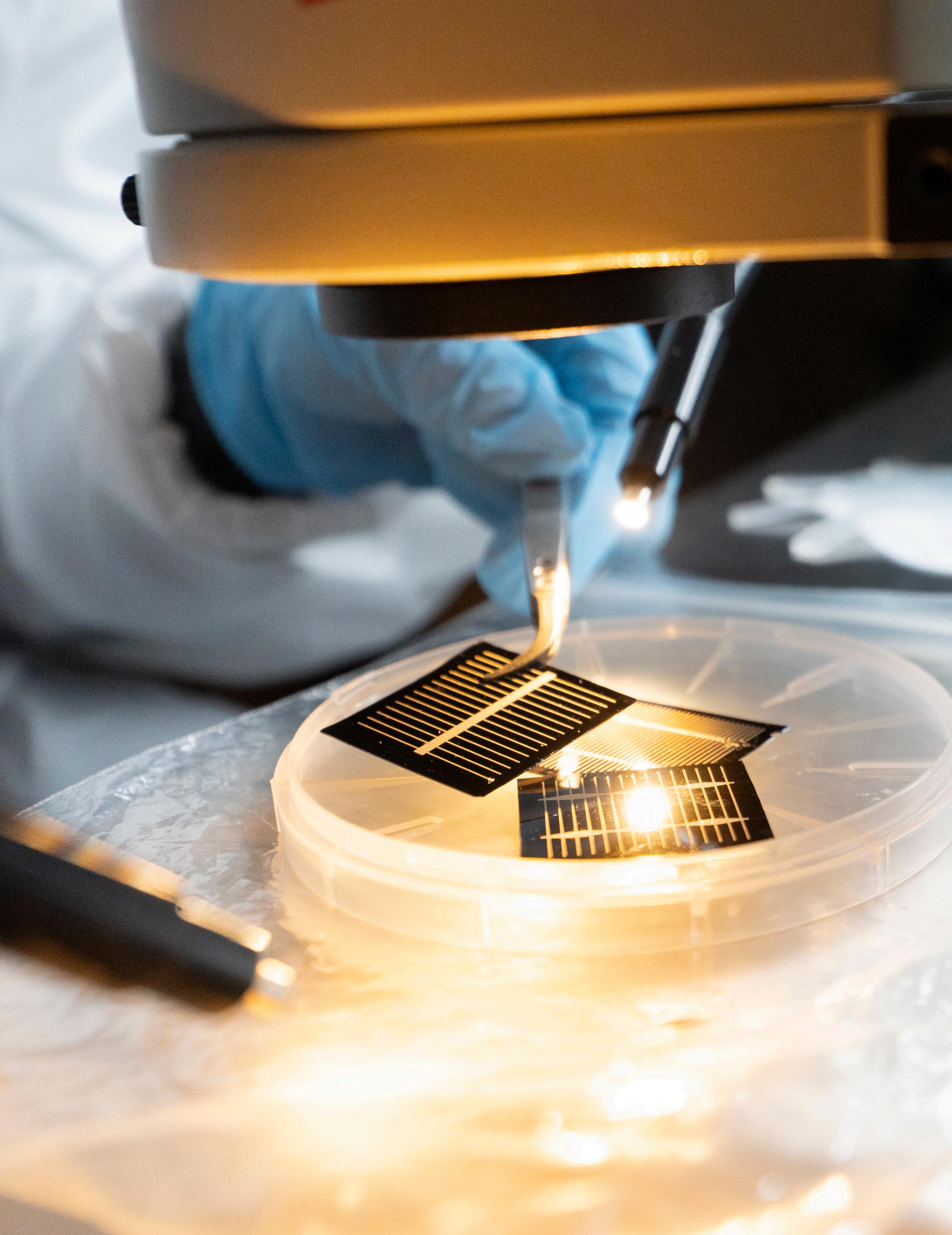
U of I equips students for semiconductor careers with hands-on,
Micron-
backed experience
Story by Alexiss Turner ’09
Photos by Melissa Hartley
Inside University of Idaho’s Next Generation Microelectronics Research Center (NGeM), engineering students don full-body suits and step into a clean room — a dust-free, temperature-controlled space used to build the delicate electronics found in devices such as phones, computers, cars and solar panels.
Connor Denson, of Wallace, was part of an undergraduate team from the College of Engineering’s nationally recognized Senior Capstone Design Program, which is creating pathways for more U of I students to gain handson experience working with semiconductor and microelectronics devices in the clean room.
Sponsored by Boise-based Micron Technology, the team is designing a solar cell — an essential component of solar panels. For U of I and Micron, projects like this provide students the knowledge they need to fill the growing skills gap in the semiconductor industry.
“If you would have told me in high school that I’d be using semiconductor materials to build a device that can convert sunlight into electricity, I wouldn’t have believed you,” said Denson ’25, a U of I electrical engineering graduate student. “U of I gives you the tools — not just the technical knowledge, but the tenacity and problem-solving mindset that industry is looking for.”
Closing the national semiconductor talent gap
As demand grows for faster, smaller and more efficient electronics, so does the need for a skilled workforce to design, manufacture and test advanced semiconductor devices and microelectronics.
By 2030, over half of the nation’s 115,600 projected new jobs in the semiconductor industry are predicted to go unfilled, according to the Semiconductor Industry Association.
For over 40 years, U of I has partnered with industry leaders like Micron to invest in semiconductor education, clean room infrastructure and workforce training.
“Our students don’t just learn through lecture. They want to be in the lab,” said Feng Li, Micron Endowed Professor in Microelectronics and director of NGeM. “Mission-driven learning motivates students, sharpens their technical skills and helps them see
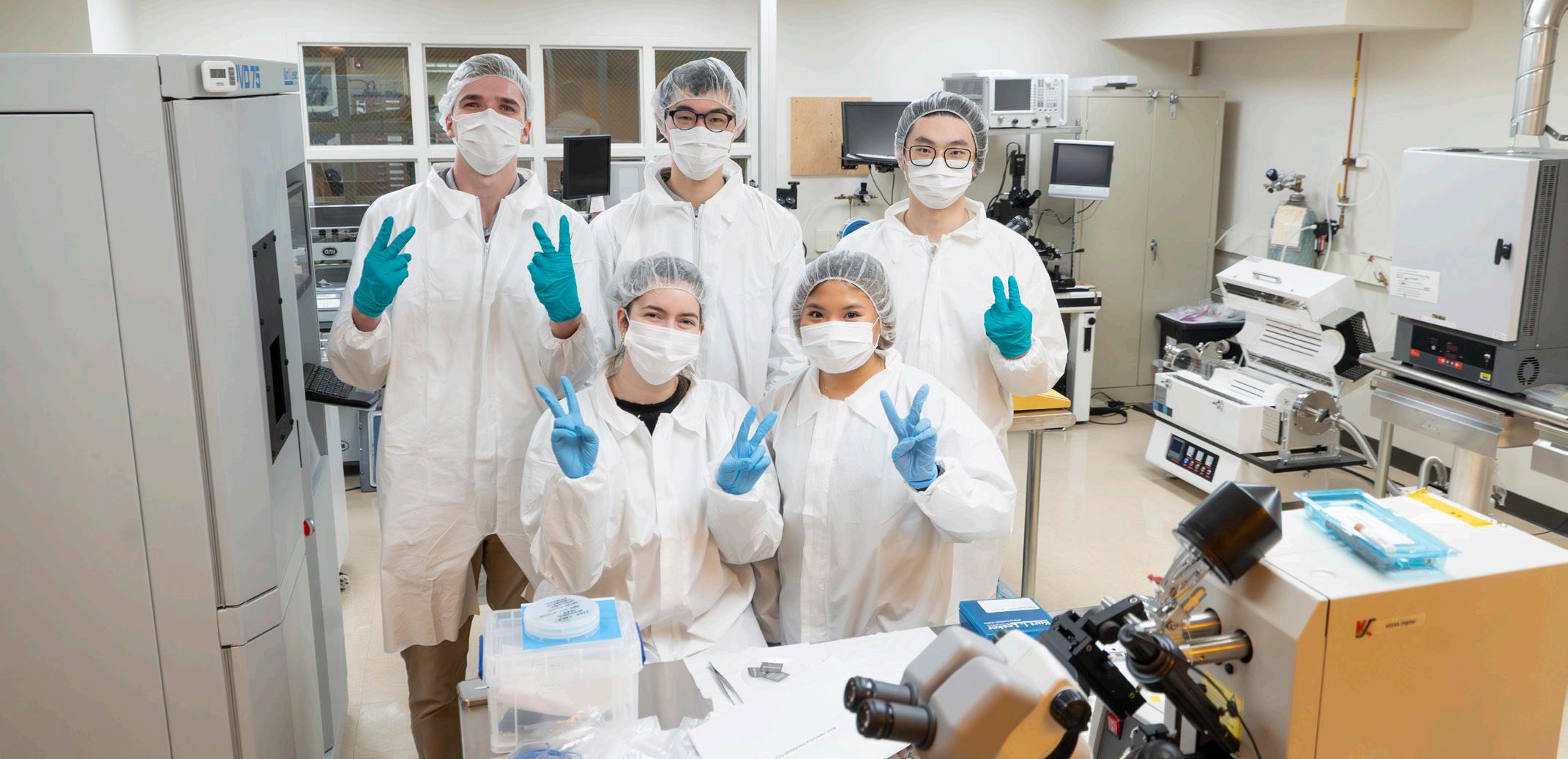
Students pose for a photo in U of I’s Next Generation Microelectronics Research Center (NGeM). The lab is a clean room, and students wear masks and protective coverings because even a microscopic particle of dust or a droplet of moisture can damage sensitive microelectronic components.
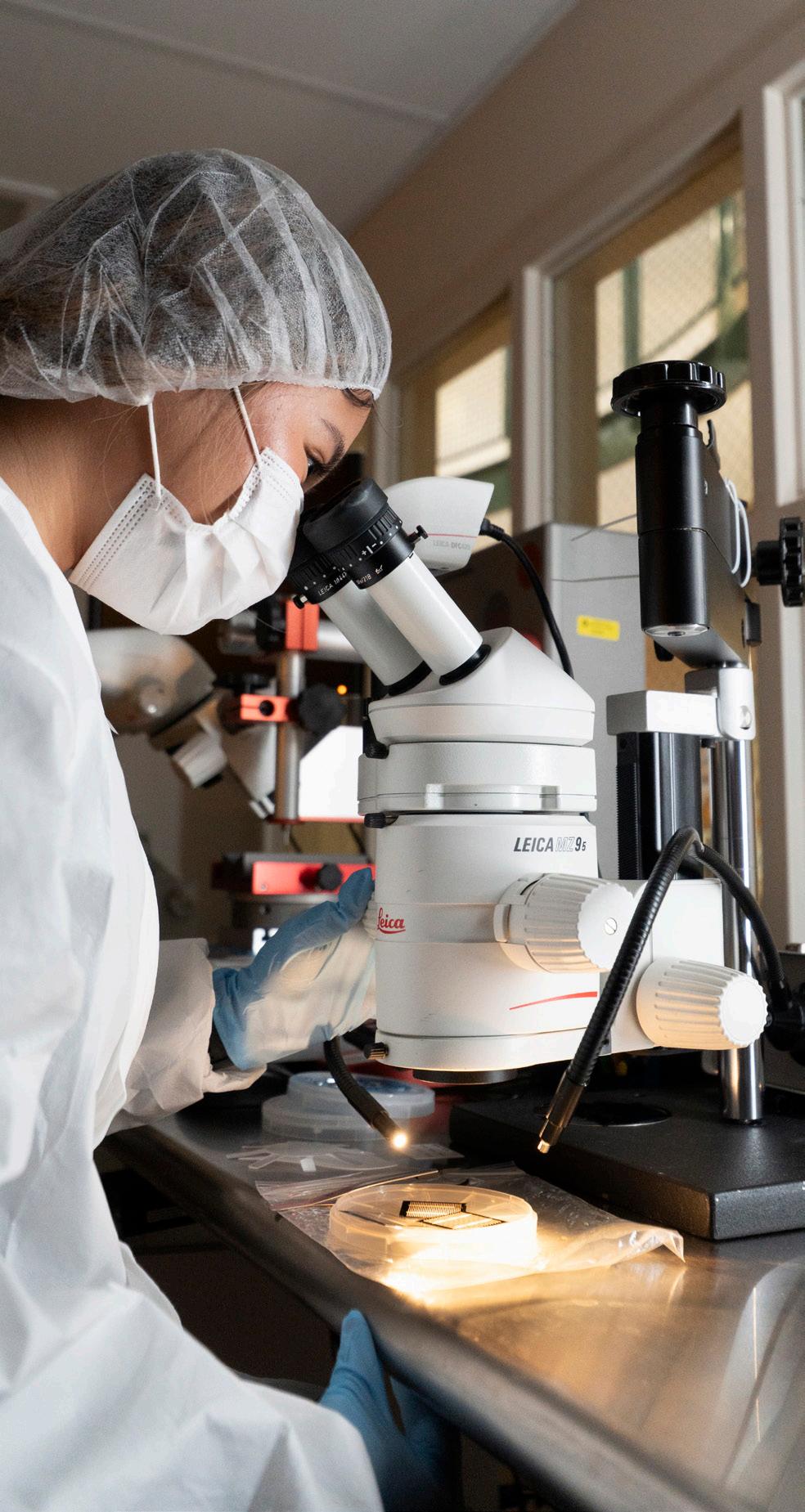
themselves contributing to something bigger. That’s exactly the mindset we need in the next generation of semiconductor engineers in this growing and critical field.”
Real microchip fabrication skills in the clean room
Electronic circuits in microelectronic devices — like those in memory chips and solar cells — are built on wafers often made of silicon, a material prized for its conductivity. In the NGeM clean room, students use the same professional-grade tools used in global semiconductor manufacturing.
“I’ve applied what I learned in class directly to the lab,” said solar cell team member Julienne Sophia Pacquing, a ’25 computer engineering graduate. “I’ve trained on the same machines used in industry. That kind of experience is priceless.”
A typical solar panel is made of dozens or even hundreds of solar cells — microelectronic devices that convert sunlight into electricity. In the NGeM clean room, students prepare the wafers for fabrication. A $1.1 million Idaho Workforce Development Council (IWDC) grant will expand these capabilities and support student work on foundational semiconductor technologies.
“U of I has built decades of excellence in semiconductor education,” Li said. “With support from partners like Micron, NASA and the IWDC, our students have unprecedented access to resources, scholarships and real-world experience.”
Idaho students interested in robotics, semiconductors and microelectronics can apply for full-tuition semiconductor scholarships, made possible through the IWDC Amplifying

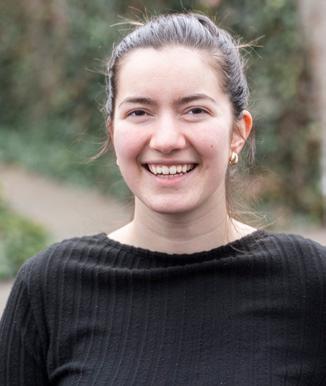
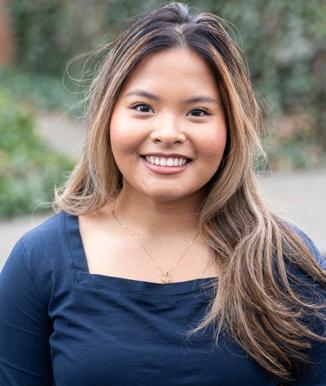
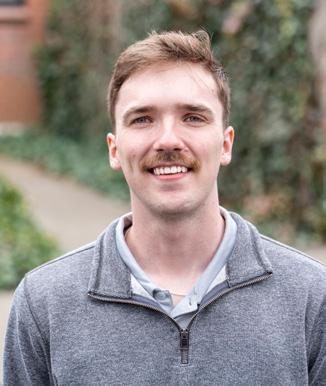
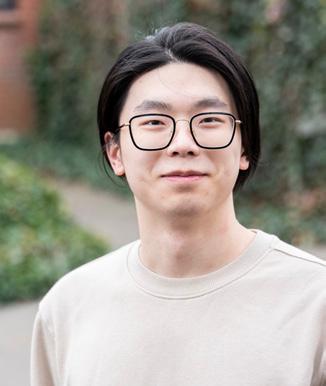
Connor Denson ’25, graduate student
Junhua Gu, graduate student
Julienne Sophia Pacquing ’25
Jennie Tafoya ’25
Computer engineering graduate Julienne Sophia Pacquing ’25 uses a microscope to look at the team’s fabricated solar cell.
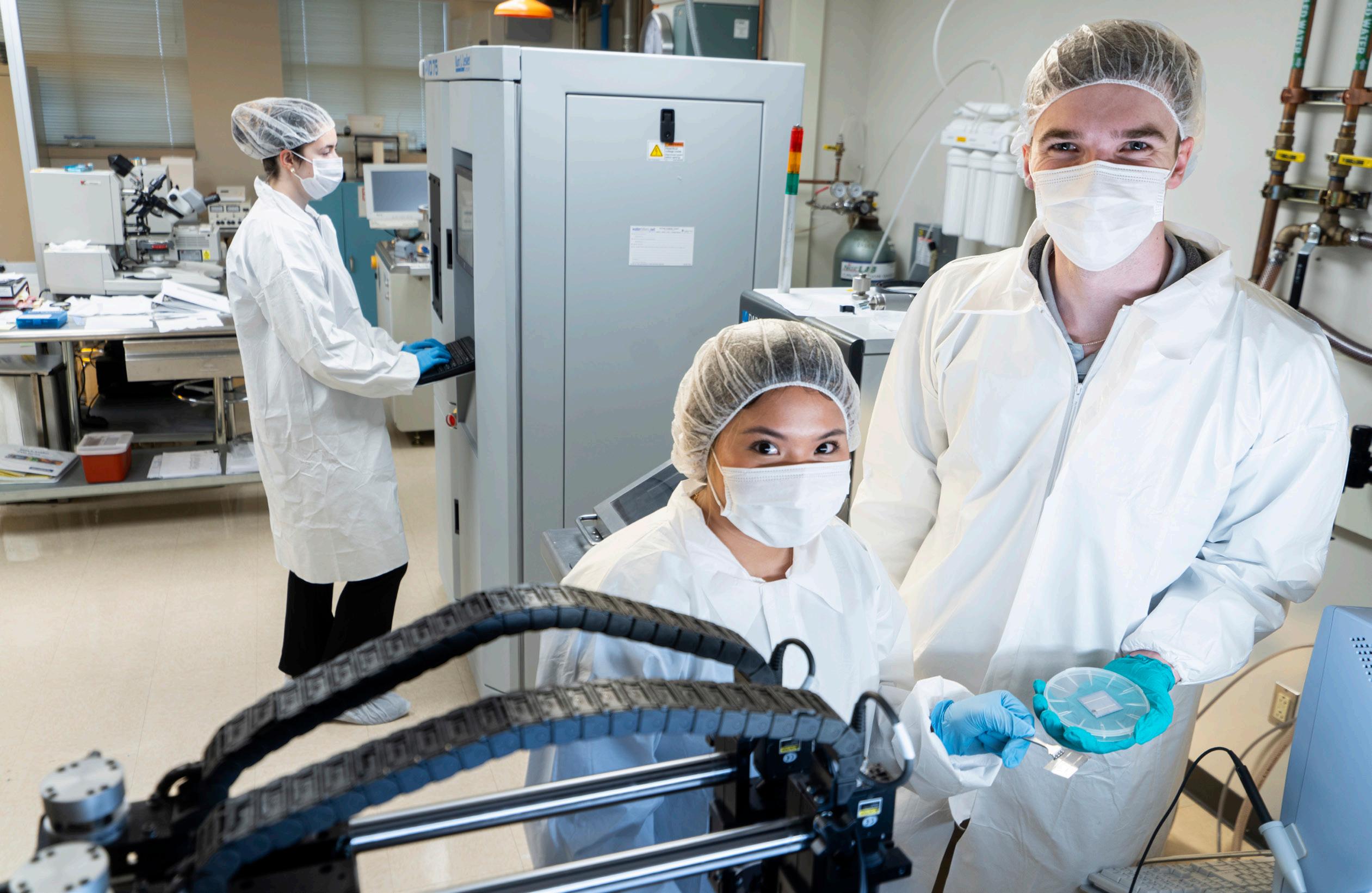
Semiconductors Across Idaho program, which also sponsored the solar cell project.
“The U of I College of Engineering has been instrumental in motivating me to push my career and education further than I or my family thought was possible,” said Denson, a first-generation college student and scholarship recipient.
Vandals are ready to power Boise’s semiconductor tech boom
Denson spent Summer 2025 at his second internship with Micron.
“The pace at Micron is fast, and you’re constantly updating your skills,” Denson said. “In microelectronics fabrication, every detail matters. Learning to take calculated risks and seeing how small changes affect performance, that’s the engineering mindset. That’s innovation.”
Denson worked with U of I alumnus Bryce Cook ’05, a Micron senior director focused on improving dynamic random-access memory (DRAM) technology.
Micron is the only U.S.-based manufacturer of DRAM chips — semiconductor devices used in memory — and is investing $15 billion in a Boise fabrication facility expected to create thousands of jobs in Idaho. Combined with a New York facility expansion, it’s the largest U.S. effort to boost domestic memory chip production.
Cook, a former machinist for an Idaho Micron supplier, chose to attend U of I as a nontraditional student in the electrical engineering program. Inspired by the Micron engineers he worked with, he saw U of I as a clear path to expand his skills to match the dynamic work at Micron.
“University of Idaho’s electrical engineering program builds a strong foundation in hands-on learning, simulation and data analysis — skills that translate directly to the diverse roles at Micron Technology,” Cook said. “U of I graduates come in with a strong work ethic and the ability to learn quickly, allowing them to adapt, grow and ultimately thrive in areas of the company where they can excel.”
Julienne Sophia Pacquing ’25 and graduate student Connor Denson ’25 participated in a senior project to create pathways for more U of I students to gain field-based experience working with semiconductor and microelectronics devices in the clean room.
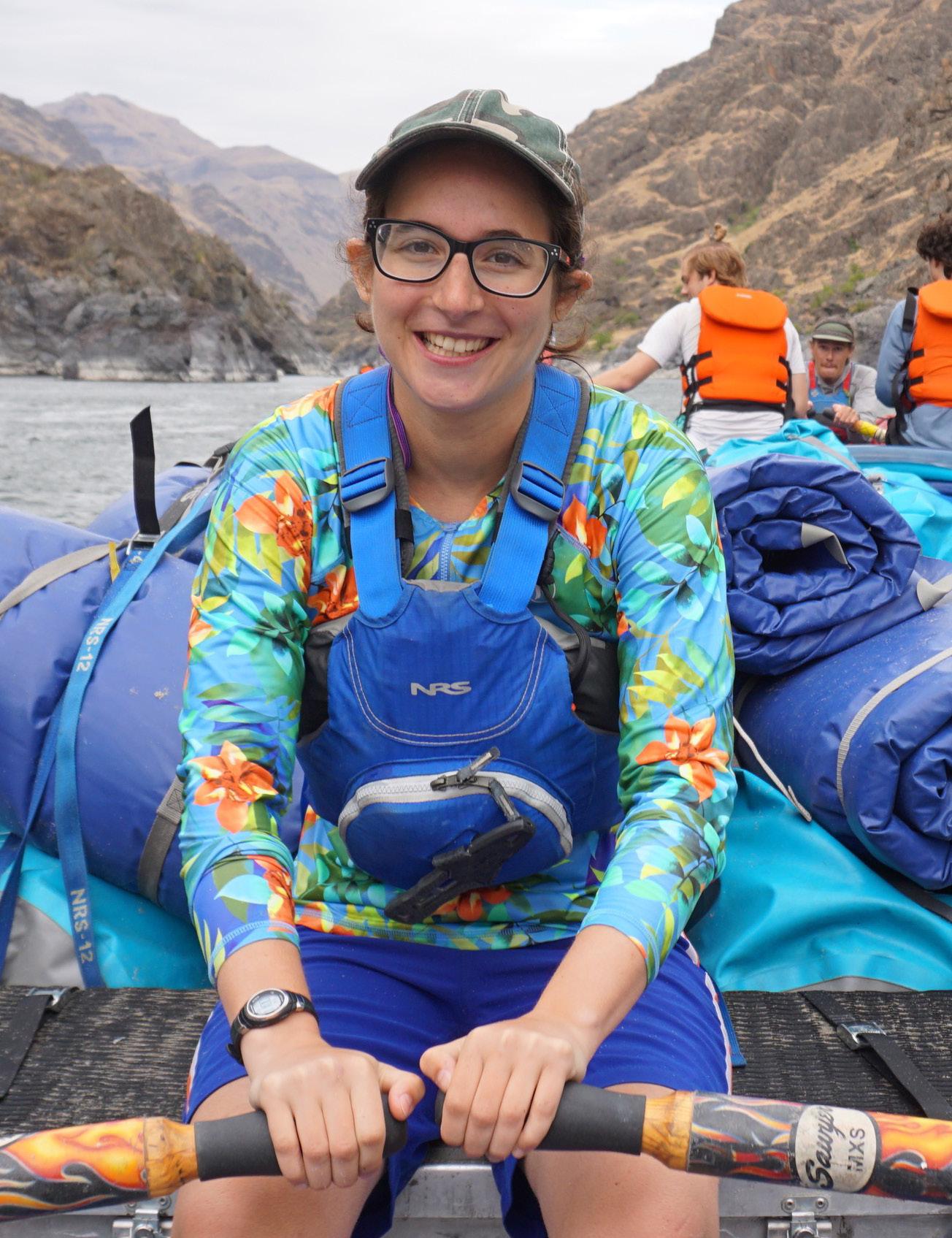
FROM FIRE TO RAPIDS A STUDENT’S JOURNEY TO LEADERSHIP
Arielle Bennet embraced U of I’s Outdoor Program as a way to supplement her degree.
Arielle Bennet discovered strength in U of I’s Outdoor Program, building skills to lead on and off the water
Story by Chris Paige
Photos by Arielle Bennet
In August 2020, hundreds of lightning strikes in the Pacific coastal mountains sparked one of the largest wildland fires in California’s history.
The CZU Lightning Complex Fire scorched over 80,000 acres, destroying more than 97% of Big Basin Redwoods State Park — California’s oldest state park — and fueled the burning passion of a then-16-yearold Arielle Bennet.
Now a junior in University of Idaho’s College of Letters, Arts and Social Sciences, Bennet has packed her college years with hands-on education and leadership training through the U of I Outdoor Program. She’s building the skills she needs to become a firefighter paramedic and inspire the next generation of outdoor professionals.
One year, nine trips, countless lessons
“For me, the decision to attend college was the choice to start a new chapter of my life,” said Bennet, an Outdoor Program trip leader pursuing a degree in interdisciplinary studies with an emphasis in education and medical sciences.
She dove headfirst into new opportunities at U of I, beginning with the Outdoor Program’s Vandal Ventures first-year rafting trip the summer before her freshman year. Bennet pushed herself beyond her comfort zone, and on the third day of the six-day excursion, she tried rowing for the first time.
“The 11-foot oars felt like long, awkward extensions of my arms that I did not know how to control. Slowly, each dip of my oar into the water became firmer and more confident,” Bennet said. “I will never forget the feeling of rowing that boat through my first rapid. The small waves were little ripples against the big gear boat, but navigating through them felt like one of the greatest accomplishments of my life. I felt almost weightless as the boat went up and down in rhythm, hitting each wave head-on.”
By her sophomore year, Bennet had earned certifications in wilderness first response, CPR and first aid, and swift water rescue, giving her a solid foundation as a leader. She moved from participant to guide, helping incoming Vandals face the same challenges she once navigated.
“I was back on the same section of water — only this time, not only was I rowing a gear boat for a six-day trip, I had participants learning to row and read water from me,” Bennet said. “While this was my ninth rafting trip at this point, it was my first time leading my peers on the river, and the nerves dropping into the Salmon River’s Snowhole Rapid were just as real as when I faced those first ripples.”
From rapids to rescue calls
A self-proclaimed introvert by nature, Bennet found her voice on the river. The Outdoor Program gave her space to grow into a confident, capable leader within the hectic context of a fast-paced rafting trip.
“With each trip, my confidence grows, as does my awe of the breathtaking landscape and my love for the feeling of dipping those oars into the thick water and pushing forward,” she said. “There is strength in my arms I didn’t know I possessed.”
In the months after the CZU Lightning Complex Fire, Bennet enrolled in the Watsonville, California, fire department’s youth academy. Later, she completed her training with the Moscow Fire Department, where she now serves as an EMT while pursuing her degree. Originally set on wildland firefighting, Bennet shifted to emergency medicine and now plans to become a firefighter paramedic, applying her classroom and field experience.
“I came to college to embrace new experiences and learn about myself, and the river has truly changed me,” Bennet said.
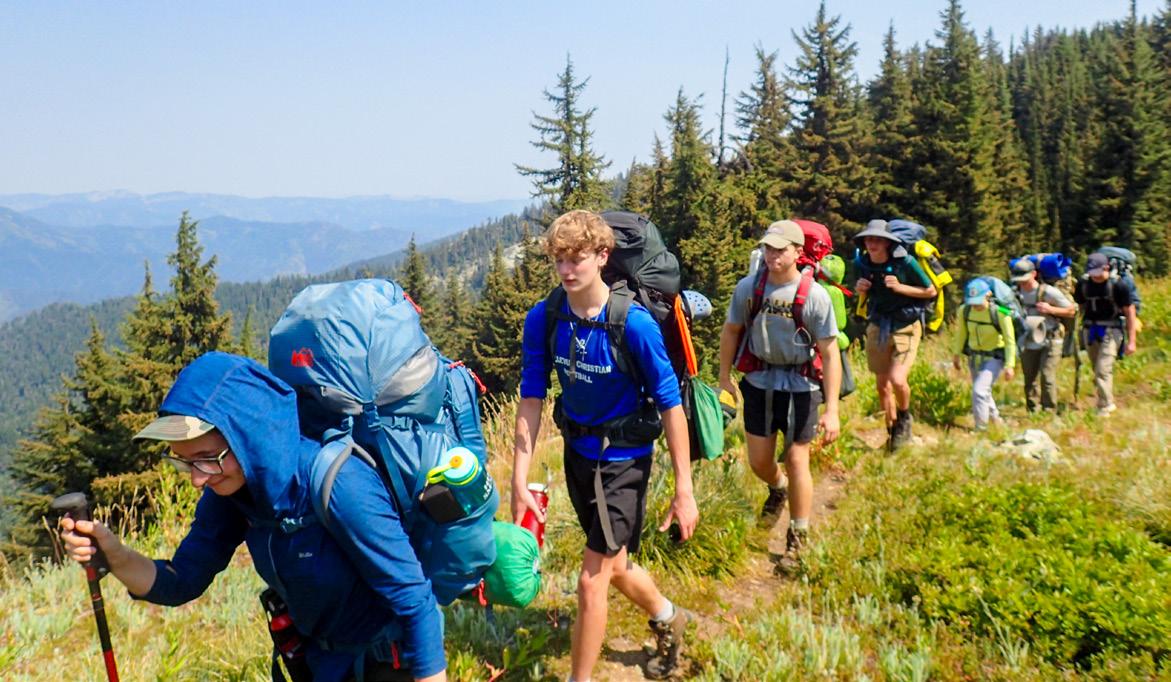
As an Outdoor Program trip leader, Bennet pushed herself beyond her comfort zone.
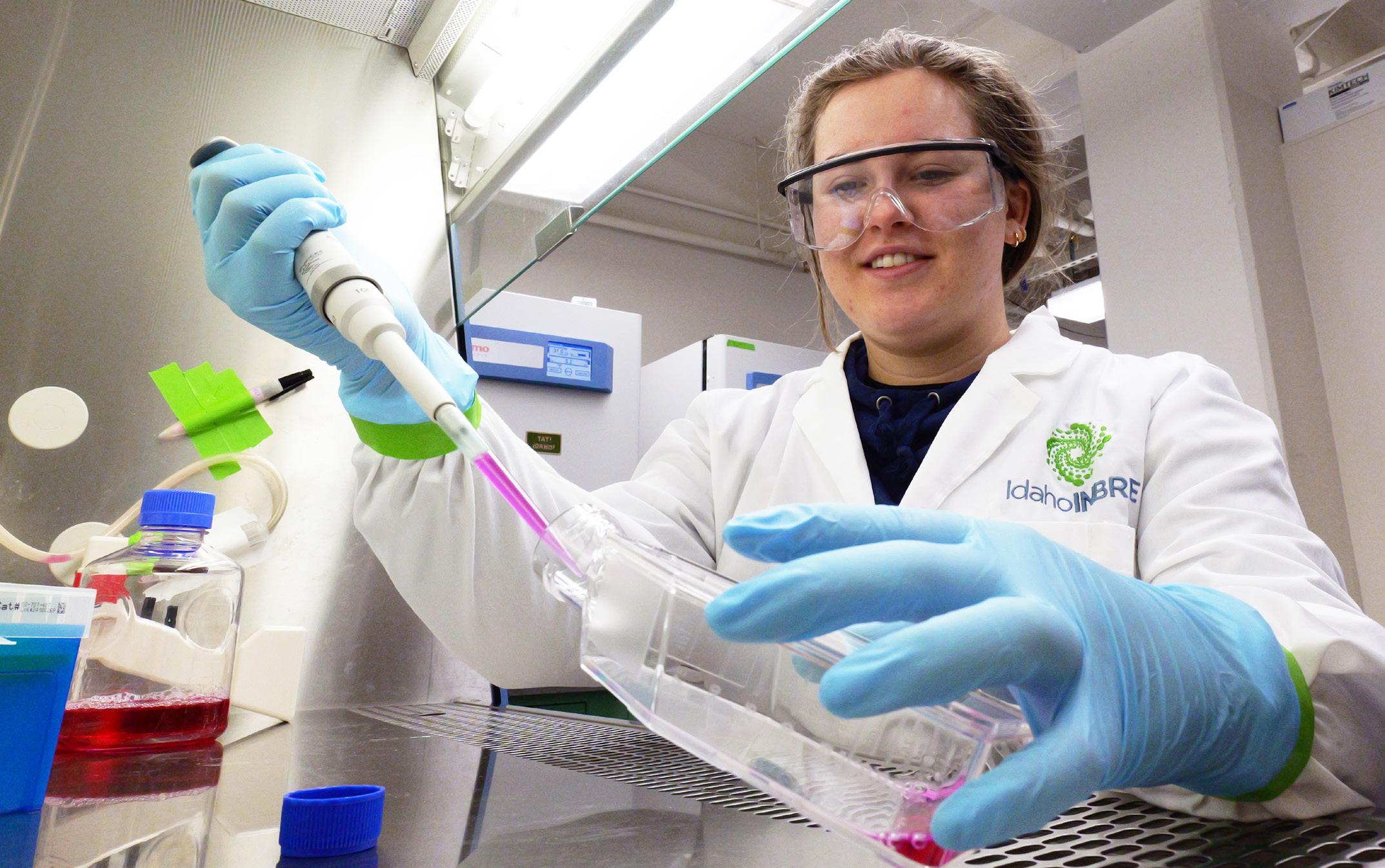
Labs advance tendon healing science
Story by Alexiss Turner ’09
Three University of Idaho labs are collaborationg to study tendon development and healing.
Led by College of Agricultural and Life Sciences Distinguished Professor Carolyn Hovde Bohach, an interdisciplinary team of researchers received a $598,537 grant from the IDeA Networks of Biomedical Research Excellence (INBRE) to create a biomaterial and study how cells signal tendon tissue development.
“We’re leveraging complementary skill sets in chemistry and engineering to lead transformative research at University of Idaho,” said Bohach, principal investigator and Idaho INBRE director. “This award allows our students to participate in research to better understand the mechanisms of tendon tissue formation and our faculty members to ultimately engineer tendon tissue replacements and design regenerative therapies.”
Tendons are vulnerable to damage from repetitive motion and physical stress. According to the National Institutes of Health, over 32 million tendon injuries occur annually in the U.S., often requiring surgery and rehabilitation. Re-ruptures are common, and full strength is rarely restored.
The cross-college collaboration is advancing tendon tissue engineering by studying how specific molecules trigger tenogenesis — the transformation of cells into tendon tissue. Researchers in the College of Science produce these molecules; the chemical engineering lab develops a hydrogel to isolate and deliver them; and the Tendon Tissue Engineering Laboratory tests their effects.
This research could help doctors grow tendon-like tissue in the lab — strong enough to be stitched into place during surgery and used to repair injuries.
University of Idaho graduate student Grace Clair readies cells for viewing under a microscope. U of I is leveraging an interdisciplinary effort to increase understanding of human tendon development and healing after injury.
U of I, INL expand nuclear energy partnership
Story by Jodi Walker
University of Idaho and Idaho National Laboratory (INL) are expanding their long-standing collaboration through a new five-year Strategic Understanding for Premier Education and Research (SUPER) agreement. The initiative focuses on advancing nuclear energy, national security and a lowcarbon energy future.
“U of I has a proud 80-year tradition of partnership with INL. This agreement, and the work it will drive, pushes the boundaries of science and engineering, while providing tangible and sustainable energy solutions for our state,” U of I President Scott Green said.
The SUPER agreement directs research toward nuclear materials, fuel cycle engineering, integrated energy systems and cybersecurity — areas where U of I brings unique expertise.
“By advancing technology and support of sustainable, adaptable energy solutions, this new agreement strengthens U of I and INL’s position in Idaho and advances our pursuit of large-scale research centers to promote economic vitality,” said Suzie Long, dean of the U of I College of Engineering. “We are building nuclear energy’s role in a lowcarbon future while improving grid stability and reducing environmental impact for our state and nation.”
AI innovation supports US research enterprise
Story by Michelle Reagan
Backed by a $4.5 million National Science Foundation (NSF) grant, University of Idaho is harnessing generative AI to revolutionize administrative processes and enhance research management. The project is a step toward boosting efficiency across the academic landscape.
Led by Sarah Martonick, director of the Office of Sponsored Programs (OSP), the project is part of NSF’s GRANTED program and aims to strengthen the U.S. research enterprise by improving administrative support and expanding access for under-resourced institutions.
University grants involve extensive paperwork — from accounting and payments to compliance with human and animal subject procedures. Currently, data is manually transferred from funding agencies into university systems. The project will
develop AI tools to automate the process, improving speed, accuracy and compliance.
“I believe this project will transform the entire field,” said Chris Nomura, vice president for research and economic development. “The new AI tools should allow research administrators, often an overworked field, to reduce their time spent on repetitive, monotonous tasks and free up time for them to spend on more interesting, thoughtful projects.”
The initiative is a partnership between OSP and the Institute for Interdisciplinary Data Sciences (IIDS).
“Through IIDS, U of I possesses a powerful combination of technical expertise and advanced infrastructure in artificial intelligence,” said Luke Sheneman, director of IIDS’s Research Computing and Data Services unit. “As a smaller institution, we acutely feel the administrative burdens of research management, but we also have the resources to develop innovative AI-driven solutions.”
The grant’s impact reaches beyond U of I, with plans to share generative AI tools with smaller, underequipped institutions. U of I is partnering with Southern Utah University and plans to expand to two or three more institutions by year three.
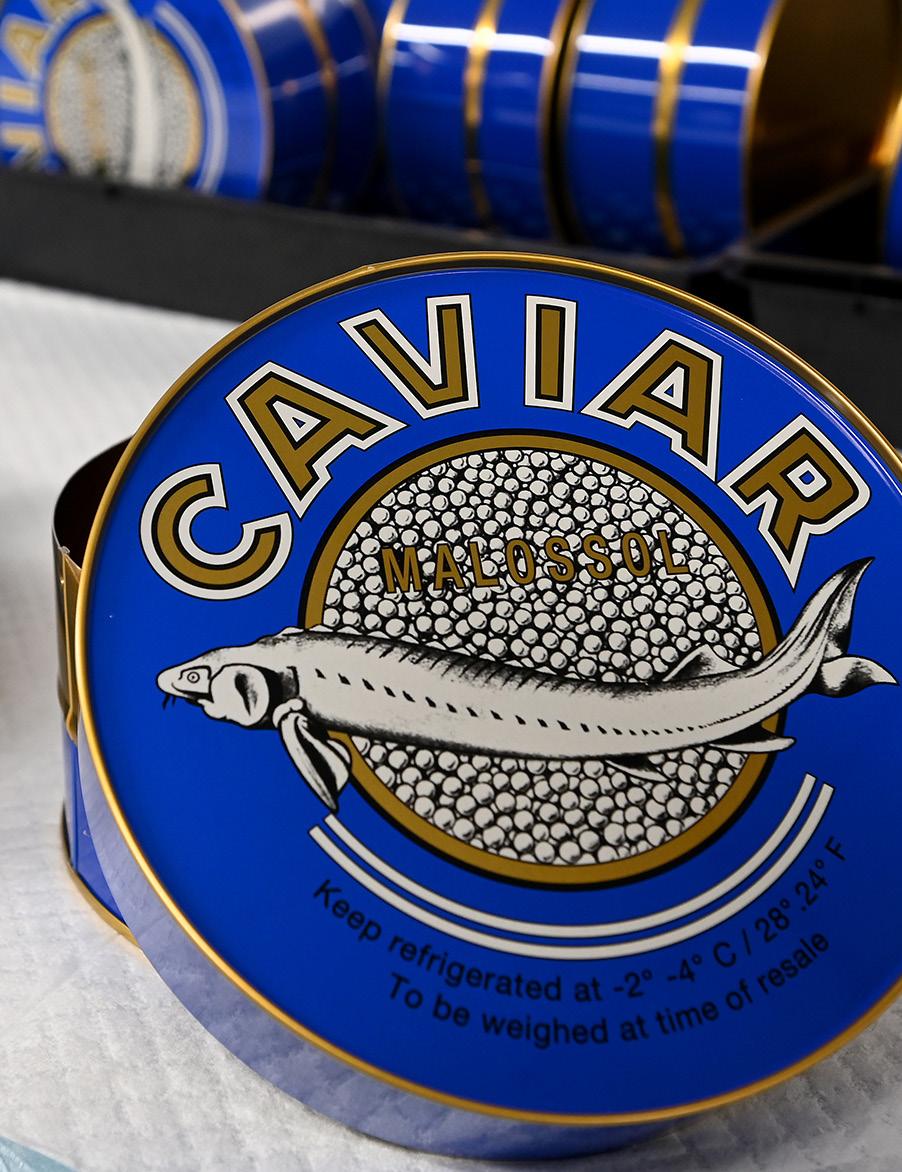
Idaho Springs Foods caviar, made in the Magic Valley, is known for its quality and has benefited from research at U of I’s Hagerman Fish Culture Experiment Station, part of the Aquaculture Research Institute.
HWHI | FALL 2025

RAISING THE BAR WITH CAVIAR
From pristine springs to gourmet tables: U of I’s role in elevating Idaho caviar
Story by John O’Connell
Photos by Bill Schaefer
Since the early 1980s, the Lemmon family has specialized in a scarce, niche food product that’s synonymous with luxury.
Their Magic Valley-based business, Blind Canyon Aquaranch, raises and processes white sturgeon caviar through its subsidiary, Idaho Springs Foods. It’s one of two Idaho caviar businesses that have earned the state a reputation for producing the crème de la crème of the precious commodity.
Since 1997, University of Idaho has played a pivotal role in shaping Idaho’s renowned caviar industry. Scientists at U of I’s Hagerman Fish Culture Experiment Station — part of the Aquaculture Research Institute — have spearheaded innovative studies and delivered vital technical expertise, contributing significantly to the industry’s reputation for outstanding quality.
It’s all about the water
The secret behind the Magic Valley’s caviar lies in producers’ access to a continuous flow of pristine spring water where sturgeon are carefully raised. Caviar — sturgeon eggs cured in salt brine — can develop unappealing earthy flavors when raised in unlined ponds or facilities with recirculating water. Idaho spring water eliminates those impurities, allowing the natural flavor to shine.
“Ours is a very clean flavor so that the buttery and nutty tastes really stand out. You don’t have any environmental influence,” said Linda Lemmon, general manager of Idaho Springs. “Distributors make certain to note that it’s Idaho white sturgeon.”
The Lemmons sell their caviar wholesale in large tins, which buyers repackage into smaller tins or jars ranging from a half ounce to 4 ounces each. A single ounce of their product can fetch upward of $100 at retail.
Lemmon’s husband, Gary ’77, is among the principal owners of Blind Canyon. Gary’s father, George, started raising Sacramento River white sturgeon in 1982. Five years later, the company joined
Most Idaho Springs Foods caviar has a distinctive olive color and a clean flavor, thanks to pristine spring water used to raise the sturgeon.
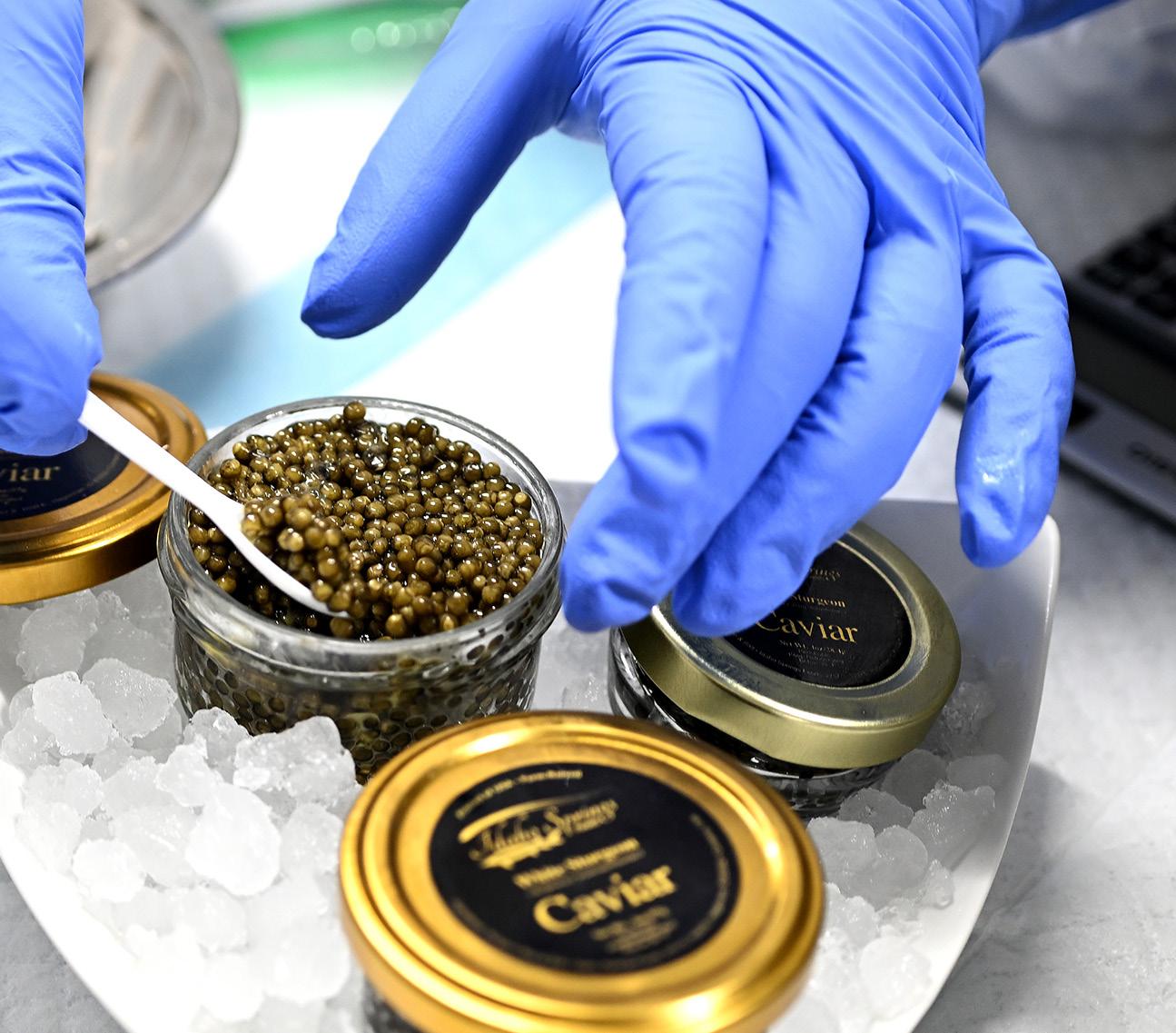
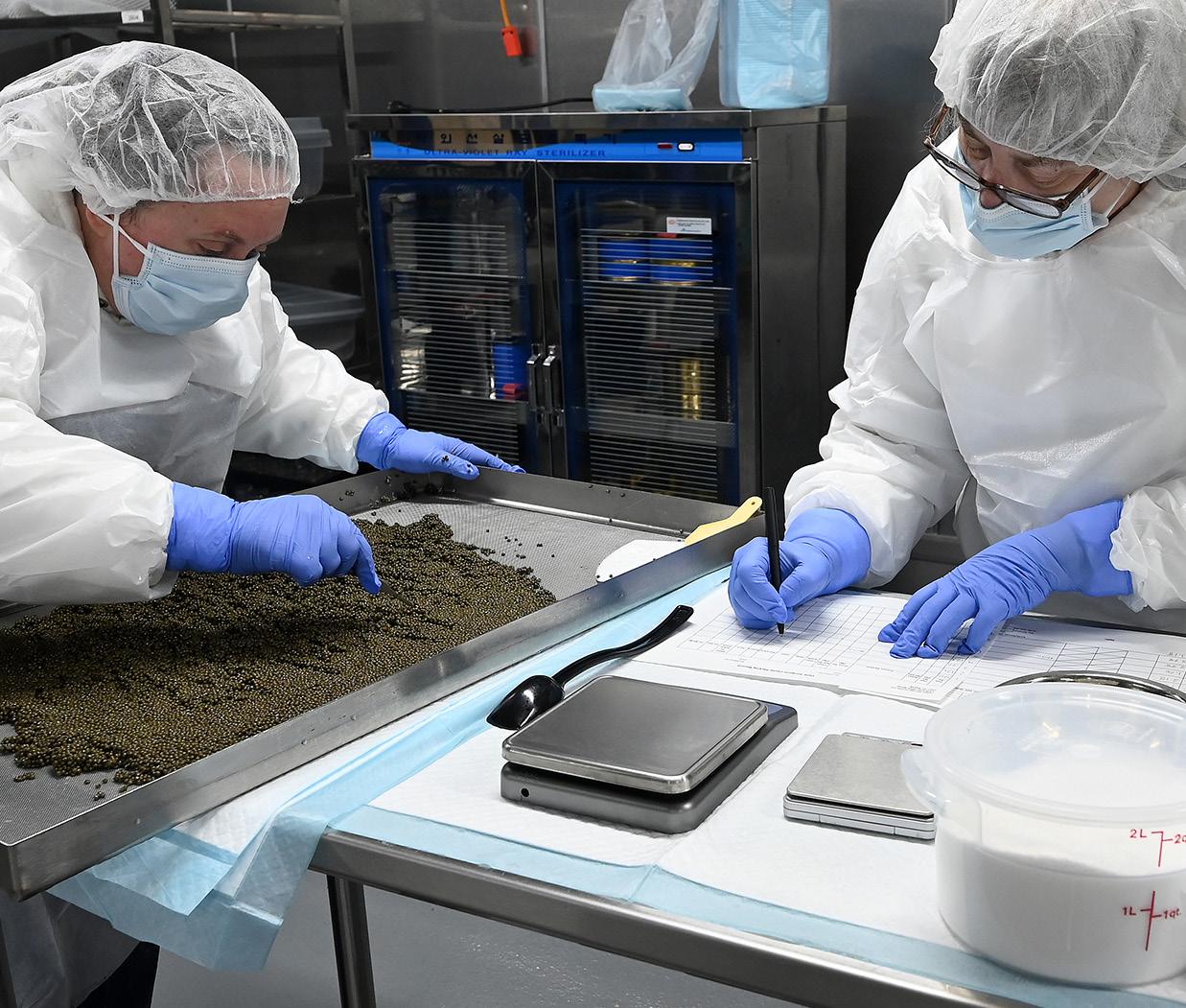
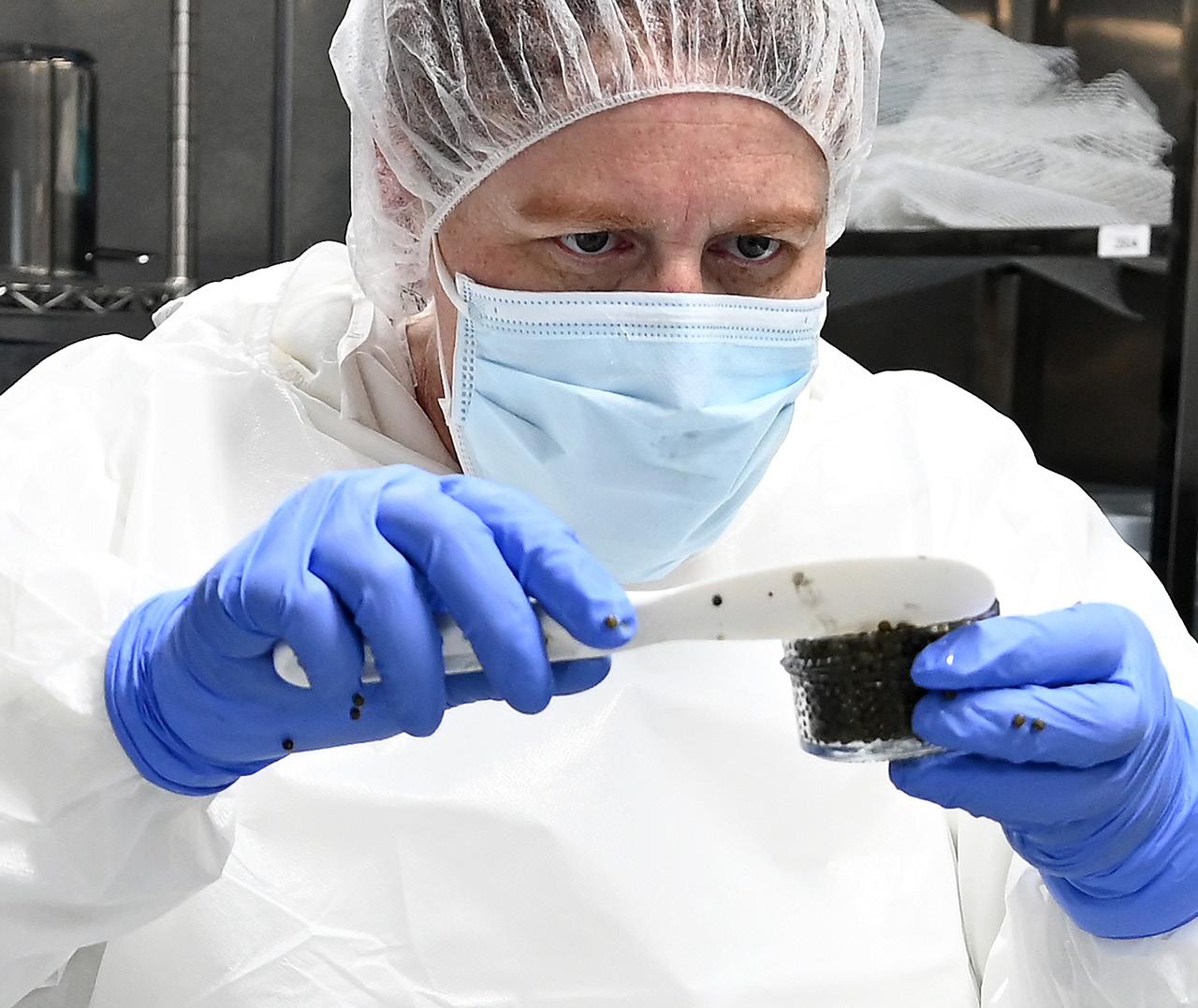
C.J. Fossette packs a 2-ounce jar with finished caviar.
Katie Jeszke, left, and Linda Lemmon clean and drain screened roe and record data about a new batch of caviar.
a cooperative involving the Idaho Department of Fish and Game, Idaho Power and about a dozen aspiring commercial sturgeon farmers and other collaborators.
Commercial operators were allowed to breed a few wild sturgeon removed from the Snake River each spring, retaining some of the fry for caviar and meat production while dedicating others for stocking the catch-and-release fishery. They also agreed to relinquish up to half of their live sturgeon to bolster the fishery in the event of a threat to the wild population.
Sturgeon are remarkably long-lived fish, capable of surviving for over a century. They can also grow to impressive sizes — the largest female in the Lemmons’ brood pool, spawned in 1993, now weighs more than 300 pounds.
Idaho produces about 4,400 pounds of caviar annually, placing it a distant second to California among U.S. states. Known for its light, often olivecolored roe, Idaho’s caviar stands in contrast to California’s signature black variety.
“Many chefs will tell you the white sturgeon here in Idaho produce some of the most sought-after caviar, particularly in the nation but internationally as well,” said Jacob Bledsoe, an assistant professor and aquaculture Extension specialist based in Hagerman.
Caviar harvest typically occurs when fish are between 14 and 16 years old, and processing caviar must happen quickly. They kill the fish, remove the ovaries, salt the eggs and seal them in tins all in under an hour. Cooked sturgeon has a dense, swordfish-like texture and mild flavor, making it a good substitute for halibut. Idaho Springs sells about 60,000 pounds of sturgeon meat annually to Magic Valley fresh fish wholesaler Riverence, who supplies chefs and retailers across the U.S., and another 40,000 pounds to First Ascent Fisheries, which delivers live sturgeon to small Seattle-area grocery stores. Their fillets are also available at local restaurants such as the Turf Club in Twin Falls and Snake River Grill in Hagerman.
Caviar harvested at the ideal moment — just before the fish would deposit the eggs in nature — pops and melts in the mouth, retaining optimal flavor and quality. Harvesting just a day or two late can result in mushy, unusable eggs, wasting about a decade and a half of investment in a fish. The Lemmons use both biopsies and ultrasounds — an approach pioneered by U of I researchers — to monitor egg development.
Partnering with industry to advance sturgeon science
As a member of the Department of Animal, Veterinary and Food Sciences advisory board, Lemmon regularly collaborates with U of I scientists. When she has a research question or need, she reaches out to U of I experts, who design studies or draw on scientific literature — including research on other fish species — to provide informed answers.
Because sturgeon are less efficient than rainbow trout at converting feed into body mass — and require several years of feeding — developing cost-effective, species-specific diets is especially important. Researchers at U of I have focused on formulating sturgeon feed using plant-based ingredients and other alternatives to fish meal, which is costly and becoming harder to source due to overfishing. Their work also emphasizes optimizing nutrition while minimizing fat accumulation in the ovaries of female sturgeon. Eggs from fatty ovaries are harder to harvest, which can hurt caviar quality.
Clayton Mabey, a U of I doctoral student studying aquaculture, recently presented sturgeon dietary research at the World Aquaculture Society Conference in New Orleans, receiving a second-place presentation award. Mabey’s research was part of a three-year project funded through the Western Regional Aquaculture Center.
“We found out that sturgeon typically don’t need as much protein as rainbow trout or salmon, and they don’t need as much fat,” said Mabey’s advisor, Matt Powell, interim associate dean of research and director of the Idaho Agricultural Experiment Station. “We can use a diet that has a little more carbohydrate to spare the protein.”
U of I has also conducted extensive research into sturgeon genetics, disease prevention and methods to preserve and extend caviar’s shelf life. Their work includes refining best practices for egg handling, investigating factors that influence egg color, and studying what affects the proportion of female fish in sturgeon populations.
“The caviar here is typically graded as Grade 1, which is the highest grade you can get, and that’s not from the people here in the valley. That’s from people coming in from the outside and rating this caviar,” Powell said. “That all has to do with the very good diets we feed the sturgeon and the very clean water they live in.”
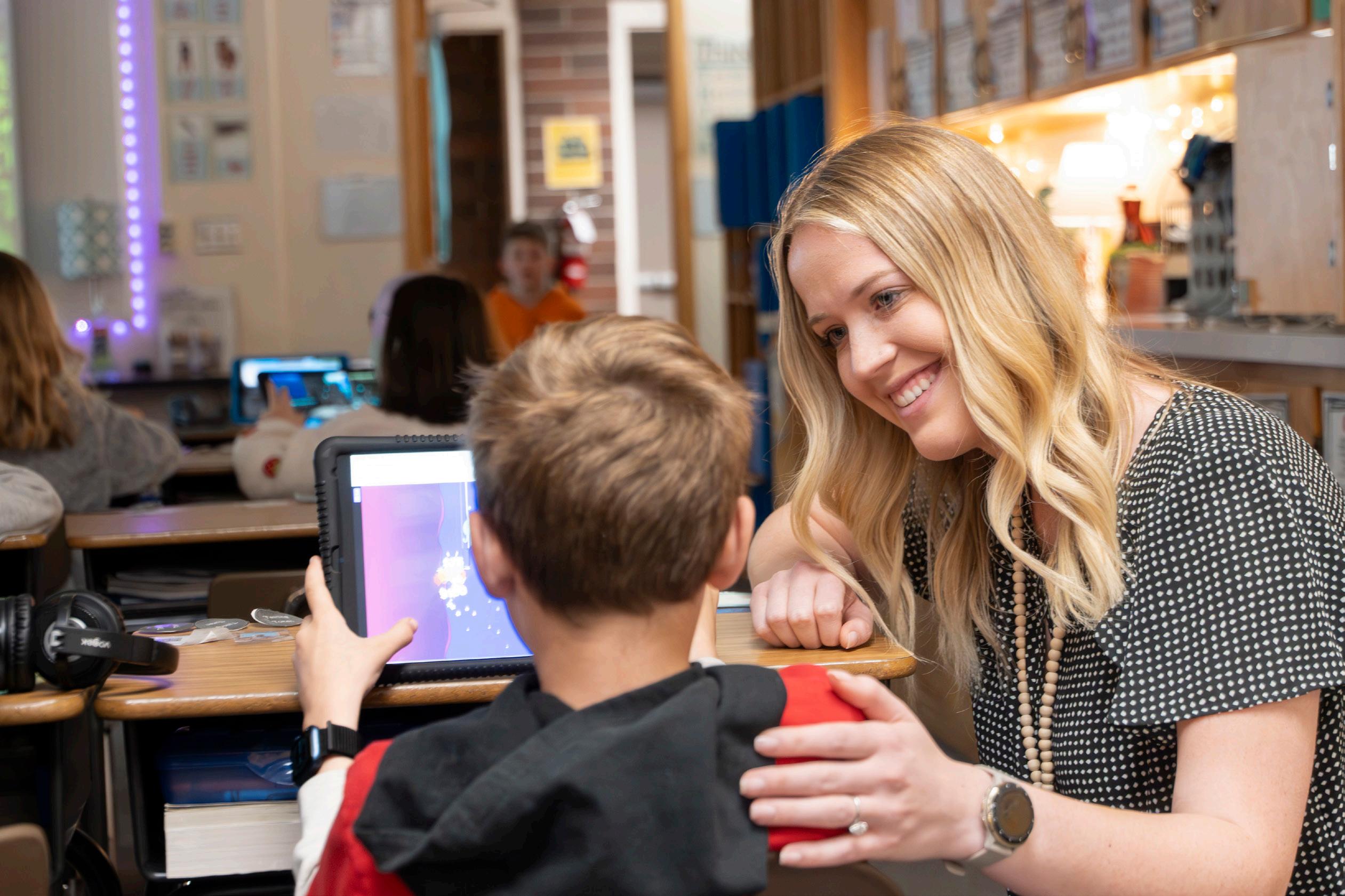
BUILDING BELONGING
Empowering the next generation of educators and learners
Story by Ralph Bartholdt
Photos by Melissa Hartley
For one semester last year, Emmerson Cox was a Panther.
On weekday mornings when the school bell rang, Cox, who earned her master’s degree at U of I’s College of Education, Health and Human Sciences in Spring 2025 while student teaching in Lewiston, recited the Orchards Elementary mission.
Members of Orchards Elementary “lead with integrity, love, empowerment, achievement and discipline,” she said in unison along with the rest of the school’s employees and students.
If the mantra became routine to many at the school, it stuck with Cox. Each day she reminded her homeroom students that they were intricate and important links in the school community.
“We need everybody to be with us, to learn together,” she would tell them.
As a student teacher, fostering a collaborative learning environment was among the strategies she adopted from her mentor, Idaho’s 2025 Teacher of the Year, Heidi Cornell, a longtime Orchards Elementary instructor.
Emmerson Cox ’25
“I’ve learned so much from Mrs. Cornell that I will take with me after graduation,” Cox said. She plans to teach in an elementary school classroom in Fall 2025, where she will use the wealth of information she garnered from being mentored by the best teacher in Idaho.
Although Cox spent two years in elementary and middle school classrooms in Moscow as part of her practicum while earning her degree, working closely with Cornell was transformative.
“She was so welcoming right from the beginning and took me under her wing,” Cox said about Cornell, who has taught in Lewiston since 2009. “I immediately saw why she is so successful in her profession.”
Cornell’s classroom is organized and inviting; it provides students with a soothing learning environment, a place where they feel they belong. Cornell’s student-centered approach gives learners the space they need to thrive and grow in their own individual ways, Cox said.
“For learning to take place, you need to know the students and build relationships with each one individually. That is something Mrs. Cornell instilled in me right from the beginning,” Cox said.
“She greets her students with hugs and high-fives as they come to class, and she checks in with each of them to see how they are doing; they might be upset, they may not have had breakfast, and she remedies that.”
Cox, who earned undergraduate degrees in criminology and psychology, said her plans to
be a probation officer fell by the wayside when she volunteered in a middle school classroom. An education course she completed as a non-degreeseeking student changed the trajectory of her future.
“I said, OK, this is what I want to do,” she said.
A professor in the College of Education, Health and Human Sciences helped her develop a study plan, and she was accepted into graduate school for the Master of Arts in teaching secondary education program with an elementary education endorsement.
Being chosen to student teach under Cornell was the high point of her studies, she said.
“I was in shock, but I knew I was going to gain a lot of valuable knowledge with her,” Cox said. “And I knew it would benefit the children I’ll be teaching in the future.”
Cornell, who regularly opens her classroom to student interns, was equally impressed with Cox.
“The professionalism Emmerson exudes is way beyond her years,” Cornell said. “She takes on challenges and solves them. One of Emmerson’s greatest strengths is her ability to reflect and absorb feedback. She’s a team player who readily jumps in to be a part of learning and creating, which is vital to what we do in our professional learning community.”
Until the last school bell at Orchards Elementary rang for the spring semester, Cox was Panther proud.
“I have really come to value the sense of community at Orchards Elementary and my mentors at University of Idaho,” she said. “I will forever be grateful for this experience.”
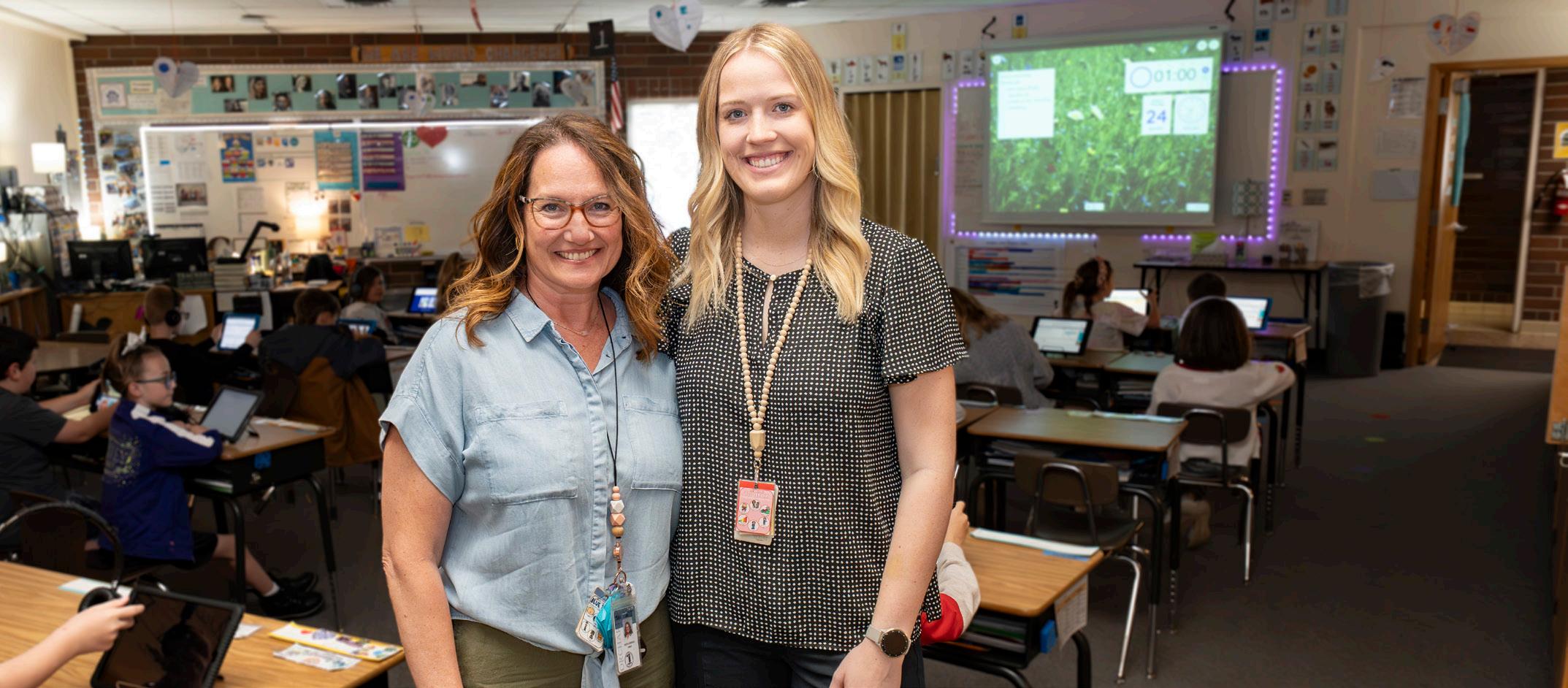
Emmerson Cox, right, earned a Master of Arts in teaching secondary education with an elementary education endorsement in Spring 2025 after completing a student teaching internship in the Lewiston Orchards classroom of Heidi Cornell, left, Idaho’s 2025 Teacher of the Year.
PREDICTING PATHOGEN PATTERNS
Student researcher pioneers AI use in tracking Valley Fever from weather data
Story and photos by Megan Snodgrass
University of Idaho Coeur d’Alene computer science student Leif Huender proves that real-world discovery isn’t reserved for seasoned scholars.
Huender’s undergraduate research reveals how airborne fungal diseases spread through weather patterns while pioneering the innovative use of artificial intelligence in outbreak prediction.
As wildfires intensify worldwide, researchers are exploring the behaviors and health effects of fires in new ways. Huender — a first-generation college student who is concurrently enrolled at U of I Coeur
d’Alene and North Idaho College — is part of a team developing AI-driven methods to predict disease outbreaks from wildfire smoke using long shortterm memory (LSTM) models.
LSTM models are a type of artificial intelligence that can remember important information over time and forget irrelevant details, making them good at predicting what comes next in sequences, like in text or weather patterns.
“Using LSTM models, we’ve made a big step forward in predicting future outcomes,” Huender said. “These models are exceptional at recognizing complex patterns over time, even with limited data.”
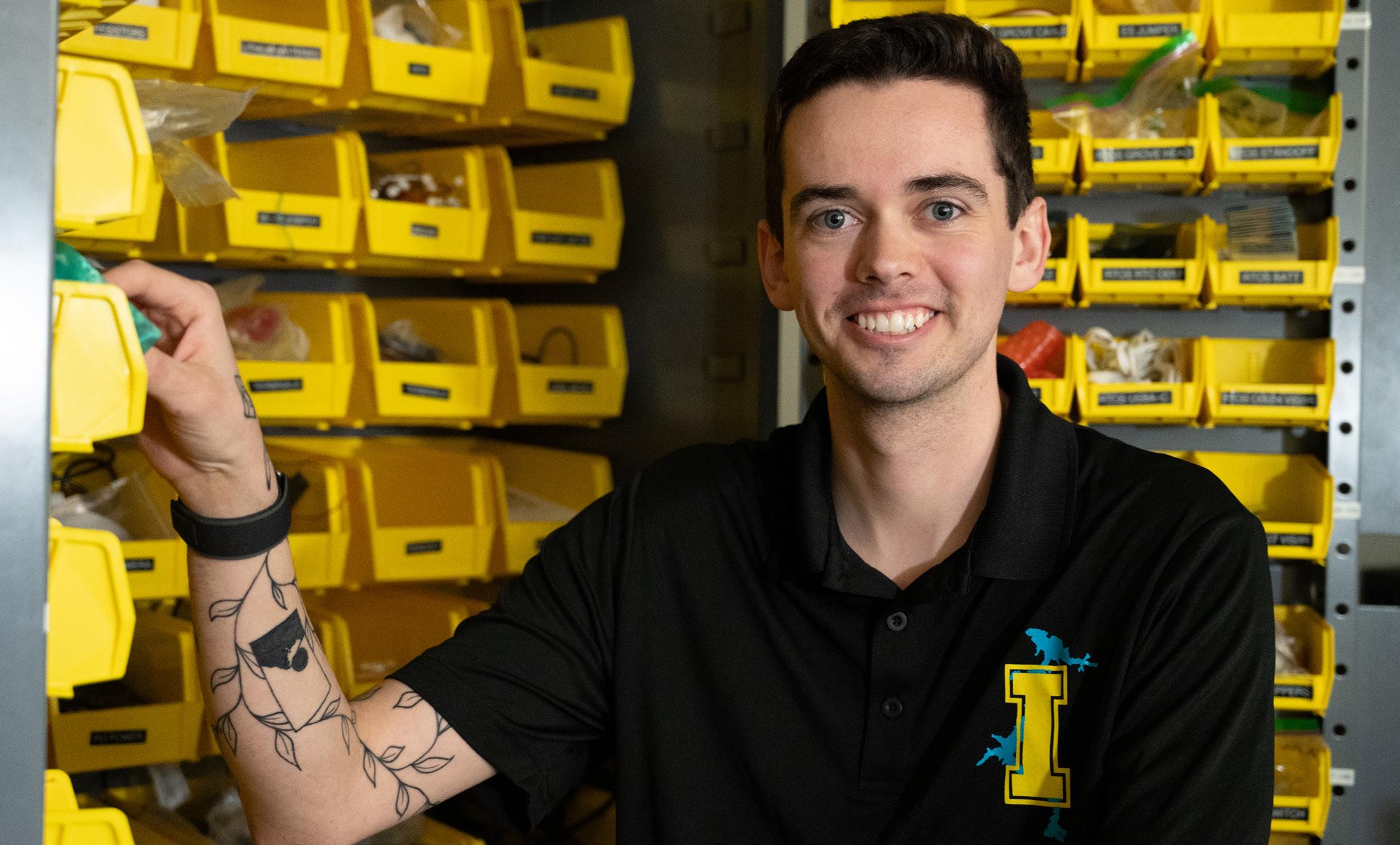
Leif Huender’s undergraduate research with U of I’s Center for Intelligent Industrial Robotics in Coeur d’Alene boosted outbreak prediction accuracy using AI.
Predicting Valley Fever
Valley Fever, a fungal disease common in the arid regions of California and Arizona, has long been linked to weather patterns, but predicting outbreaks has remained a challenge.
Huender’s research introduces a new AI-based approach to forecasting outbreaks.
With an IDeA Network of Biomedical Research Excellence fellowship, and working with Center for Intelligent Industrial Robotics Associate Director Mary Everett ’20, ’23, Huender developed AI methods predicting agricultural outcomes in microclimates with limited weather data. He presented this work at the International Society of Precision Agriculture in July 2024.
“I realized the same techniques we used to predict crop yields could be applied to forecasting disease outbreaks,” Huender said. “Both problems involve analyzing complex environmental data to make real-world predictions. The LSTM models that worked for agriculture proved equally valuable for forecasting Valley Fever outbreaks based on climate conditions.”
In Fall 2024, Huender expanded this research, analyzing two decades of meteorological data from 48 California counties. He fine-tuned hundreds of AI models to make predictions that significantly outperformed traditional statistical methods that are unable to detect complex patterns and connections in data.
“Not only did we improve predictive accuracy by 38%, but we also pioneered the use of this AI architecture in epidemiological research,” Huender said. “To my knowledge, our research is the first to apply extended LSTM models to Valley Fever prediction. This opens new doors for public health planning and disease prevention.”
This Valley Fever research was recently accepted for publication by the Journal of Biomedical Informatics — a milestone that Huender calls validating.
“Learning about machine learning techniques in class is one thing, but applying it to solve real problems and have that work recognized by the scientific community is another,” he said. “Being published and presenting at an international conference as an undergraduate confirms that meaningful contributions to science can come from anywhere.”
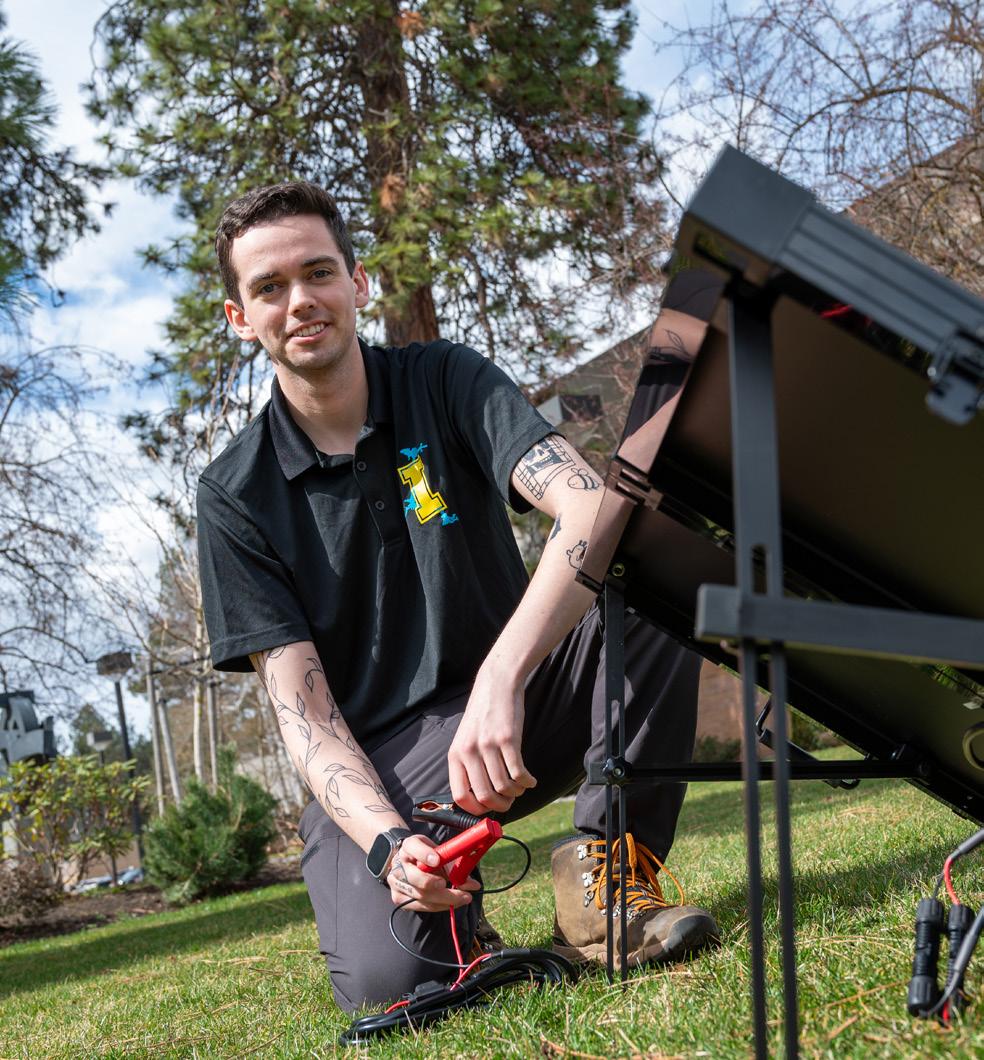
Changing the game
Huender’s research opportunities were gamechanging on a personal level, too. After dropping out of high school for academic and personal reasons, he worked in construction for several years before applying to North Idaho College in 2021. There, he was selected for the Bridges to Baccalaureate program, which identifies students with research potential and connects them with mentors.
Through the program, he met John Shovic, computer science professor and director of the Coeur d’Alenebased Center for Intelligent Industrial Robotics, who immediately saw Huender’s potential.
“My enthusiasm must have been obvious because he had me start lab work weeks before my official start date,” Huender said.
Shovic said Huender’s journey highlights what’s possible when students seize the opportunities before them.
“What stood out to me about Leif was his raw enthusiasm for the project,” Shovic said. “He came in so full of ideas that it was hard to keep up with him, and his success in undergraduate research and publications shows the impact of passion combined with opportunity.”
Huender is a first-generation college student.
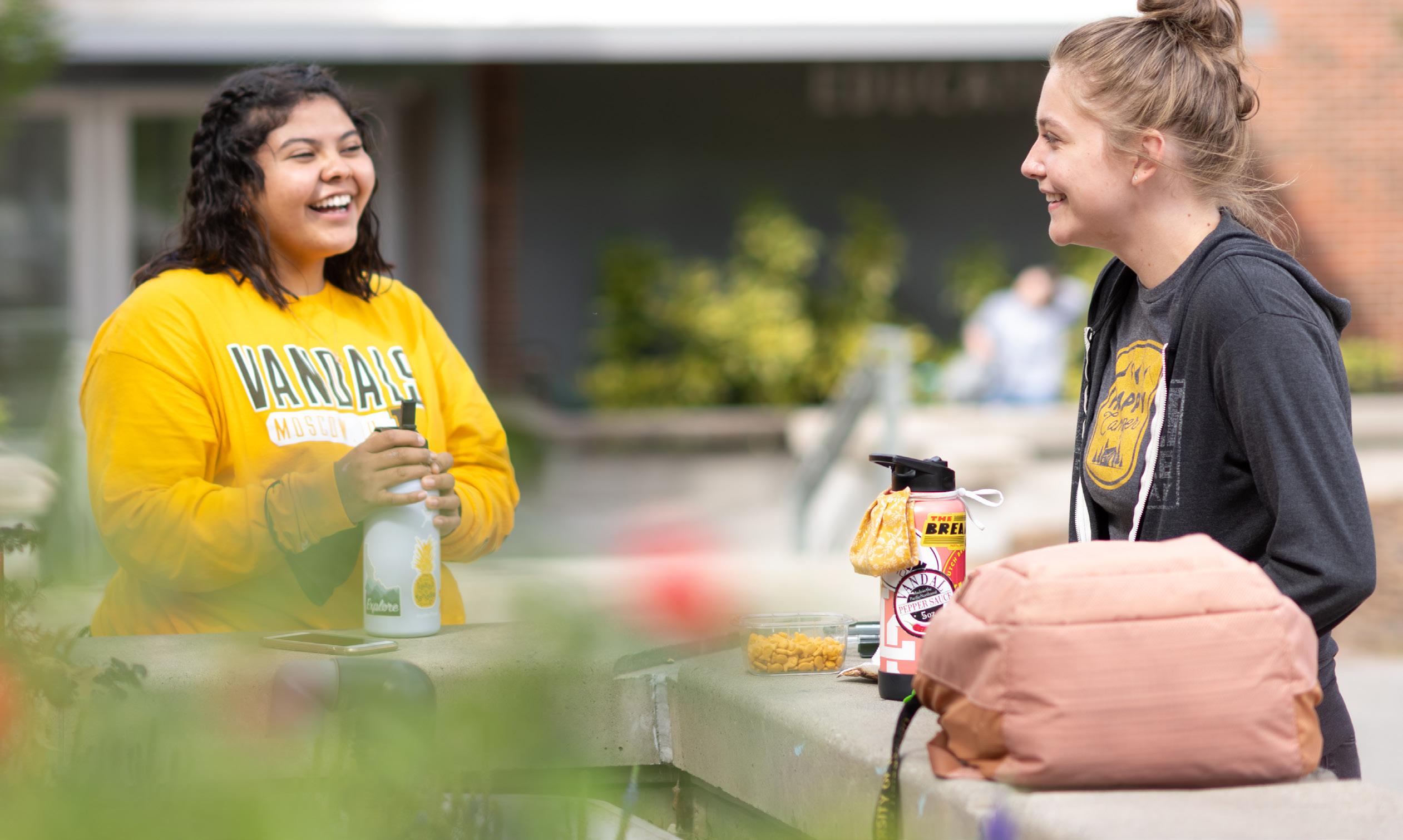
Six years ago, University of Idaho launched the most ambitious philanthropic campaign in Idaho history. The vision: Create more opportunities for families, communities and industries throughout Idaho to thrive.
Since then, the Vandal Family made history, setting new records for generosity and pushing the Brave. Bold. Unstoppable. campaign past the $500 million fundraising milestone — and we aren’t done yet.
Together, we will keep sparking positive change, driving innovation and forging ahead with unwavering momentum.
UNSTOPPABLE GENEROSITY
TRANSFORMS INSPIRATION INTO IMPACT
Student enrollment has grown every semester for four years, culminating in the largest enrollment in U of I history.
U of I is Idaho’s only Carnegie R1 research university, placing us among the top 4% of all U.S. higher education institutions.
$159 MILLION
For scholarships
So more students can enroll and thrive at U of I.
U of I is expanding its statewide impact through donor-funded facilities like Idaho CAFE, the Seed Potato Germplasm Lab, College of Law Boise, McCall Field Campus and more.
$250 MILLION
For research, faculty and academics
To tackle tough problems and deliver lasting solutions.
$109 MILLION
For facilities, campus enhancements and outreach
To meet students, families and industries where they are.
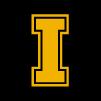
UNSTOPPABLE MOMENTUM
Behind the numbers, support from donors and organizations sparks powerful collaborations between students, educators, industry partners, communities and the university. This is just one example of the exponential impact of philanthropy for students, for Idaho and for the world.
VANDAL ATHLETICS FUELING STATION
For optimal performance in practice, competition and the classroom, student-athletes require much more energy than the average individual — as much as 5,000 calories per day — with an emphasis on lean protein, complex carbohydrates and plenty of hydration. Established in 2019, the Fueling Station provides healthy snacks and nutrition education to more than 300 Vandal student-athletes. Thanks to generous donors, industry and community partners, it is also a catalyst for experiential learning, lifelong skills-building, enriching collaborations and workforce development.
INDIVIDUAL GIVING
In 2020, a gift from Ashley and Mike Iupati ’10 — who retired from the NFL after 11 seasons — made possible the Fueling Station’s move to a larger, more functional space and established permanent support for its operations.
INDUSTRY PARTNERSHIPS
Since 2020, Dairy West has supported nutrition education, sports nutrition specialists, food prep supplies and high-quality dairy products to enhance athletic performance. In-kind donations of food are provided by Clif Bar, High Desert Milk and Glanbia.
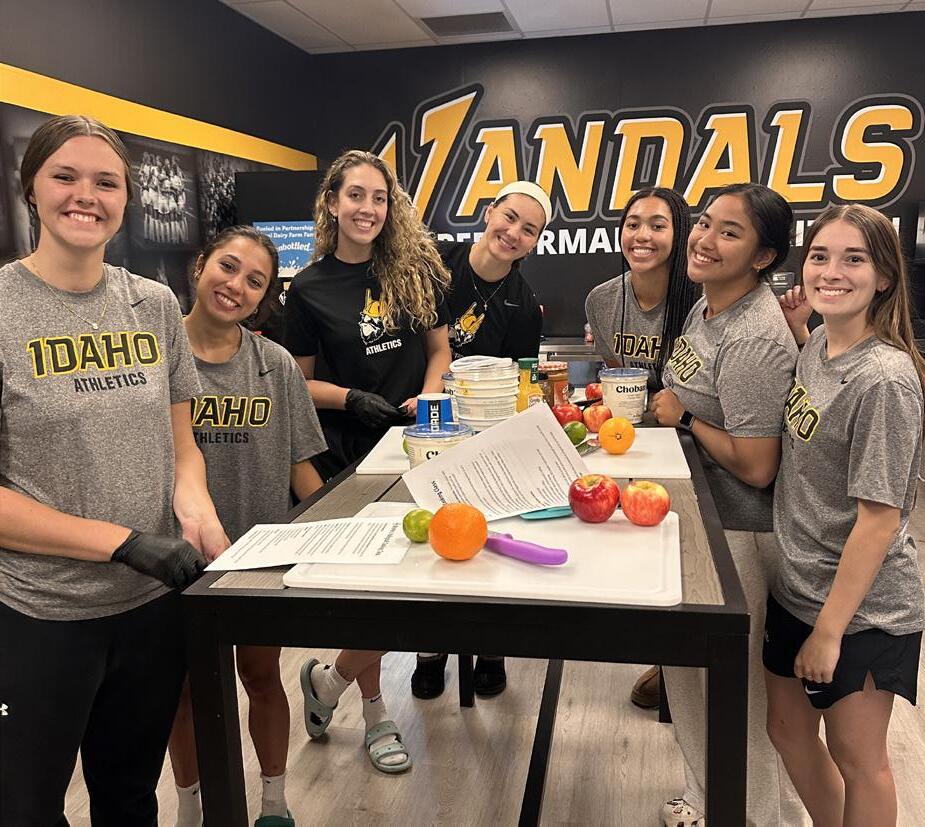
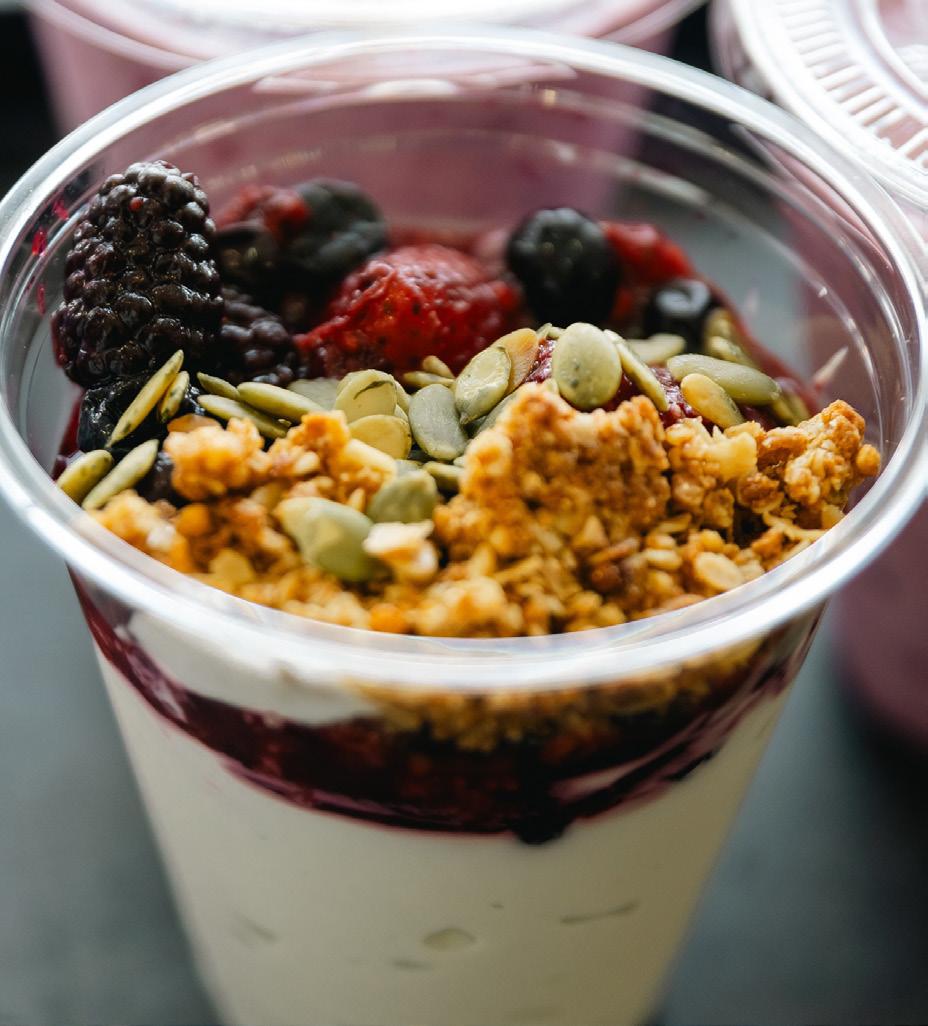
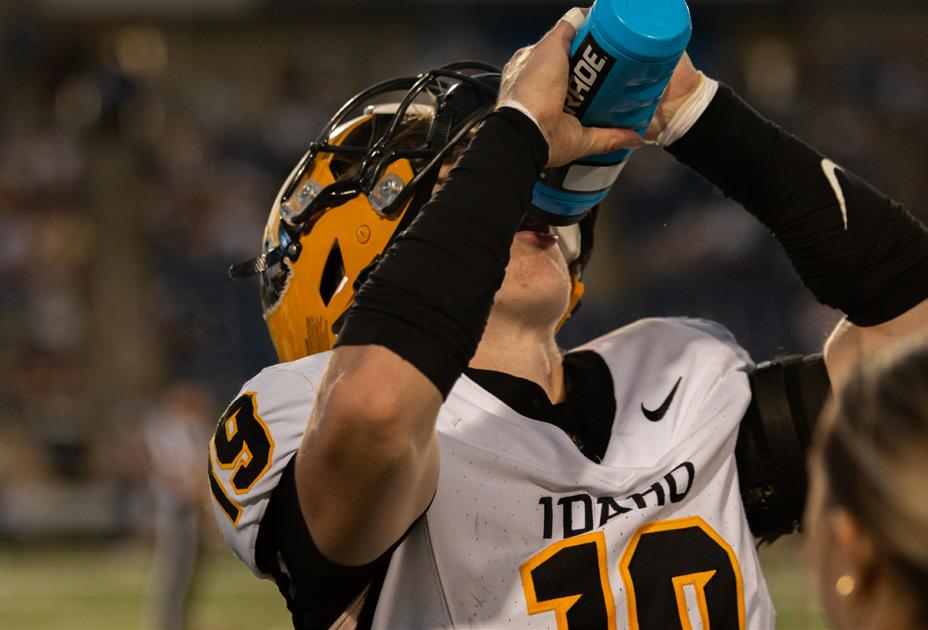
SCHOLARSHIP SUPPORT
Gifts to the Vandal Scholarship Fund remove financial barriers to ensure more student-athletes can focus on their studies, training, performance and health.
COMMUNITY ENGAGEMENT
The Moscow Food Co-op partners with the Fueling Station to promote healthy eating, offer a variety of nutritious foods for “Try it Tuesday” and collaborate on game-day meals tailored to the unique needs of student-athletes.
NUTRITION EDUCATION AND COUNSELING
All student-athletes have direct access to a full-time registered dietitian for ongoing nutrition education and personalized counseling to build lifelong healthy eating habits.
STUDENT EMPLOYMENT OPPORTUNITIES
Students in food and nutrition, dietetics, exercise science and related fields gain hands-on experience working at the Fueling Station.
WORKFORCE DEVELOPMENT
The Fueling Station accelerates professional development by offering internships, fellowships and mentoring that equip students for careers in sports nutrition and other fast-growing fields.
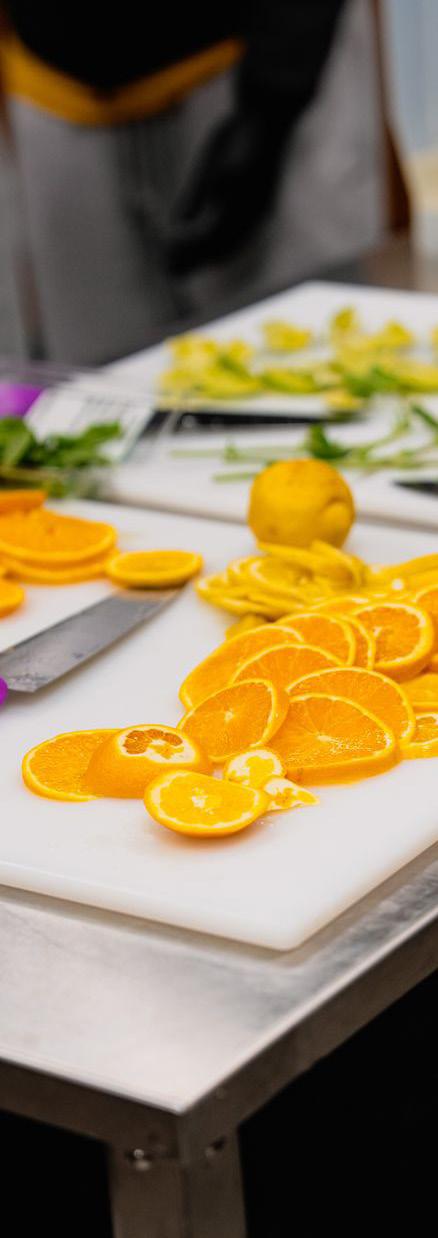
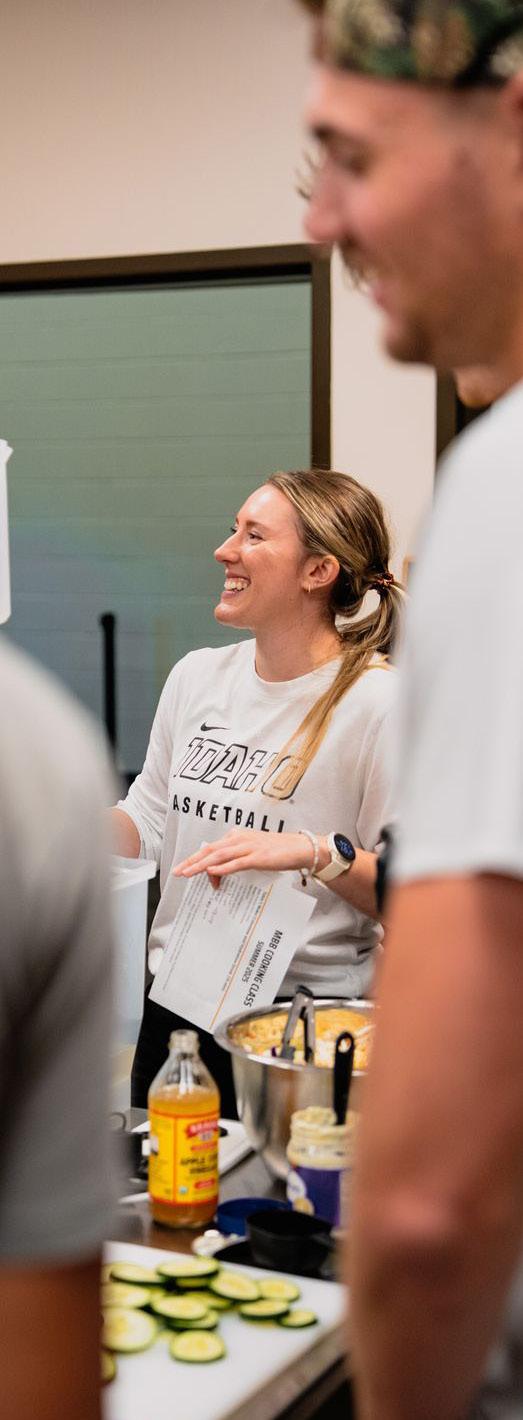
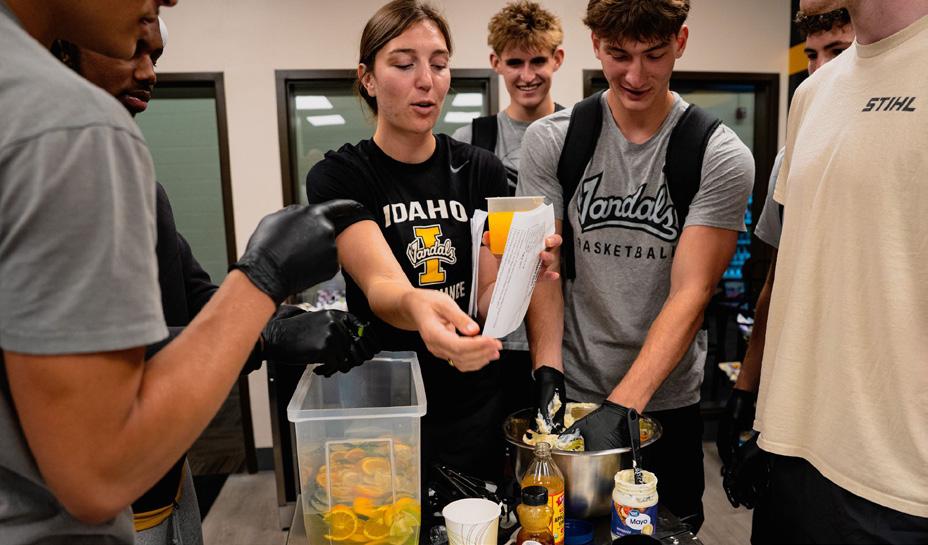
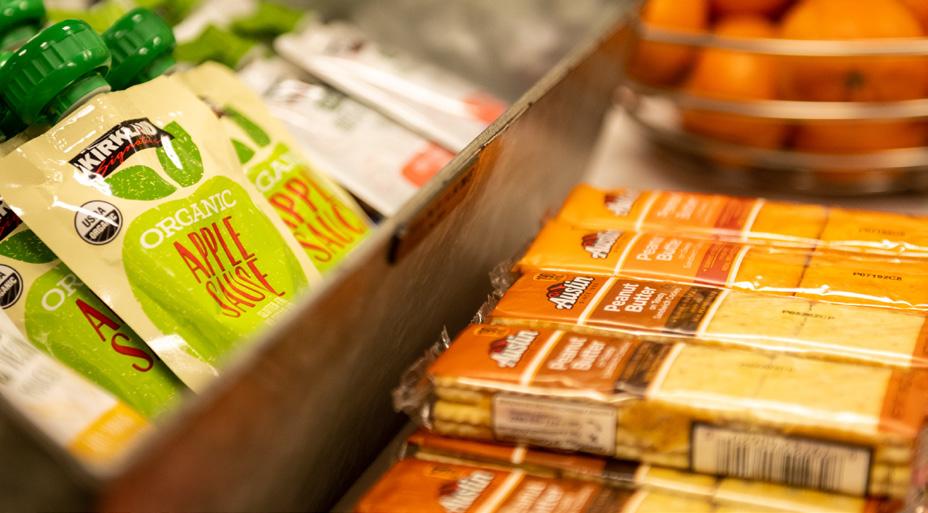
Photos by Richard Pathomsiri
A DOSE OF INNOVATION
Students design a smart pill dispenser that uses AI to reduce errors
Story by David Jackson ’93
Photos by Mark VanderSys, Pixel Light Creative Group
At age 10, Ismael Valadez managed his mother’s medications during her cancer treatment, ensuring she took the right pills at the right time. Unable to open the bottles herself because of weakness from radiation treatments, she needed full-time help.
Years later, college student Austen Reagan watched his girlfriend miss a dosage of her medication because she accidentally silenced her phone reminder.
Both saw a need for a better solution.
Now Alpha Kappa Lambda fraternity brothers at U of I, Valadez and Reagan developed Medi-Mate — an automatic medication dispenser that uses AI and facial recognition to deliver up to a month’s supply of eight medications at the correct time. It also connects to MyChart, an online medical chart that displays all prescribed medications.
“This is a real problem that a lot of people have,” said Reagan, a junior from Boise. “It’s something Ismael and I have both helped with. And I think it’s a problem we can help solve.”
Explaining the why
Valadez, from Nampa, persuaded Reagan to join him in the Startup Innovation and Ideation entrepreneurship class. A finance major, Reagan was intrigued by the idea of launching a startup.
Their concept began during a brainstorming session. While thinking about his girlfriend’s medication routine, Reagan suggested the idea — unaware of Valadez’s similar experience helping his mother.
They soon focused on how to build and pitch the product.
“When we talk about a product’s place in the market, I ask the students what they see out there that isn’t working and how can it be fixed,” said Lori Rock, marketing and communications manager
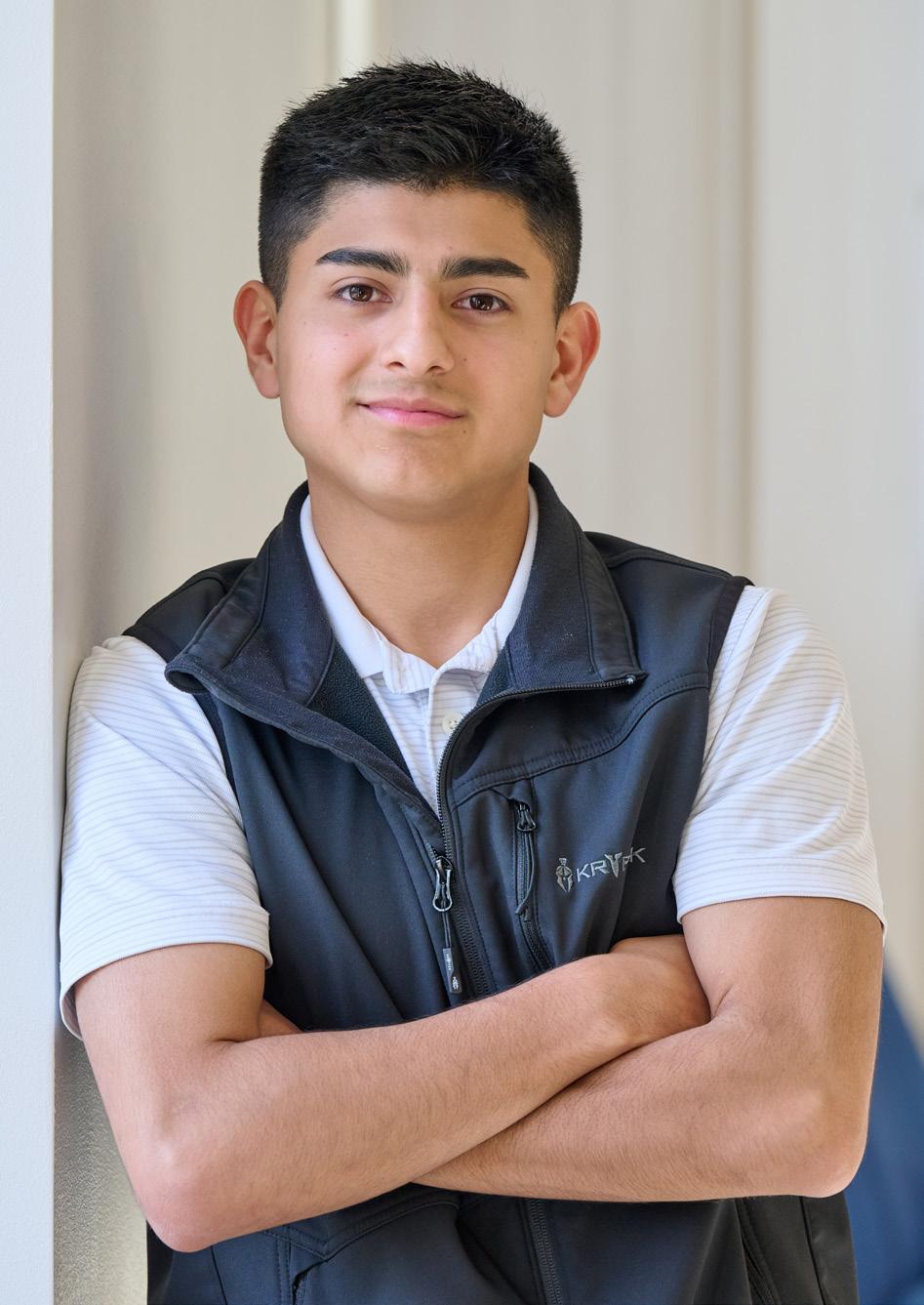
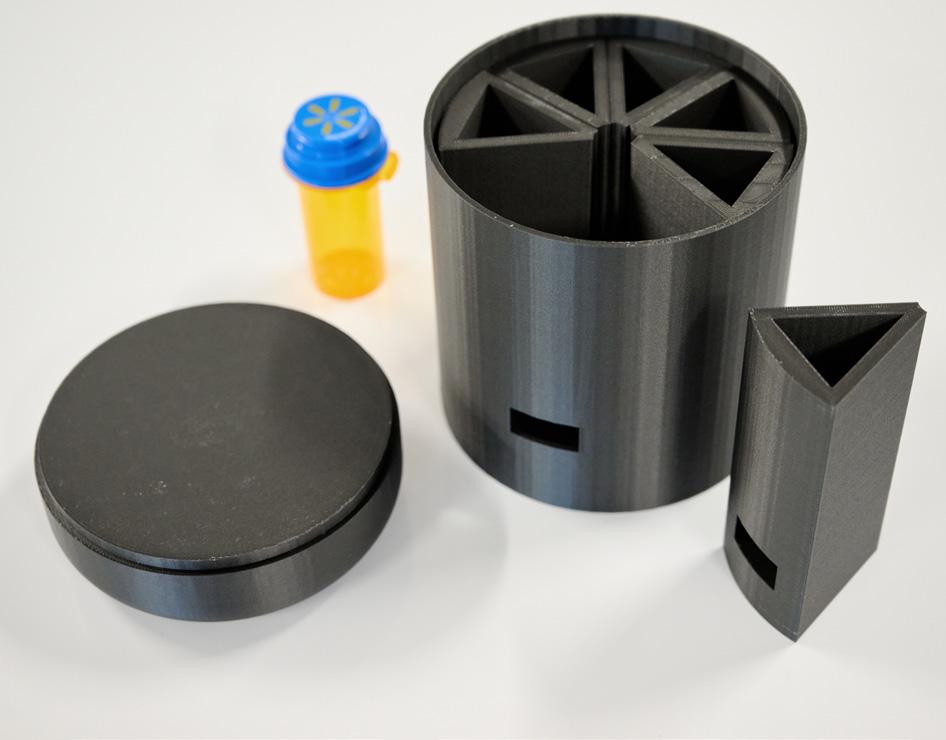
A 3D-printed prototype of Medi-Mate.
Ismael Valadez
for U of I’s College of Business and Economics (CBE) and instructor for the class. “Then we talk about creating a connection with customers by sharing a human element to the story — why their project is important to them.”
Though he was somewhat hesitant to share the story about his mother, Valadez soon realized it could strengthen their pitch.
“Talking about the situation with my mom wasn’t natural because we kept it mostly in the family,” said Valadez, a senior majoring in criminology and minoring in entrepreneurship. “I told close friends but didn’t really talk openly about it. But it makes sense to talk about it with your product because it gives you credibility. You aren’t just trying to invent something to sell it; you really are trying to help people.”
After sketching initial designs of their vision, they enlisted a fraternity brother to create a digital version. They then partnered with Ben Miller, a senior in biological engineering, who 3D printed a prototype for his class project.
Bringing it to life
With the prototype built, Valadez and Reagan turned their focus to selling it.
“Startup Innovation and Ideation is where students build out an idea,” said George Tanner, CBE senior instructor of entrepreneurship. “Entrepreneurship
is where we put a business model together to see if the idea makes sense.”
In Tanner’s class, the duo created feasibility studies, business plans and funding proposals to demonstrate market potential.
Medi-Mate reduces human error, but it also simplifies communication with providers through MyChart’s live chat, streamlining prescription management.
“It saves doctors and patients an office visit, and doctors feel like they are getting accurate information,” Valadez said. “It not only makes things easier for the patient, but it also saves time for the doctor, which addresses burnout in the medical profession.”
Over the past year, they pitched Medi-Mate to health care professionals at a show sponsored by Health Tech Idaho and at the Idaho Entrepreneur Challenge — events designed to connect entrepreneurs with potential investors.
They’ve also secured a partnership with a North Idaho engineering firm to manufacture the device once funding is in place.
Tanner emphasized that feedback at these events is as important to entrepreneurs as what they learn in class.
“Sometimes we think we’ve covered all our bases, but the reality is that market information tells us what we need to know,” he said.
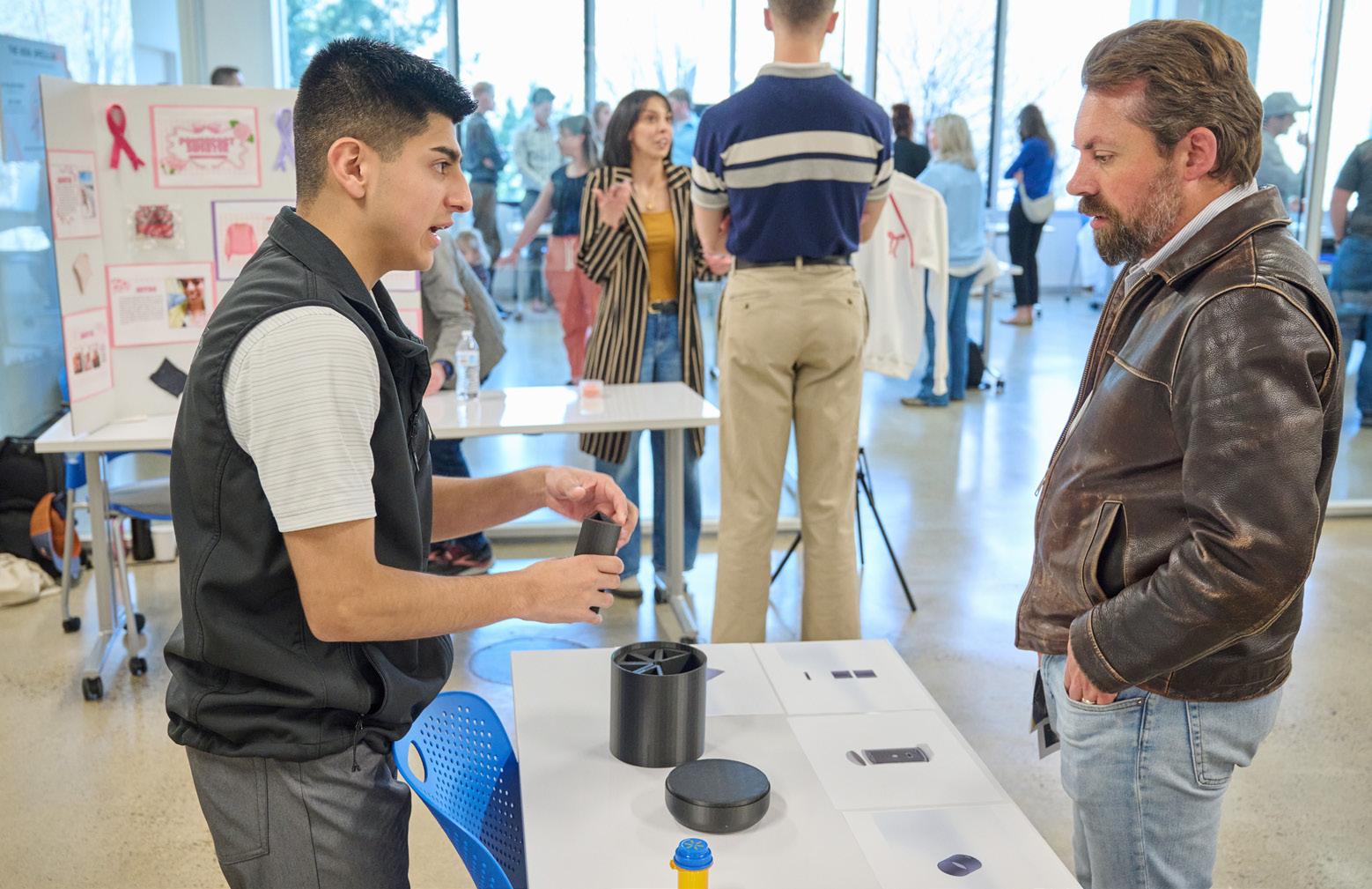
Now living in Nampa and interning with the local police department while finishing his U of I degree online, Valadez hopes Medi-Mate can help families like his own.
“Two of my older siblings were at U of I when she was first diagnosed, so here I was at 10 years old basically becoming a nurse, making sure mom got everything she needed to get better,” he said. “Not everyone who needs that level of help has access to around-the-clock care. This could help save lives.”
Ismael Valadez speaks to a participant at the Idaho Entrepreneur Challenge in Boise in April.
SHAPING IDAHO’S LANDSCAPE
For over 100 years, University of Idaho’s College of Natural Resources has driven economic growth and resource stewardship across the state. Its programs directly support Idaho’s timber, fisheries and recreation industries — sectors that generate billions in revenue and jobs. By training skilled workers, advancing research and partnering with industry, the college delivers practical solutions that strengthen Idaho’s economy and ensures the health of its forests, waters and rangelands. The college’s history is preserved in the U of I Special Collections and Archives.
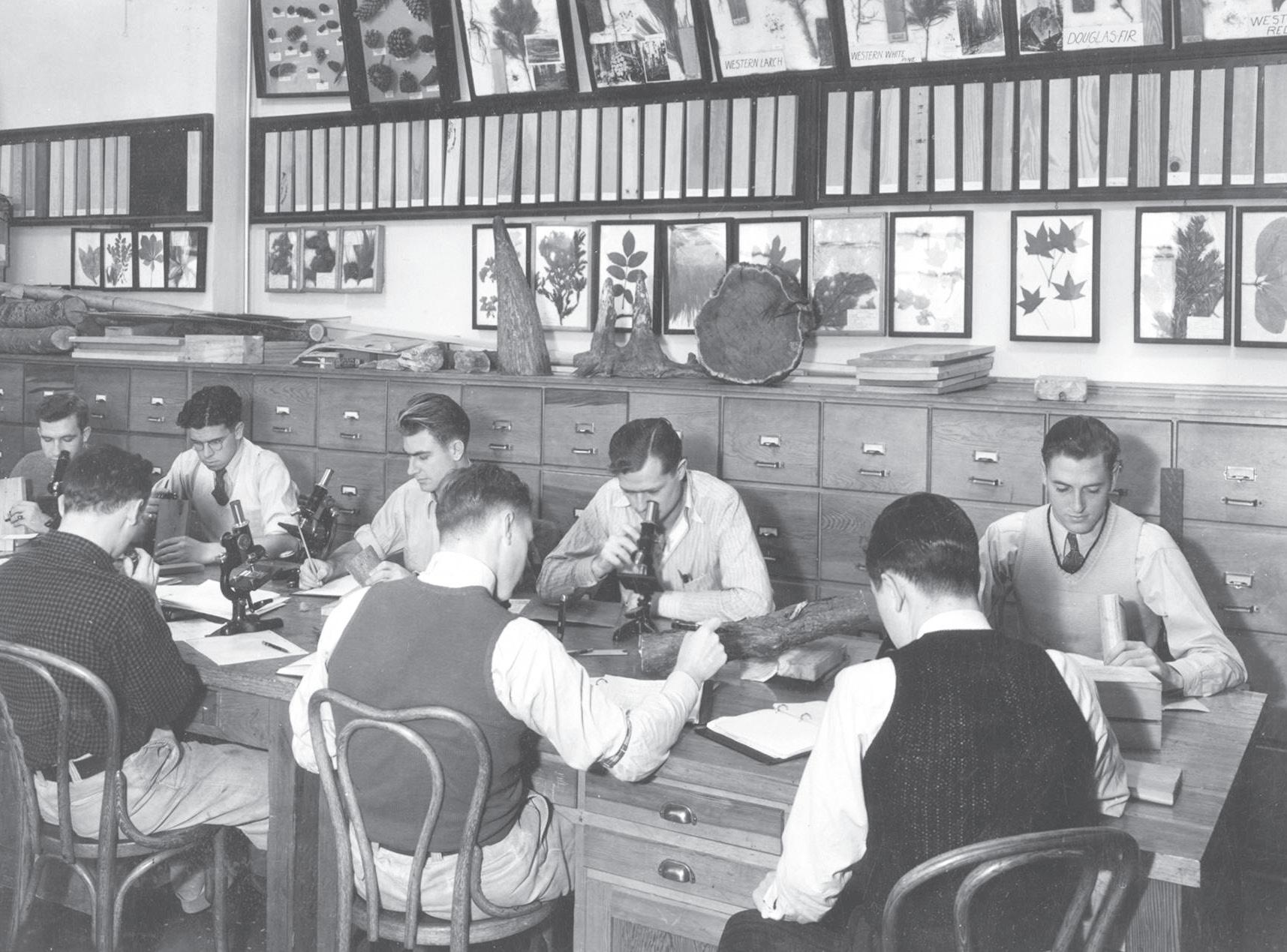
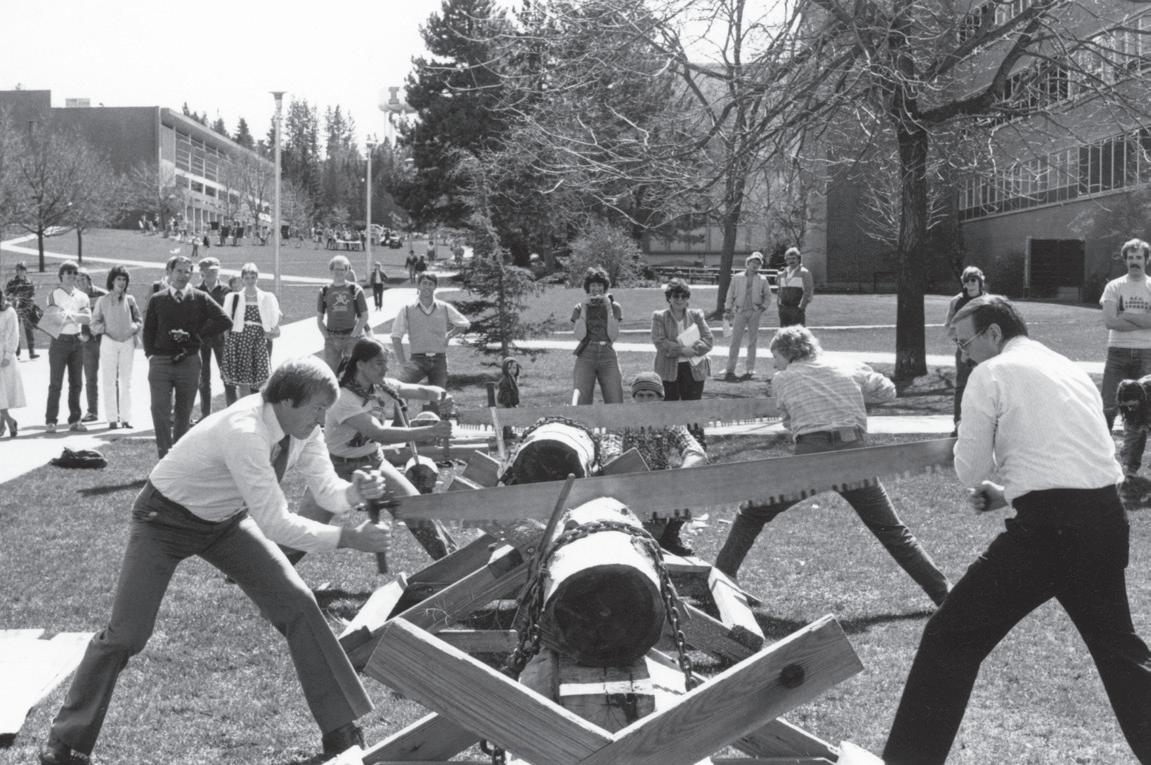
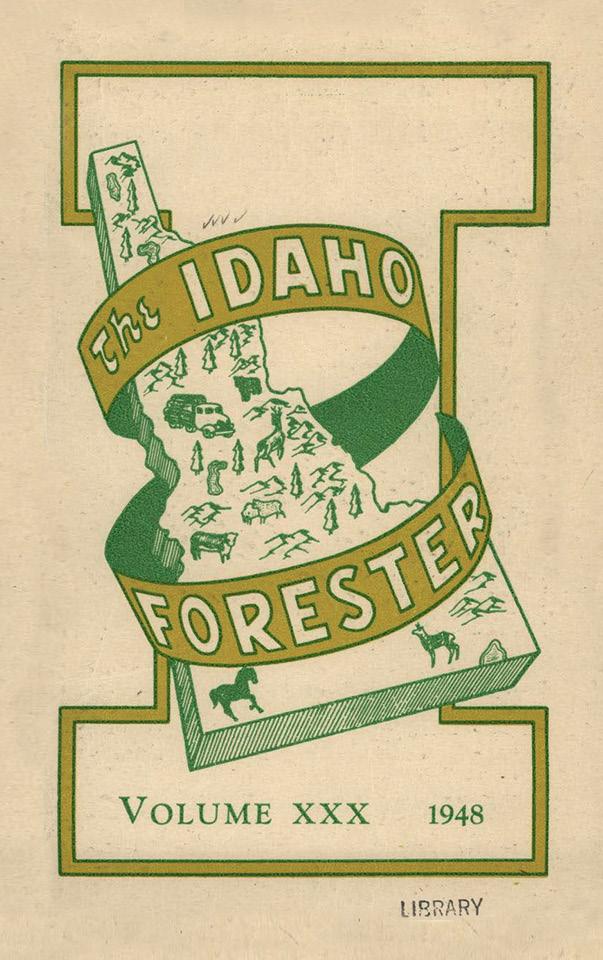
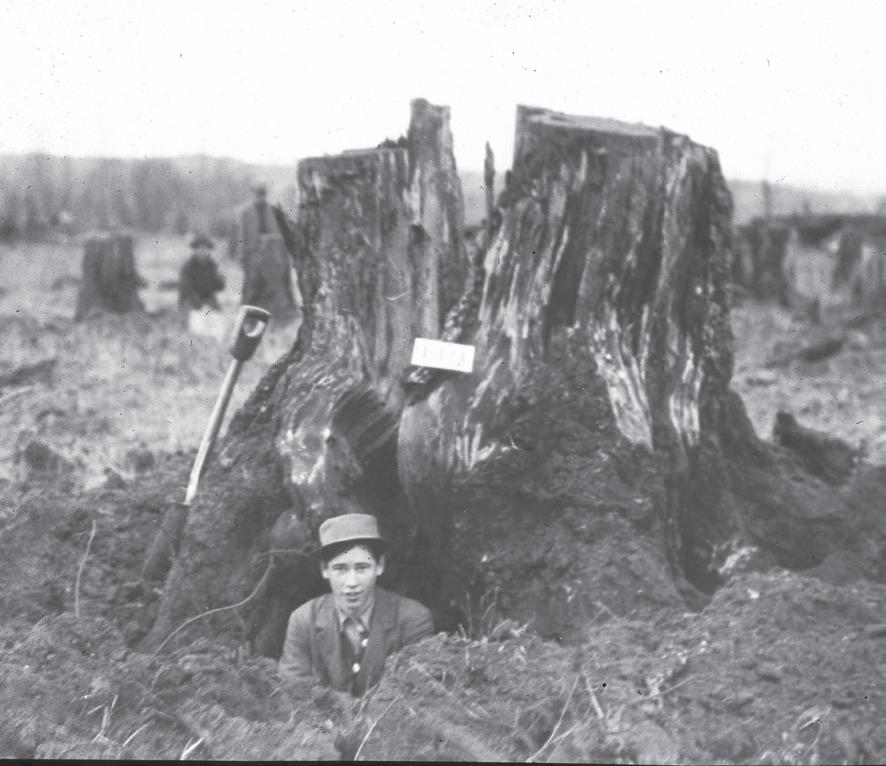
Dean John Ehrenreich, front right, with students and faculty members in the log sawing competition during Natural Resources Week, 1984.
Photograph of students in the Forestry Laboratory, 1932.
Images provided by U of I Library Special Collections and Archives
A lantern slide from Charles Houston Shattuck’s classroom collection illustrating a method for stump removal. The caption reads: “Stump in Fig. 19 after blast. Charge was too small.”
Cover of The Idaho Forester, 1948.
1909
U of I launches its Department of Forestry — only the second of its kind in the Western U.S. It begins in the College of Agriculture before moving to Letters and Sciences.
1917
The department becomes the School of Forestry, and students begin publishing The Idaho Forester, an annual magazine featuring department news, research highlights and industry analysis. Charles Houston Shattuck transforms a weedy slope on campus into a 12-acre arboretum with 12,000 trees representing 150 species. That same year, a 640-acre Experimental Forest is established near Moscow.
1924
The Experimental Forest serves as a training ground. Students learn logging safety, precision timber falling and winter harvesting techniques.
1939
U of I’s McCall Field Campus becomes home to the Forestry Summer Camp for undergraduates.
1963
The school evolves into the College of Forestry, Wildlife and Range Sciences. It expands to include new departments and trained professionals in biology, surveying, firefighting and more.
1970
Taylor Wilderness Research Station is established.
1989
Idaho legislators create the Policy Analysis Group at U of I to deliver scientific, unbiased data on land and resource use to both public agencies and private businesses.
1997
The final issue of Idaho Forester is published.
2000
The college adopts a new name: the College of Natural Resources (CNR), reflecting its broader mission.
2001
The McCall Outdoor Science School is established at the McCall Field Campus on the shores of Payette Lake.
2022
CNR introduces associate degrees in forest operations, nursery management and wildland fire technology to help meet workforce needs in Idaho’s $3 billion forest products industry.
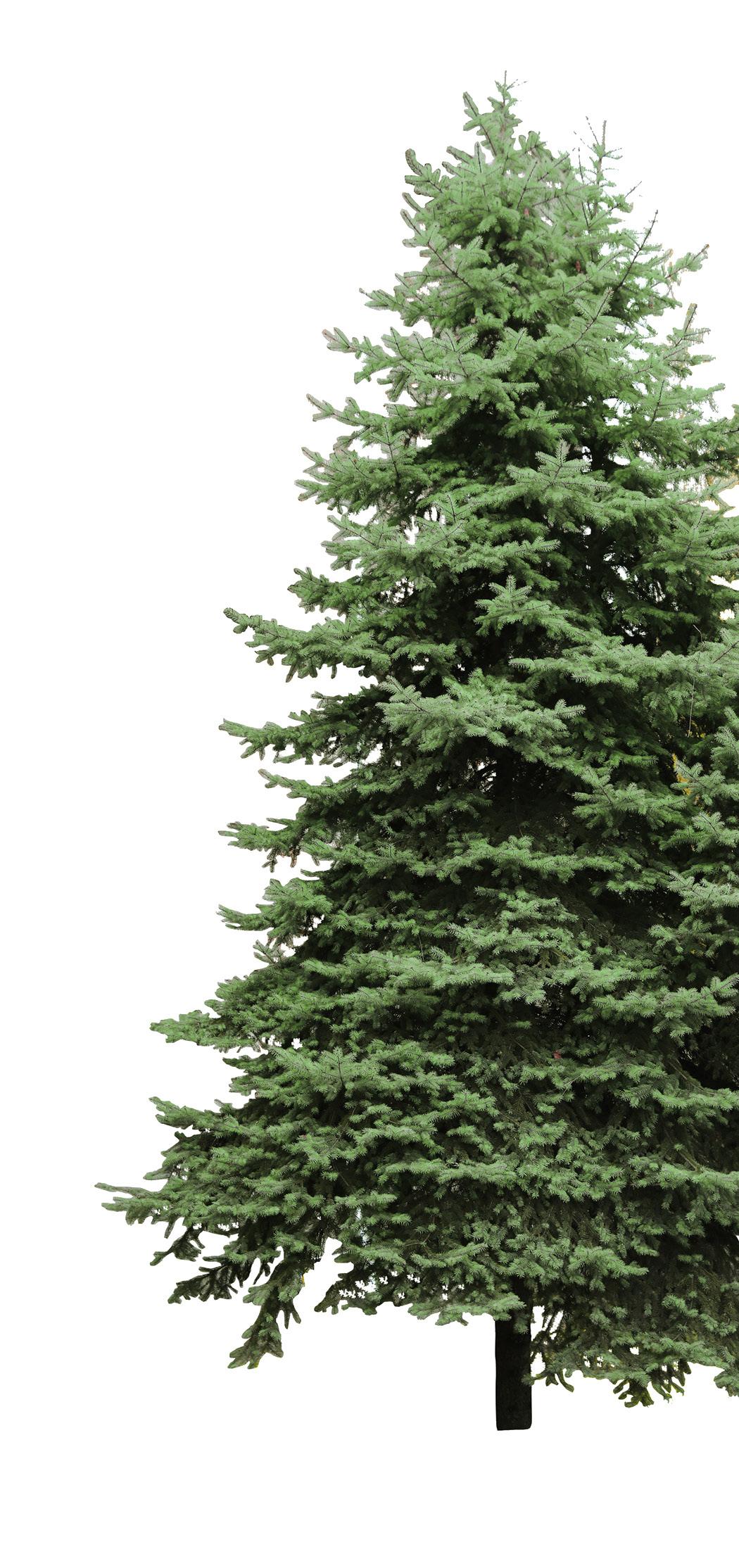
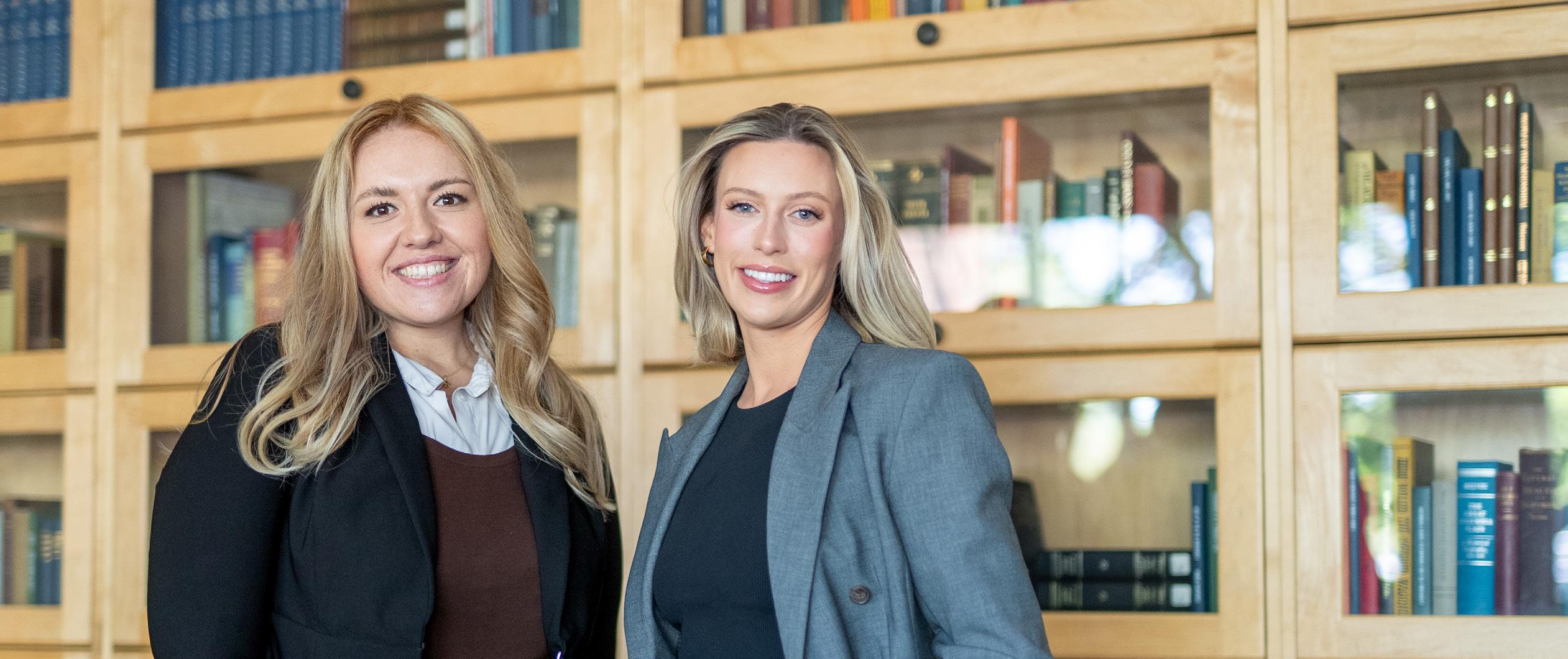
CULTIVATING JUSTICE
Driven by service, law students expand free legal support for Idaho veterans
Story by Ralph Bartholdt
Photos by Garrett Britton
In the early 1900s, residents of Ephrata, Washington, began lobbying neighbors and the government for a project using water from the Columbia River to irrigate fertile soils to produce bumper wheat crops.
Thus began the Grand Coulee Dam project, which continues to support regional agriculture and generate power for the Pacific Northwest.
Payton Schooler-Polillo, a third-year law student who grew up in Ephrata, said being raised in the shadow of the Columbia River project showed her how commitment to goals can lead to great achievements.
As a Vandal earning a juris doctor in Moscow, she has cultivated her own irrigation project that redirects resources for meaningful returns.
Drawing on her background as a veteran of the Armed Forces, the former president of the Idaho Veteran Law Association (IVLA) pools assets from the legal community and University of Idaho College of Law to help those who served navigate legal challenges. She also lobbies Idaho’s congressional delegation on behalf of veterans.
Schooler-Polillo’s efforts, and those of fellow IVLA students, have taken root. Under her leadership, the association grew from five students to 60 members, including law students and pro bono attorney volunteers. Since 2023, when she took the reins, more than 200 veterans from across the region have attended IVLA clinics held four times a year to provide free legal advice and support.
“It has been an extraordinary feeling to see this organization grow and flourish,” said Schooler-Polillo, who spent five years in the U.S. Air Force before attending law school. “The program is no longer in its infancy. It’s now in its blossoming stage.”
Schooler-Polillo first encountered the legal system as a young woman with limited resources seeking to hire a divorce attorney. A firm composed of women attorneys took her case and allowed her to pay off legal fees by working at the law office.
She moved to Lewiston to attend Lewis-Clark State College, earned a business degree and paid her tuition while working at a Lewiston law firm.
“I learned a lot about the profession in those years by completing a lot of legal tasks, and I really came to enjoy it,” she said.
She joined the Air Force with the goal of becoming a legal professional, intending to use the GI Bill to pay for law school. After five years stationed in
Law students Brianna Royzen, left, and Payton Schooler-Polillo want to see IVLA clinics expand throughout North and Central Idaho.
places like Qatar and elsewhere in the Middle East, Schooler-Polillo left the Air Force as a staff sergeant and enrolled at the U of I College of Law.
“I never considered enrolling anywhere but the U of I College of Law,” she said. “My husband was born and raised in Lewiston, and it felt more like home to me than central Washington ever had. As a wife and mother, I knew that I wanted to raise my family in Idaho and wanted to continue to nurture the roots I had planted here.”
Her life so far reflects two priorities: mentoring young women pursuing law and serving veterans, which brought her to IVLA.
“I’m pretty passionate about helping our veterans,” she said. “I know what many of them have sacrificed, and I feel this is another way to serve our veteran community.”
When Schooler-Polillo joined IVLA, it had only a handful of volunteers. She quickly earned support from fellow students and regional attorneys, growing the membership to dozens of volunteers who help organize, publicize and provide services at clinics in Moscow and Lewiston.
Second-year law student Brianna Royzen volunteered to show appreciation for service members.
“When you meet the veterans and their families, you get a small glimpse into their lives and sacrifices, and you cannot help but feel honored to help such wonderful and giving people,” she said.
Royzen, who was born into a military family on Joint Base Andrews near Washington, D.C., said growing up on bases surrounded by people who devoted at least a part of their lives to serving their country gave her a foundation of duty she still leans on today.
“I owe much of my success to the rigors of that upbringing. I’m grateful for the time around
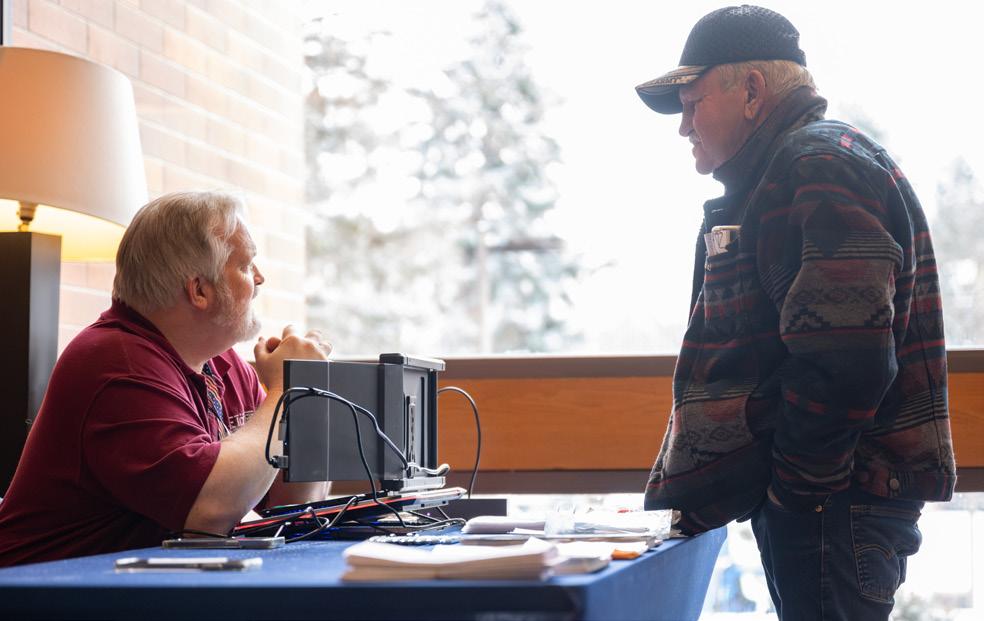
service members and all I learned in that environment,” she said.
Royzen chose Idaho Law to pursue her dream of becoming an attorney because of its generous benefits package, scholarships and academic strengths in areas like economics. The university also supported her with a year of remote study through a pre-law online program.
“U of I took a second look at me as a person, instead of a GPA and LSAT score, and engaged with me about my dreams for my career and how to get there,” she said.
She spent part of Summer 2025 studying abroad in Florence, Italy, where she won the International Mediation Competition.
“University of Idaho supports amazing programs and employs wonderful professors that make these incredible opportunities possible,” Royzen said.
Both Royzen and Schooler-Polillo — along with latest association president Christian Face, an Army ROTC member and third-year law student — anticipate expanding the association’s outreach south to central Idaho. The group plans to launch its first mobile outreach legal aid clinic for veterans in rural areas such as Grangeville this fall.
“My journey from a small town in central Washington to law school at University of Idaho has felt much like the irrigation project that gave rise to my hometown — slow and steady work that, once flowing, nourishes everything it touches,” Schooler-Polillo said. “The College of Law has been the water source I needed to grow — personally, professionally and in service to others. Through supportive faculty, hands-on clinics and a mission that values community, U of I helped me bring my goals to fruition. I hope it continues to do the same for future students who want to serve, to advocate and to give back.”
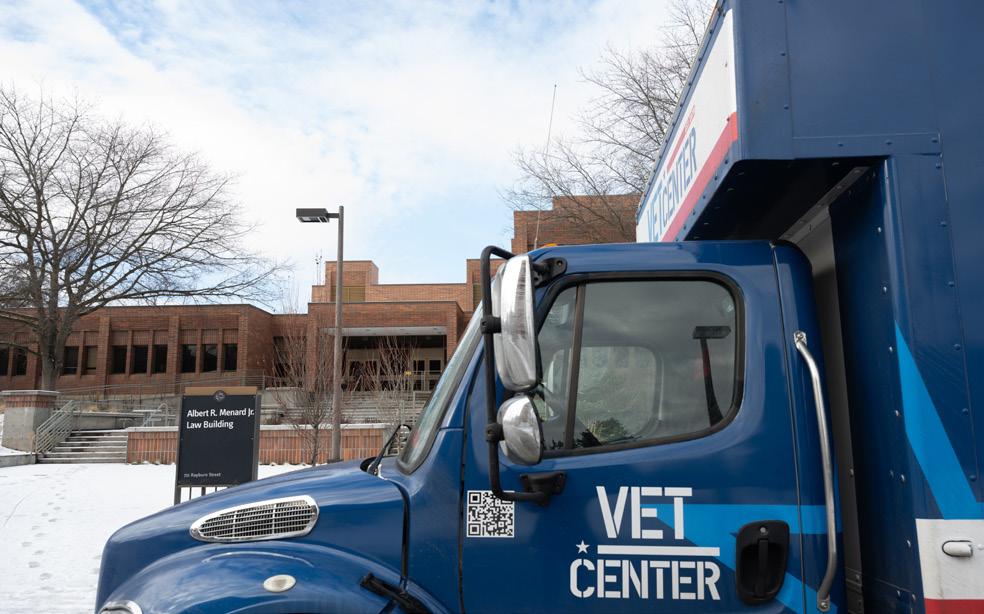
The Spokane Vet Center is a regular participant at IVLA clinics.
A Spokane Vet Center representative connects with a guest at U of I’s community clinic supporting area veterans.
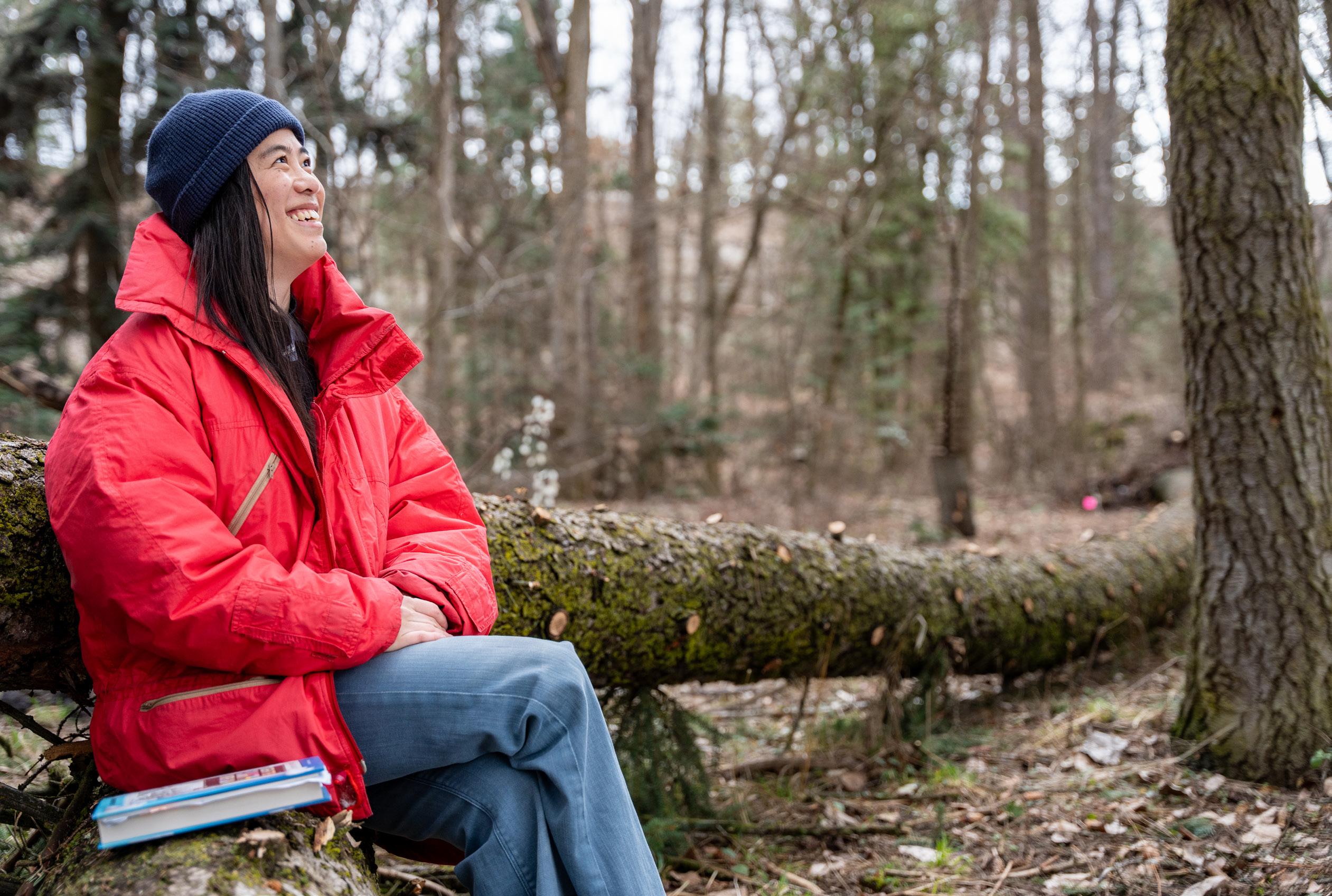
BURNING FOR THE STORY
MFA student uses firsthand fire training to fuel climate-focused fiction
Story by David Jackson ’93
Photos by Garrett Britton and Jennifer Yu
Participating in a prescribed burn was counterintuitive to Master of Fine Arts in creative writing student Jennifer Yu.
Although she knew it was a good idea to experience the sights, sounds and smells of wildfire for a future novel, she is, at heart, an environmentalist. Nevertheless, in October 2024, Yu spent two weeks outside Chewelah, Washington, slowly walking along tree lines and igniting tall grass with a drip torch.
“To write about situations involving fire, you need a holistic understanding so you can really describe it,” said Yu, who is in her final year of the three-year program at University of Idaho. “Being able to show what it feels like to be that close to fire — to describe the physical experience of being in the middle of a fire — that’s what I want the reader to feel.”
Yu participated in the burn, administered by prescribed fire training company TREX, as part of the Stories of Fire project sponsored by the Confluence Lab, a College of Letters, Arts and Social Sciences initiative that uses research in arts, humanities and the sciences to discuss environmental issues impacting rural communities.
MFA in creative writing student Jennifer Yu.
Stories of Fire was funded through a grant from the Mellon Foundation.
Suffering for art
Originally from the East Coast, Yu earned her undergraduate degree at University of Pennsylvania before heading west in search of new landscapes and perspectives. Drawn to U of I’s interdisciplinary MFA program and its emphasis on environmental humanities, she found what she was looking for with the opportunity to work with the Confluence Lab and learn from English professors such as Erin James, Jennifer Ladino and Leah Hampton.
“I was interested in engaging more deeply with topics like the environment, climate, Western landscapes and history in my writing,” Yu said.
Already the published author of three novels, Yu believes in getting outside and soaking in what nature has to offer — even if that means pushing herself beyond her comfort zone.
Training for the prescribed burn provided plenty of those moments.
“I’ve always liked to hike, camp and be outdoors, but this was something different,” she said. “We needed to hike 3 miles in 45 minutes with a 50-pound pack, wearing all our gear. It was physically challenging but added to the experience.”
Yu and the crew ignited controlled burns using drip torches — a tool that drips flaming fuel to start fires — then watched as firefighters extinguished them, using the moment to reflect on their thoughts and feelings.
“Fire evokes deep human emotions of fascination, but also of fear,” said Kylie Mohr, who worked
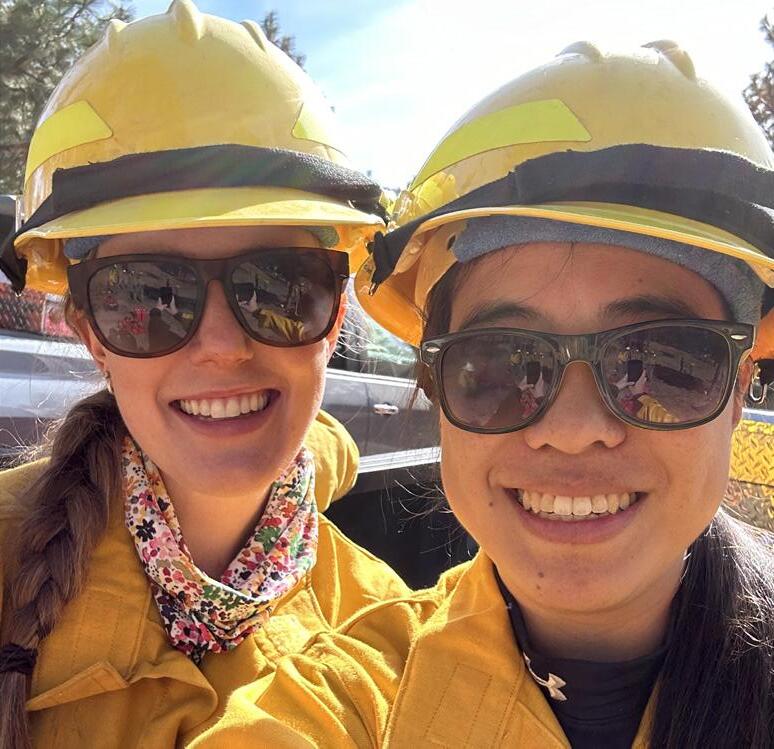
alongside Yu while writing about the experience of participating in a prescribed burn as a correspondent for High Country News magazine. “It’s important for writers to add emotion and firsthand experience to their stories.”
The experience taught Yu that fire can be a powerful, positive tool — not just a destructive force.
“It took being here and seeing everything in front of me to really understand that,” she said. Mohr agreed.
“The first time I used a drip torch, I freaked out,” Mohr said. “But by understanding fire’s behavior, I became less afraid of it. Truly understanding environmental topics requires getting your hands dirty.”
Art meets science
The Confluence Lab chose 10 participants for Stories of Fire from over 100 mostly seasoned artists from across the Pacific Northwest. Despite being one of the youngest and least experienced, Yu stood out.
“She blew our socks off,” James said. “She’s an incredible, deeply curious writer. Her focus on young adult fiction felt perfect for this project.”
After all 10 participants have participated in a burn, James anticipates displaying their resulting works in an online gallery.
“Being interested in the environment, in emotional humanities and in science narratives, I can see writing a climate-based fictional story,” Yu said. “Learning about fire and about how it can actually help the environment was a very rewarding experience.”
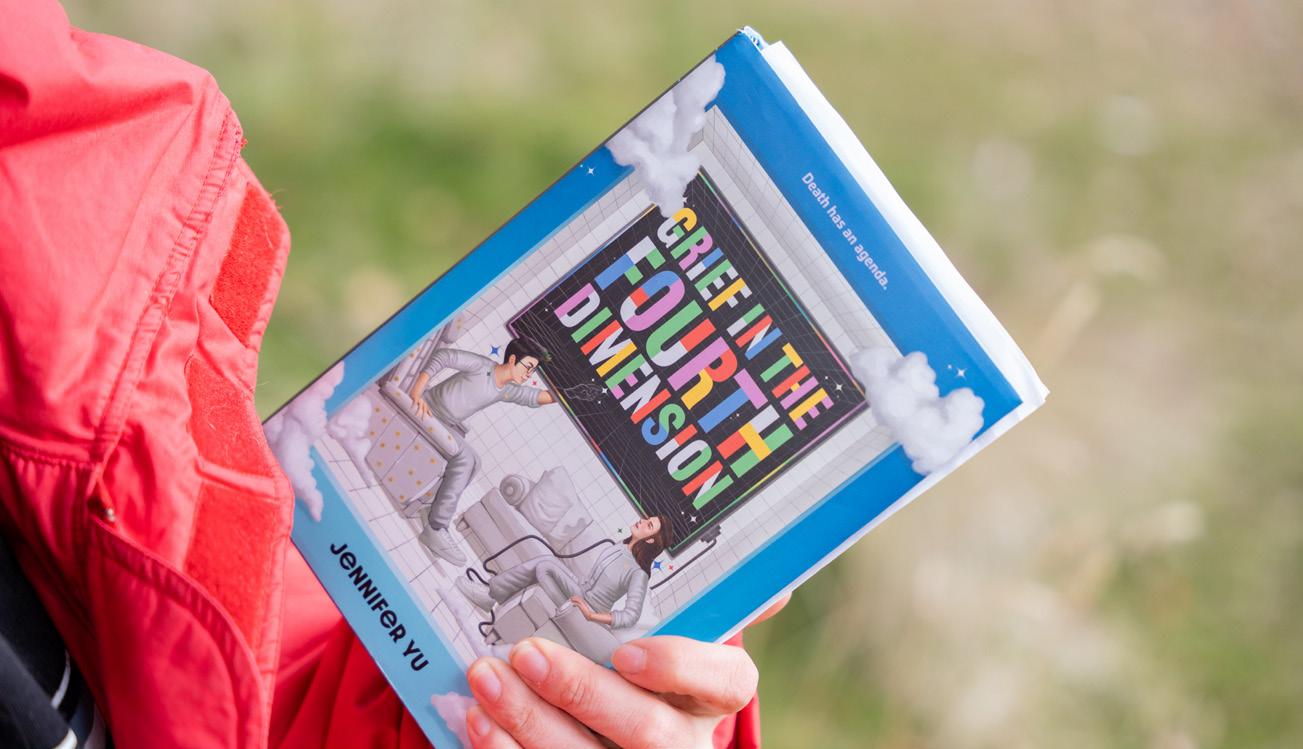
Kylie Mohr (left) and Jennifer Yu.
Jennifer Yu is the author of three novels, including “Grief in the Fourth Dimension.”
CLASS NOTES
1940s
Eloise “Lois” Deobald Legg ’46 turned 100 on May 14, 2025.
1960s
Darlene Dougherty ’65 received the 2025 Lifetime Achievement Award from the Academy of Nutrition and Dietetics.
Robert F. Wall ’69 has been named conductor-musical director of the Clear Lake Symphony in Houston, Texas.
1970s
Mike Hanna ’77 received the 2025 Don G. Mackenzie Award from the Intermountain Logging Conference board of directors.
1980s
Dave Huotari ’83 was elected to the UI Foundation board of directors and appointed chair of the College of Art and Architecture advisory board.
1990s
U of I congratulates these Vandals on their achievements.
Katie (Cooke) Elliott ’98 was named the general manager of University of Idaho Vandal Sports Properties.
2000s
Robert J. West ’03 was selected as prairie supervisor, Midewin National Tallgrass Prairie, U.S. Forest Service.
Kristen (Berberick) Gilman ’04 was promoted to deputy chief counsel of Civil Enforcement at the Oregon Department of Justice.
2010s
Alina Beynun ’11 obtained a Master of Applied Science degree in marine biodiversity and conservation from Scripps Institution of Oceanography - UC San Diego.
Lauren Hamilton ’11 was named executive director of the Downtown Boise Association.
Sam Koester ’14 joined Washington State University as a regional admissions counselor in Northern California.
Jim Koester ’14, ’19 started a new position as a commercial loan officer at North Bay Credit Union in California.
KC Hovda ’15 was elected to the board of directors of TruGrocer Federal Credit Union.
SIGN UP FOR THE ONLINE MAGAZINE
IN MEMORIAM
U of I extends its condolences to the family and friends of our departed Vandals.
IN MEMORIAM
Philip G. Engstrom ’58, ’74, Lake Oswego, WA, April 3, 2025
Arnold J. “Nik” Nikula ’60 , Paradise Valley, AZ, July 27, 2025
Florence Mendiola Pierce ’60 , Buhl, Nov. 6, 2024
Warren S. Watts ’60, Clarkston, WA, March 4, 2025
Gary Mahn ’65, Boise, May 24, 2025
Robert “Butch” Pierce ’67, Buhl, Sept. 26, 2024
Dayaldas Tanumal “Dayal”
Meshri ’68, Tulsa, OK, May 25, 2025
James Mitch Lowe ’75, Beaverton, OR, Feb. 11, 2023
James W. Clark ’89, Washington City, UT, June 3, 2024
FACULTY/STAFF
David Giese Jr., Moscow, May 2, 2025
Stacy Isenbarger, Moscow, Aug. 4, 2025
STUDENTS
John “Jack” Wimer, Sagle, May 26, 2025
Chandler Harris , Hayden, July 16, 2025
Tyson Randall, Richland, WA, Sept. 3, 2025
Online subscriptions are more sustainable. They reduce the environmental impact of printing, transportation and disposal of paper products. Email advserv@uidaho.edu to opt out of the print edition and get the online magazine delivered to your email. Read it online at uidaho.edu/ui/current-hwhi-magazine.
FUTURE VANDALS

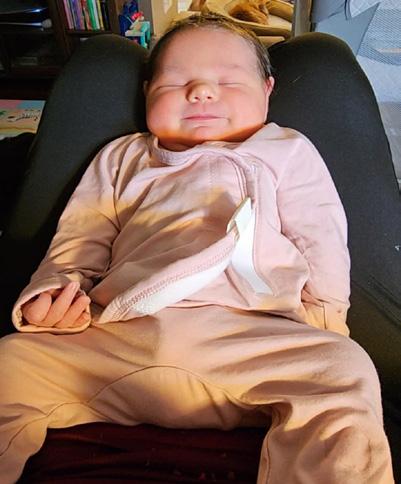
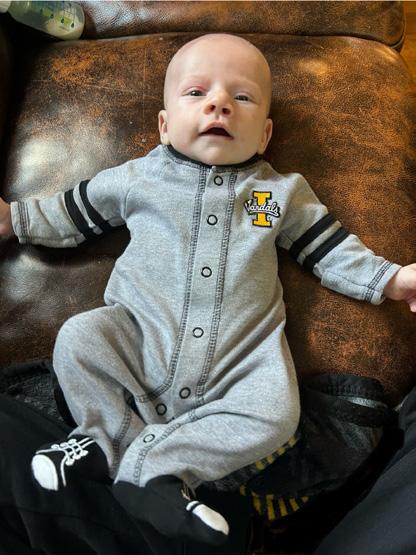
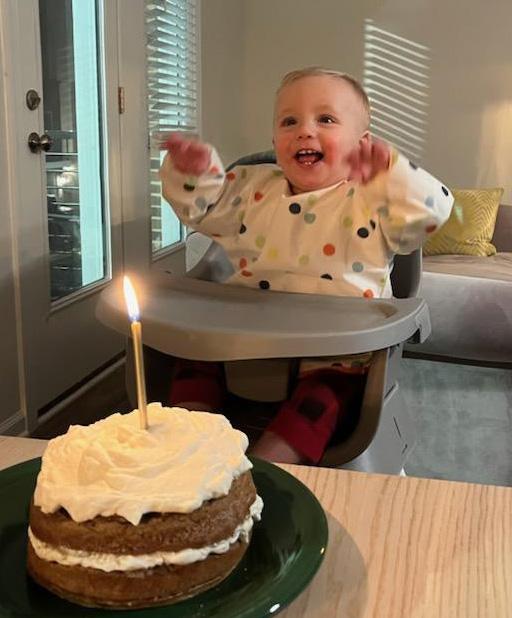
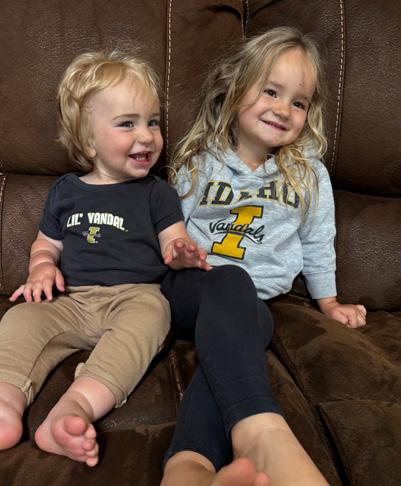
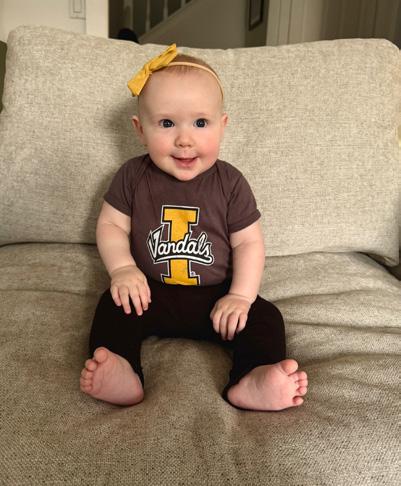

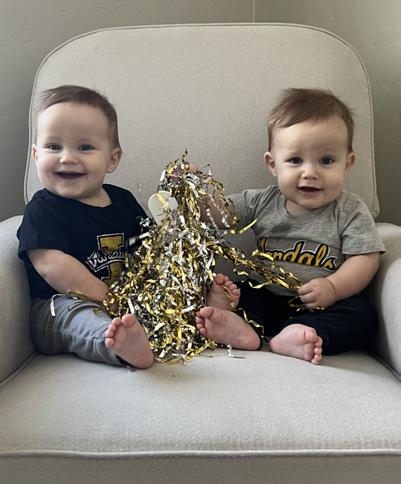
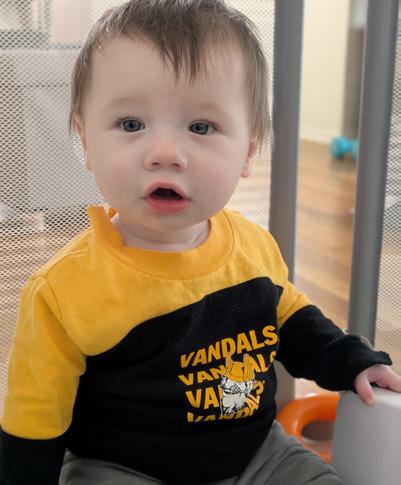
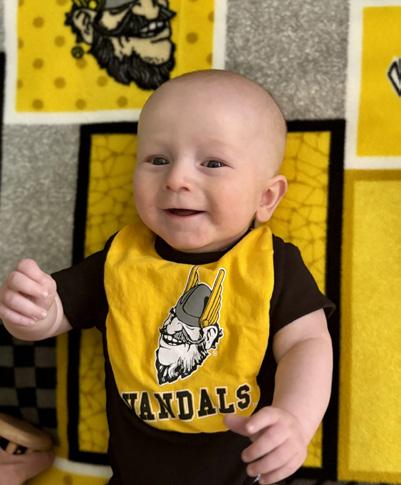
1. Alberto Jose Garcia Baeza, son of Sandra Baeza Nunez ’16 and Alberto Garcia Ruiz ’16
2. Madden Michael Bertram, son of Jenna Gardiner ’22 and Ben Bertram ’22
3. Everett Parker and Sadie Judith Cushman, children of Thomas Michael ’11 and Kaitlyn E. (Pond) Cushman ’10
4. Harper Guimond, daughter of Michael and Miranda (Shultz) Guimond ’14
5. Taylor Grace Hajda, daughter of Luke and Courtney (Sell) Hajda ’17
6. Brooklyn Alice Horton, daughter of Samuel Horton ’14 and Kristin (Burkhalter) Horton
7. Quinten Michael Knaub, son of Sarah (Grigg) Knaub ’12 and Maj. Sean Knaub USMC
8. Riggs Aaron and Reed Allen Lucas, sons of Marcus and Chloe (Wilson) Lucas ’16, grandsons of Kevin Roach ’85
9. Robert McGreevy, son of Theresa Vawter and Ben McGreevy ’11
10. Kallen Emmett Stark, son of Kurtis ’13 and Kari (Rucker) Stark ’13

MARRIAGES

Luke Tesnohlidek ’20 to Chance Lee ’21 June 14, 2025
University of Idaho wishes these Vandal newlyweds lots of love and happiness.

Joe Viehweg ’20 to Sarah Mosman ’19 June 28, 2025
To be featured in Class Notes:
Submit your news at uidaho.edu/alumni/servicebenefits/class-notes. You can also email your information, including your graduation year, to alumni@uidaho.edu, or via regular mail to Class Notes, Alumni Relations, 875 Perimeter Drive, MS 3232, Moscow, ID 83843-3232
Please limit your submission to fewer than 50 words.

